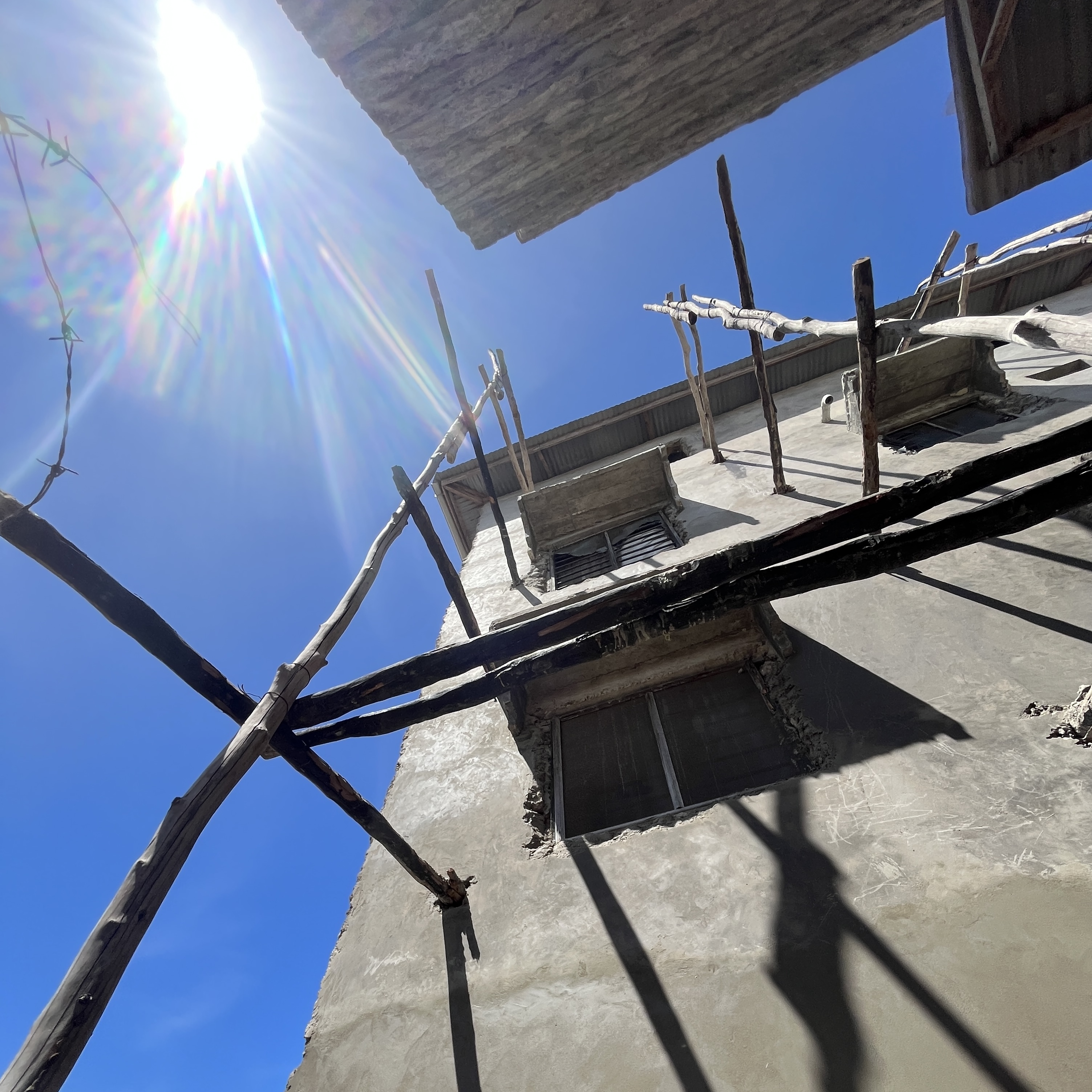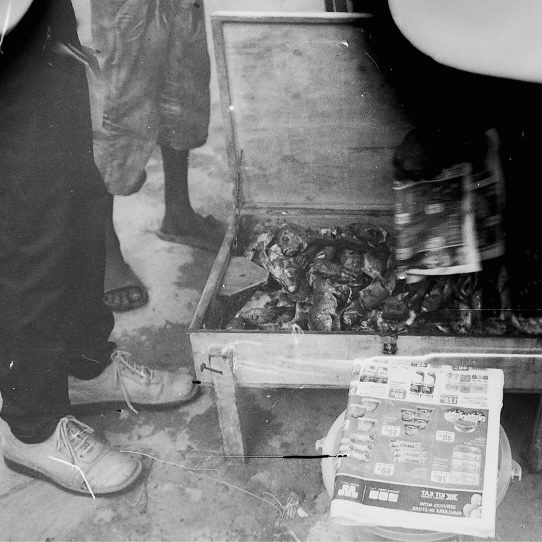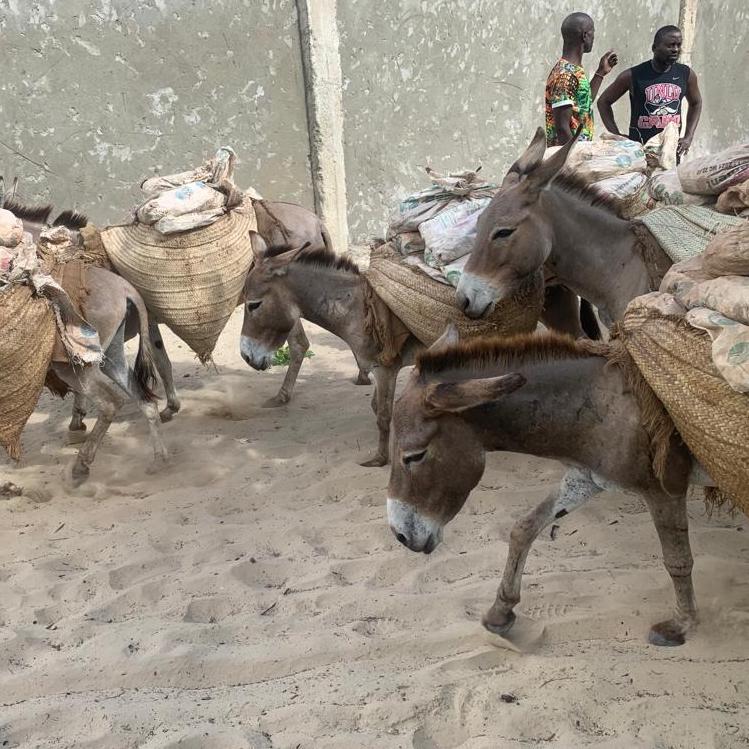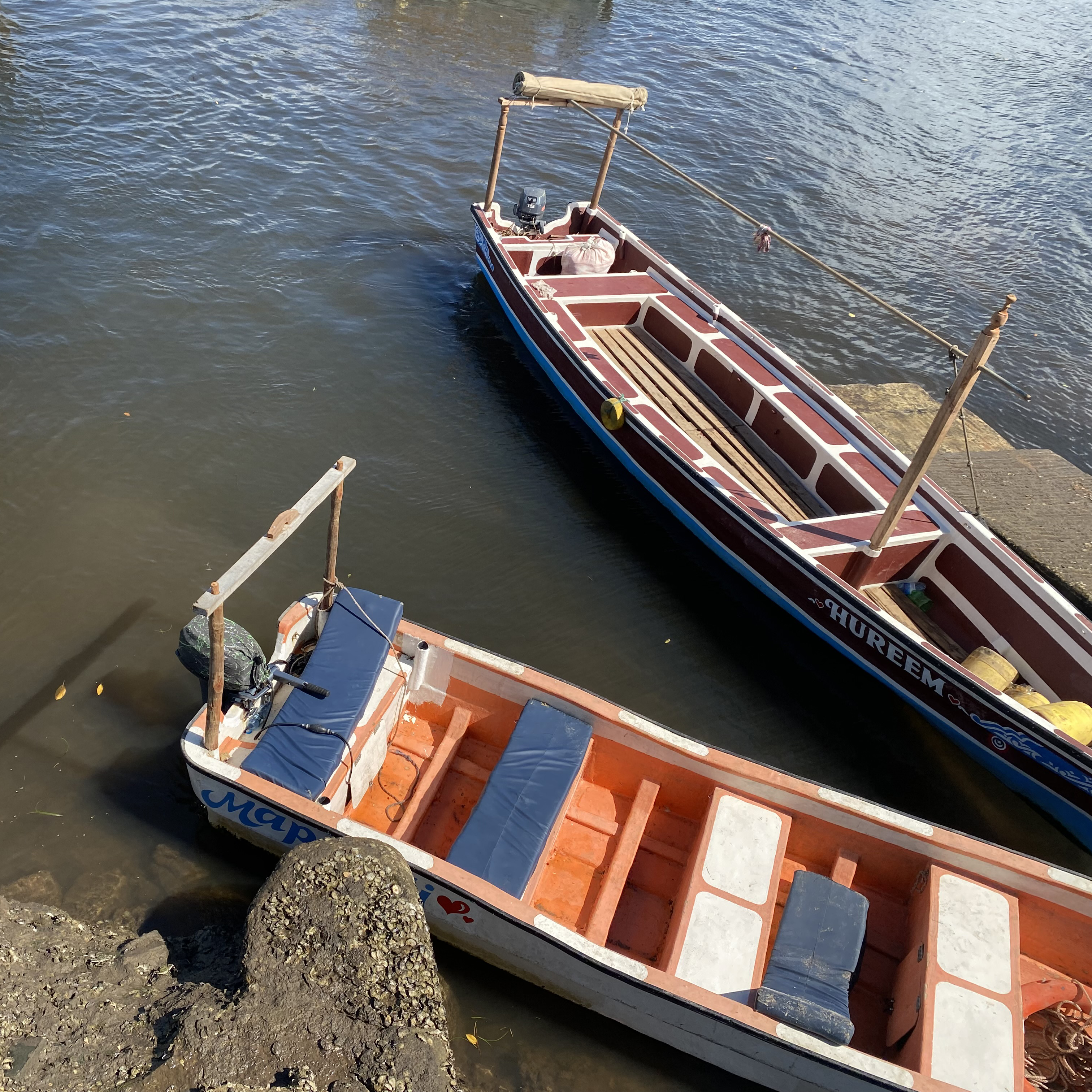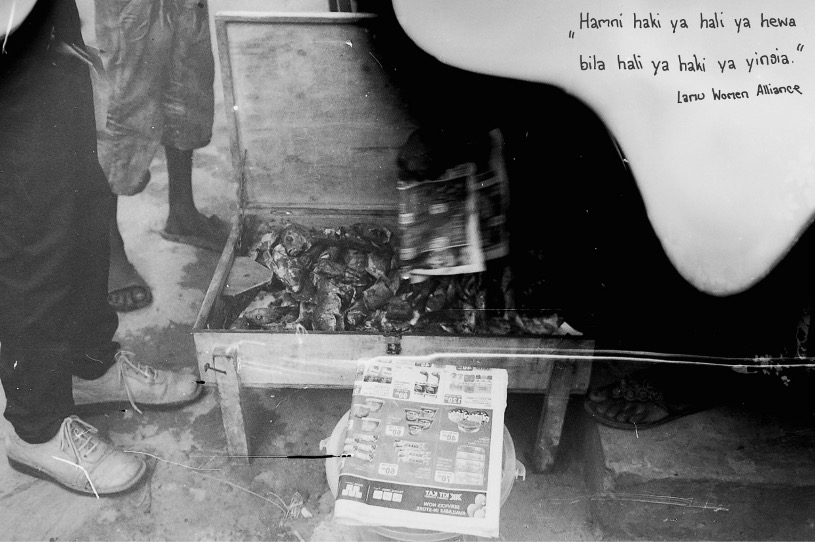Urbanisation at the Margins
How are the peripheral settlements of Kashmiri and Kandahari evolving, and what does this tell us about the power to shape the urban?
Authors:
Eleonora Balestra
Hamdat Fathi Mahmud
Fatma Sayyid Athman
Joëlle Martz
By adopting a historical lens, our research traced the stories and memories of those who have built and inhabited Kashmiri and Kandahari over decades of its incremental yet continuous urbanisation.
These stories revealed the many ways in which residents navigate fragmented land tenure, engage in tacit negotiations with neighbours, and cope with the ambiguous status of their neighbourhoods within the frameworks of urban governance that are currently gaining relevance and capacity in Lamu.
![]()
Eleonora Balestra
Hamdat Fathi Mahmud
Fatma Sayyid Athman
Joëlle Martz
By adopting a historical lens, our research traced the stories and memories of those who have built and inhabited Kashmiri and Kandahari over decades of its incremental yet continuous urbanisation.
These stories revealed the many ways in which residents navigate fragmented land tenure, engage in tacit negotiations with neighbours, and cope with the ambiguous status of their neighbourhoods within the frameworks of urban governance that are currently gaining relevance and capacity in Lamu.
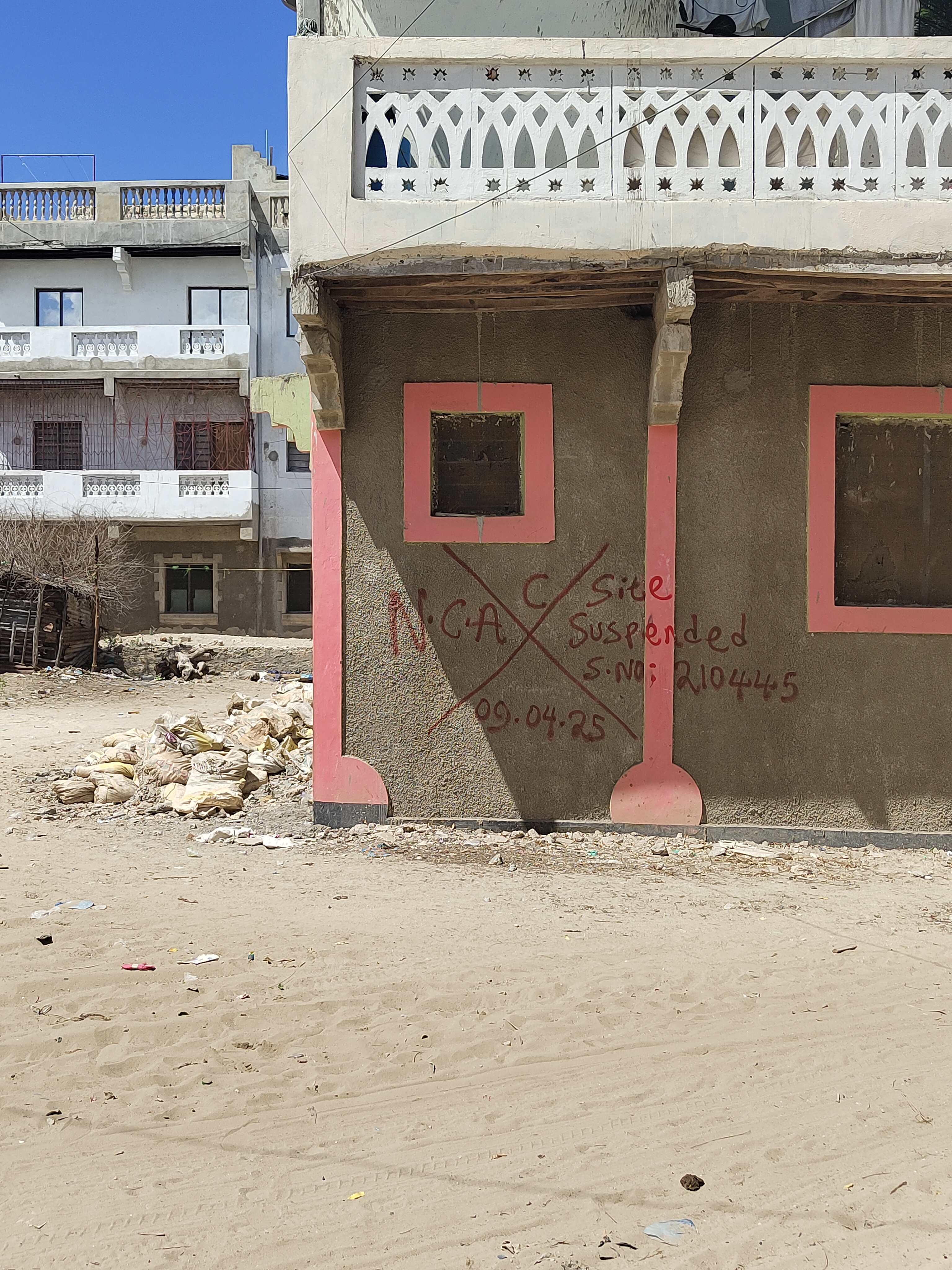
“Some would term what is happening in these settlements as classical urban sprawl. There isn’t much order; the only authority present at that time were the original land owners, who allowed the people to settle there. The way they build is very different to the old town [...] these are the houses of their own dreams.”
- Resident of Lamu Town
affiliated with the
National Museum of Kenya
Constant tacit or explicit negotiations characterise informal urbanisation in Kashmiri and Kandahari, which stands in sharp contrast to the municipality’s practice of marking new structures that don’t fit regulatory norms with a bright red ‘X’. These visual markers point to tensions that result from growing enforcement capacities of rigid laws, recently published land-use plans, and broader development projects that mismatch more incremental, negotiated ways of urbanising.affiliated with the
National Museum of Kenya
Urbanisation in these settlements is shaped by both necessity and hope for future recognition.
Projects
Urbanisation at the Margins #2501
Between Formal Plans and Everyday Life
On my daily walks through the narrow streets of Kashmiri and Kandahari, I developed a little guessing game. Whenever I came across new red markings on bare, unplastered walls, I would try to guess what might have led the municipal surveyors to judge a particular building as failing regulations. Most of the time, I had barely a clue. But what grew from these regular observations of red X’s along my routes was a much more pressing question:
How do the residents here, the people I had come to think of as neighbours, respond to the growing presence of local urban authorities? And how does this shape the production of urban space, which until now had been almost entirely in the hands of those who call this place home?
![]()
To this day, Kashmiri and Kandahari are shaped by self-building practices, but formal rules are starting to have a greater influence as the local government becomes larger and more effective in enforcing them. This research looks at how urban spaces are being shaped through the ongoing interaction between everyday building practices and official regulations.
How do the residents here, the people I had come to think of as neighbours, respond to the growing presence of local urban authorities? And how does this shape the production of urban space, which until now had been almost entirely in the hands of those who call this place home?
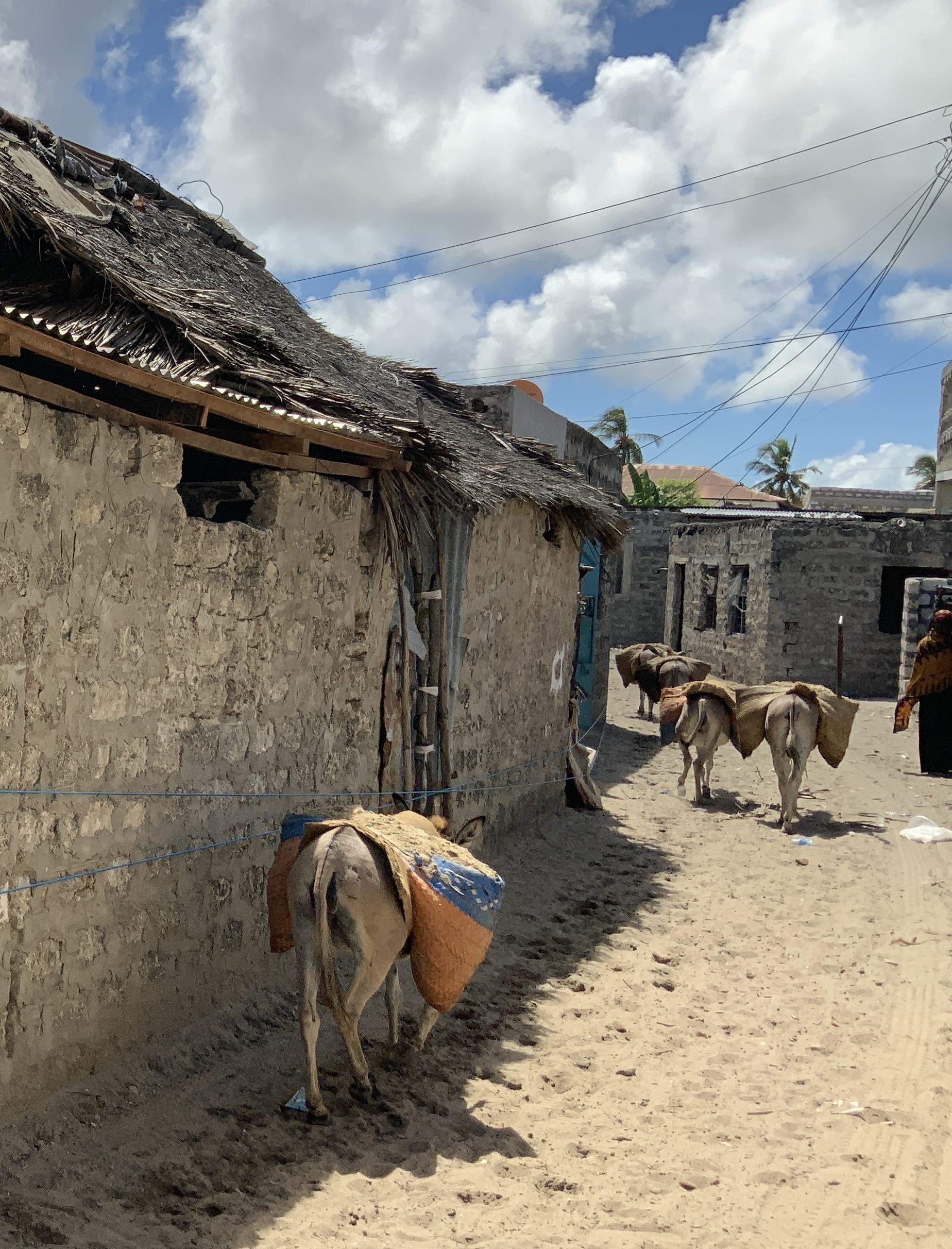
To this day, Kashmiri and Kandahari are shaped by self-building practices, but formal rules are starting to have a greater influence as the local government becomes larger and more effective in enforcing them. This research looks at how urban spaces are being shaped through the ongoing interaction between everyday building practices and official regulations.
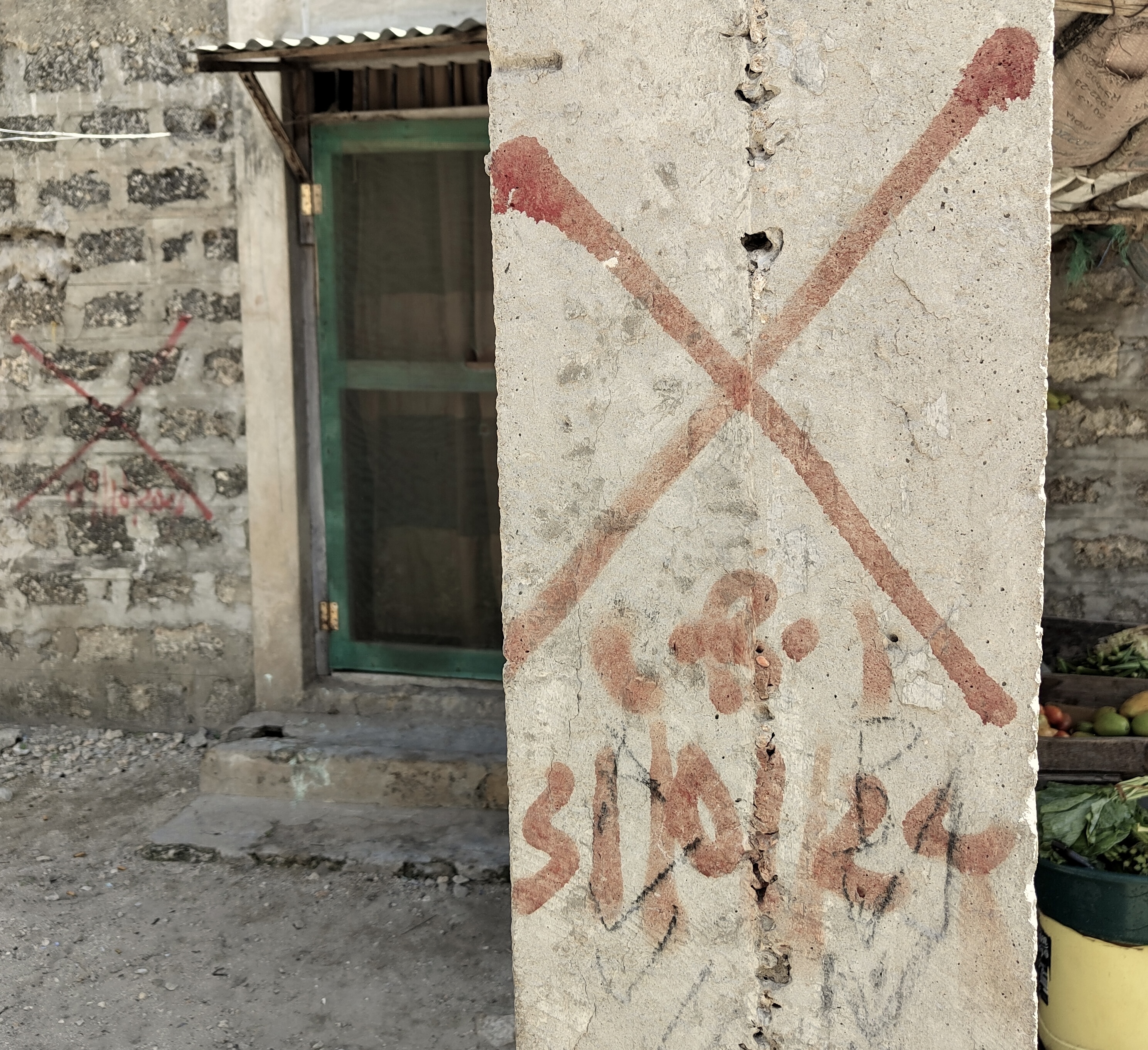
In Kashmiri and Kandahari, it is common for people to build their own houses, either by constructing them themselves or hiring professionals. Hardly a day passes without the sounds of construction nearby or the sight of donkeys carrying sand or building blocks through the streets. Prominent urban anthropologist Teresa P.R. Caldeira has described what is happening here as “peripheral urbanisation.” She theorises it as more than just development at the physical edges of a city; rather, it is a mode of producing urban space that is driven by the agency of residents themselves. Tied to financial means and personal opportunities, this process is typically incremental and interacts with formal markets and governance systems in ways that cross and connect these seemingly separate spheres. Such relationships are often described as transversal.

“transversal” is something that moves sideways and thus crosses boundaries — between formal and informal, powerful and less powerful, official and unofficial worlds.
Re-Engaging Informality
To explore and describe the interactions between residents and local government, I chose to use the terms formal and informal — a distinction that many influential scholars have criticised for decades. Building on these critiques, this study takes a closer look at the complexities of informal spaces.
The disenfranchised express a deep desire to live an informal life, to run their own affairs without involving the authorities or other modern formal institutions” (Bayat 1997, 53)
The disenfranchised express a deep desire to live an informal life, to run their own affairs without involving the authorities or other modern formal institutions” (Bayat 1997, 53)
It is important not to think of informality only as the opposite of official, state-defined rules, as it is more than the absence of such. It is an alternative form of social organisation. Flexibility, adaptability, and openness to negotiation may support people who are commonly excluded from formal systems. Though often connected to poverty, informality isn’t limited to people with low incomes. Middle-class people, too, increasingly live, work, and invest in informal spaces.
Everyone can engage with informality; some have the privilege to do so quietly, while others carry that label openly on their shoulders.
Everyone can engage with informality; some have the privilege to do so quietly, while others carry that label openly on their shoulders.
Tracing the In-Betweens
The foundations of urban life in Kashmiri and Kandahari are built on informally subdivided land, where former shambas (Kiswahili for agricultural land) were split and sold by their owners. As urbanisation gradually built over the small path that once separated these plots, the municipal garbage truck, which used to pass through to reach the town’s main dumping site behind Kandahari, was forced to find new routes. Over time, a new path, commonly referred to as TakaTaka road (TakaTaka is a Kiswahili term for garbage), emerged there, where unequal opportunities to build left plots empty.
Today, the municipality relies on this informally developed infrastructure, but it is mainly the residents who actively defend it. When someone attempts to lay a foundation for a new house on this road, others tend to whistleblow immediately. As a result, state enforcement is typically quick to show up at the construction site to intervene and halt construction attempts within hours.
The case of the TakaTaka road shows how the formal system sometimes works with informal structures to help achieve its own goals, while people involved in informal activities may use formal rules to advance their interests.
The way the TakaTaka road emerged is a good example of ‘mutual accommodation’ — a term used by urban scholar Carole Rakodi to describe how formal and informal actors work together to get access to land in African cities. My research shows that this idea also helps explain what’s happening in Kashmiri and Kandahari today.
As formal and informal actors adjust to one another, they sometimes, whether intentionally or not, help to legitimise each other’s actions. This is how mutual accommodation takes shape.
The case of the TakaTaka road shows how the formal system sometimes works with informal structures to help achieve its own goals, while people involved in informal activities may use formal rules to advance their interests.
The way the TakaTaka road emerged is a good example of ‘mutual accommodation’ — a term used by urban scholar Carole Rakodi to describe how formal and informal actors work together to get access to land in African cities. My research shows that this idea also helps explain what’s happening in Kashmiri and Kandahari today.
As formal and informal actors adjust to one another, they sometimes, whether intentionally or not, help to legitimise each other’s actions. This is how mutual accommodation takes shape.
Listening to Urban Rhythms
The people of Kashmiri and Kandahari have been shaping their neighbourhoods through mutual accommodation long before state institutions became involved in these areas. This study found that their incremental ways of building — a new wall here, a small extension there — make it easier for neighbours to adjust to one another over time. These slow, flexible timelines, shaped by gradual, adaptive, and sometimes opportunistic actions, allow people to create their own forms of acceptance and legitimacy, outside any formal rules or laws.
In contrast, formal planning tends to arrive with strict, project-based timelines and fixed ideas about what should happen and when. These big projects rarely leave room for the kinds of everyday negotiations that allow residents to quietly accommodate one another. Without this slow process of adjustment, formal interventions can easily feel disruptive, even threatening, and often struggle to gain acceptance within the community.
The frictions and accommodations evident today will shape the evolving relationship between state authority and resident agency in the future, as planning efforts continue to permeate the informal urban fabric of Kashmiri and Kandahari.
The frictions and accommodations evident today will shape the evolving relationship between state authority and resident agency in the future, as planning efforts continue to permeate the informal urban fabric of Kashmiri and Kandahari.
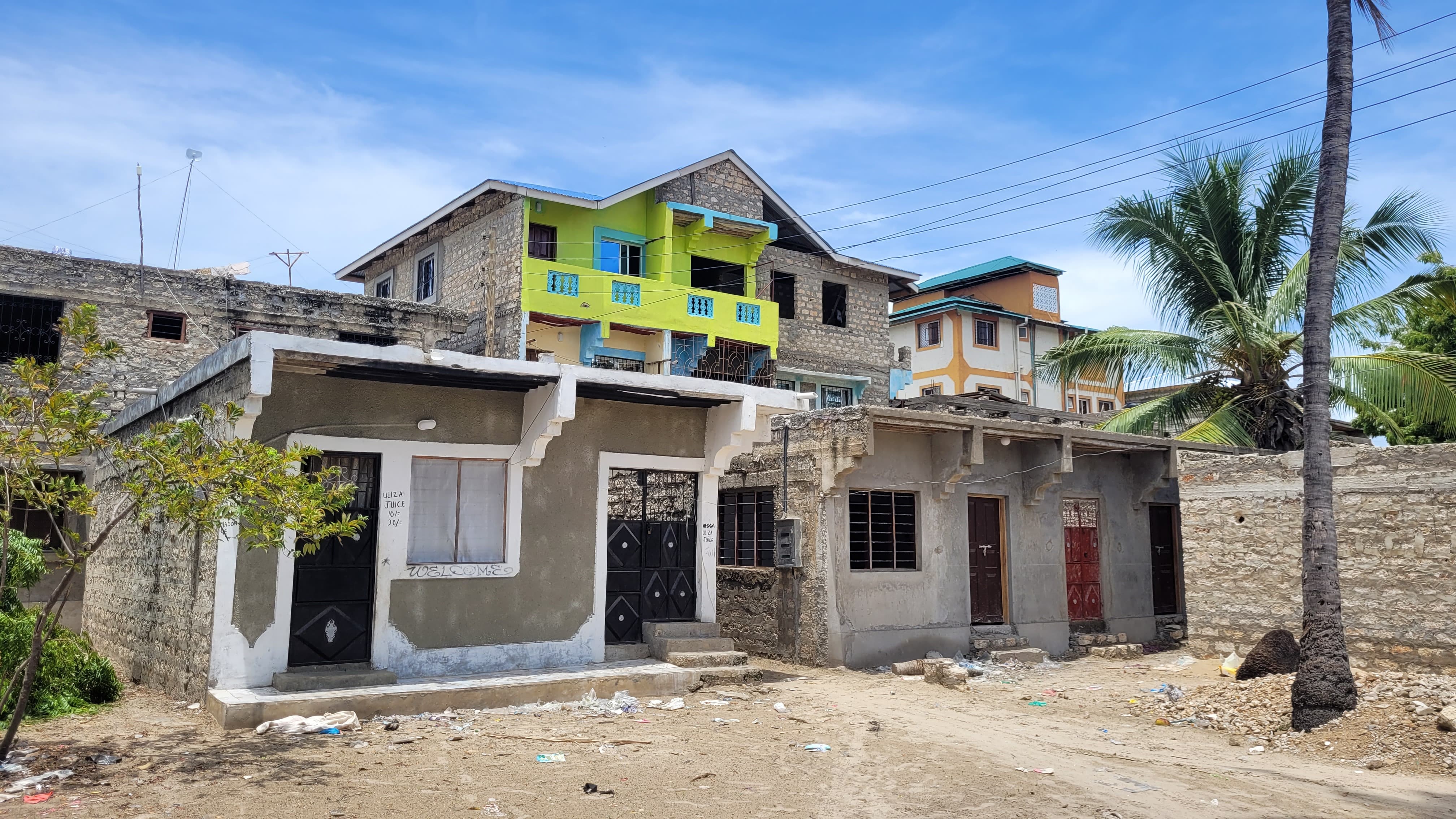
Women, Migration and Everyday in Wiyoni
How do (migrant) women in Wiyoni construct a sense of belonging and sustain their everyday lives? How are these actions further related to the social and physical dimensions of infrastructure?
Authors:
Svenja Jakob
Tefle Mohammed
Rebecca Rodrigues
Lilian Salama
Natalia Krikotina
Wiyoni is a new and rapidly growing settlement in Lamu, home to a diverse population of both long-time Lamu residents and newcomers. This theme addresses the broad meaning of infrastructure in the context of Wiyoni, with a particular focus on the combination of its physical and social dimension. One notable example is the planned road connecting Wiyoni to other parts of the island and the support networks that emerge within the community in response to its construction.
![]()
S. in front of her shop
Many women in Wiyoni have migrated from other parts of Lamu County or the Kenyan coast in search of better economic opportunities for their families. However, migration often presents challenges, such as finding affordable housing, building new social connections, and overcoming the stigma of being an outsider. Despite these challenges, women remain prominent figures in Wiyoni's daily economy. They run small businesses selling juices, mahamri, ice cream, ice, and baobab snacks, and they also run cafes, beauty salons, and shops, catering to both their own needs and those of the community.
![]()
M. and family preparing baobab snacks
Svenja Jakob
Tefle Mohammed
Rebecca Rodrigues
Lilian Salama
Natalia Krikotina
Wiyoni is a new and rapidly growing settlement in Lamu, home to a diverse population of both long-time Lamu residents and newcomers. This theme addresses the broad meaning of infrastructure in the context of Wiyoni, with a particular focus on the combination of its physical and social dimension. One notable example is the planned road connecting Wiyoni to other parts of the island and the support networks that emerge within the community in response to its construction.
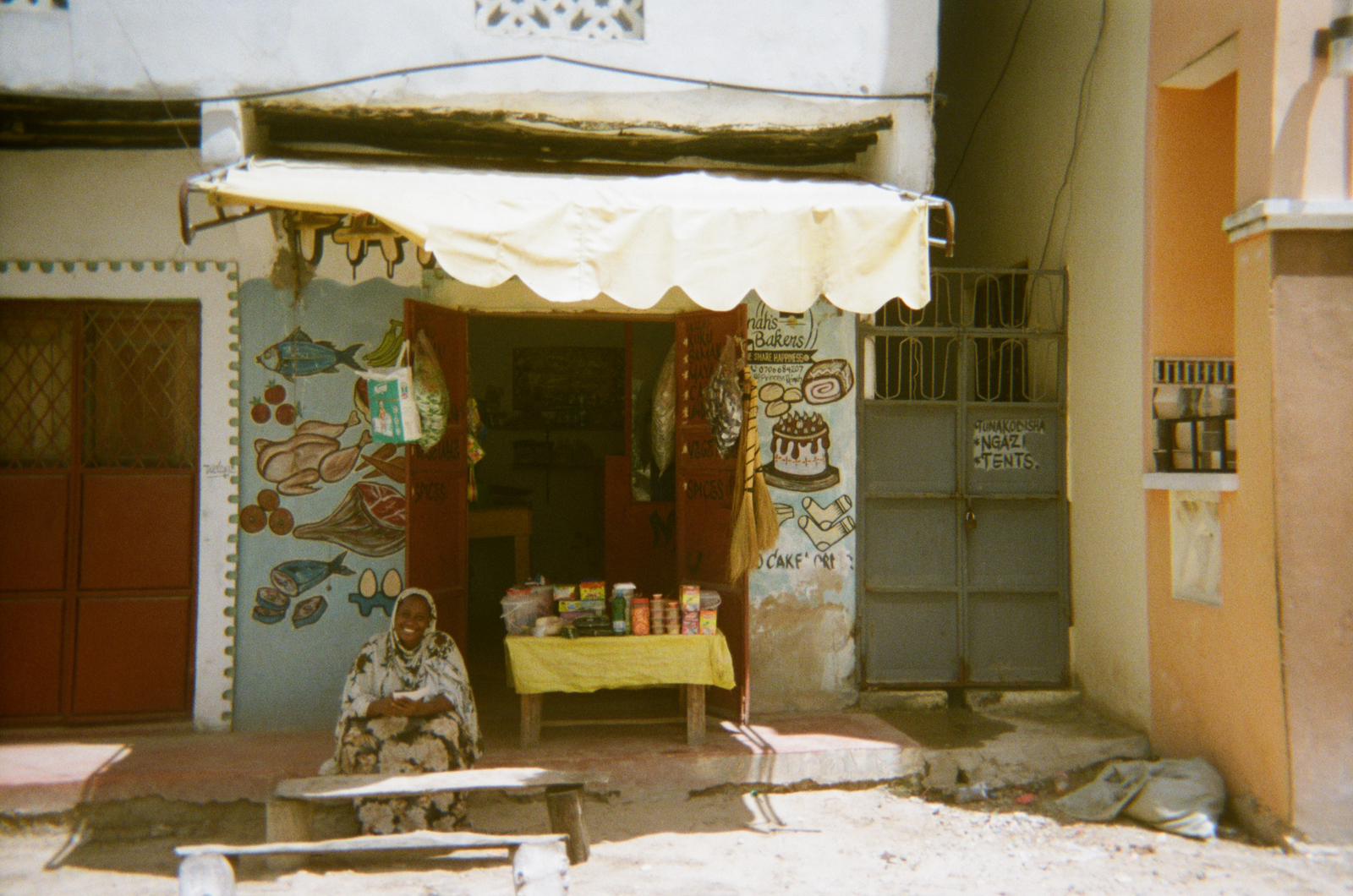
S. in front of her shop
Many women in Wiyoni have migrated from other parts of Lamu County or the Kenyan coast in search of better economic opportunities for their families. However, migration often presents challenges, such as finding affordable housing, building new social connections, and overcoming the stigma of being an outsider. Despite these challenges, women remain prominent figures in Wiyoni's daily economy. They run small businesses selling juices, mahamri, ice cream, ice, and baobab snacks, and they also run cafes, beauty salons, and shops, catering to both their own needs and those of the community.
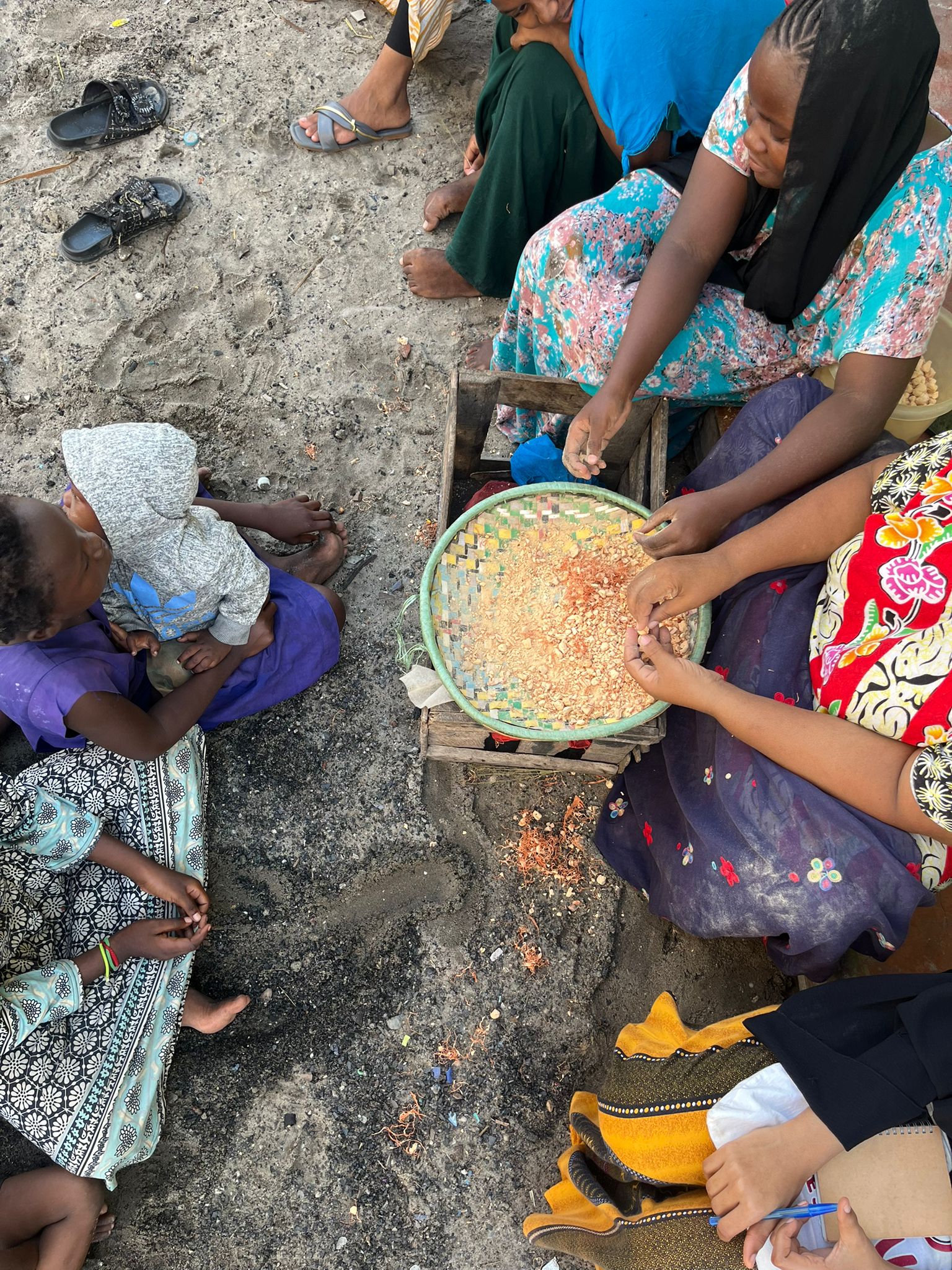
M. and family preparing baobab snacks
To understand the forces that shape life and business in Wiyoni, the research team interviewed local residents, including shop owners, community leaders, newcomers, as well as officials from the municipality. The findings highlight the challenges of accessing education, finance, infrastructure, social connections, and security, and reveal how women navigate these challenges to sustain their lives and livelihoods.
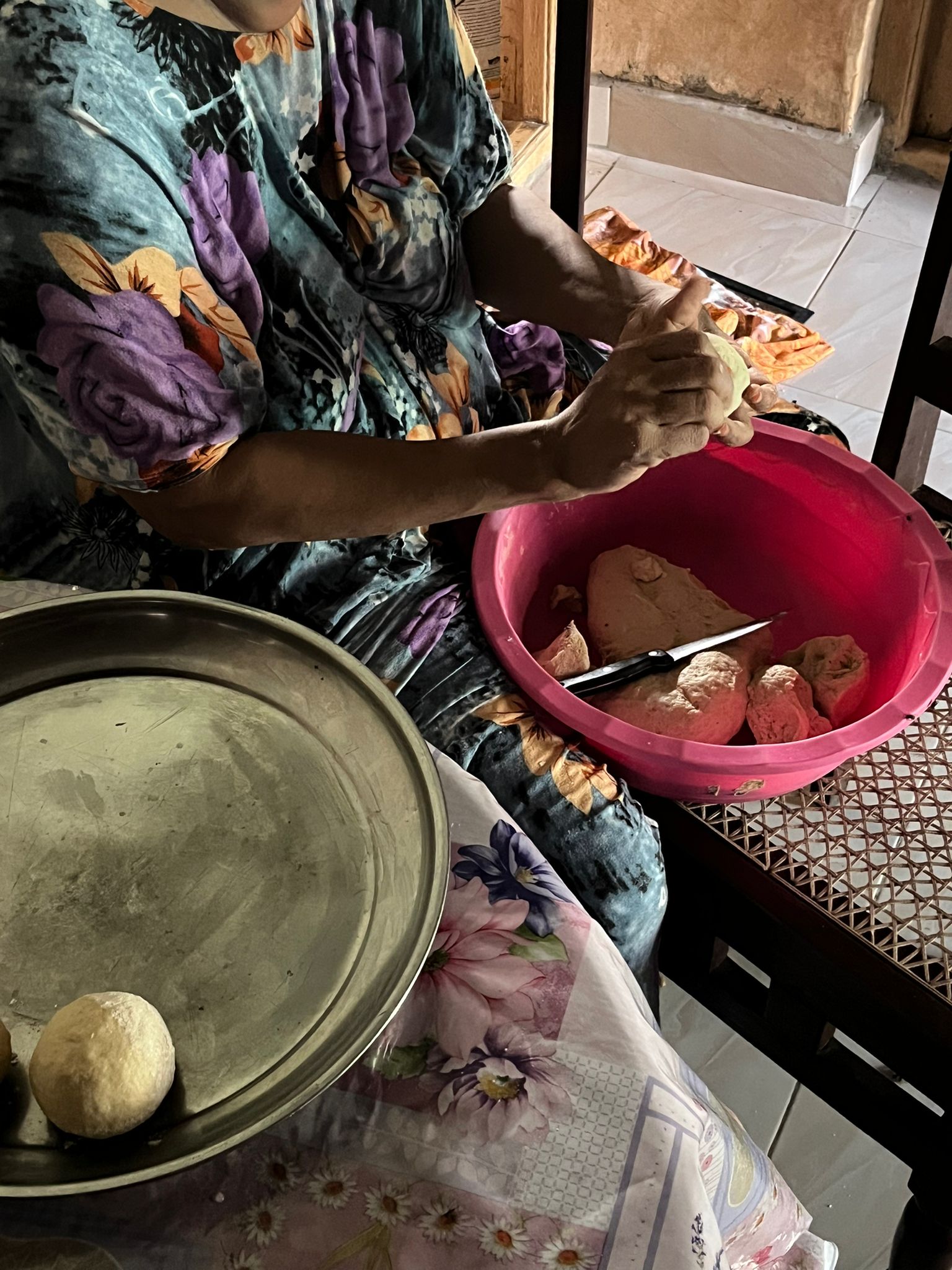
H. making mahamri at home during an informal interview
Projects
Women, Migration and Everyday in Wiyoni #2502
Understanding women’s business problems in Wiyoni
Before going to Lamu, my own thoughts about how Islamic society is organised and the potential challenges for local women to develop businesses freely would flash through my mind like subliminal frames. Having had experience interacting with Muslim communities before, I understood the differences in our views and wasn’t sure I would be able to feel free there, both as a woman and as a white tourist/researcher. From the first days, immersing myself in the details of local life thanks to living with host families, the traditions and rules of relationships between men and women became clearer and clearer.
![]()
Understanding the local relationship system, I relaxed a little and sank into just “being,” trying to stay more in the here and now rather than in my thoughts.
Having spent the first week studying Lamu for myself, we then moved on to interviews with local residents. We asked about infrastructural problems but we were met with indifference to this topic from local people. We returned to exploring other dynamics affecting Lamu Island and the Wiyoni area in particular. We walked along sandy roads washed out by the rain, talking to local women about life in Wiyoni. Most of them had moved here from other places; some were Muslim, others Christian. Trying to build their new lives here, these women face the fact that their families lack basic means to survive. They try to earn money to feed their children and give them an education that they themselves never had. After talking to a dozen women and looking around, we saw what we hadn’t noticed before – women sitting in front of their homes selling food, working, or running their small shops. But why had we not seen what had been shining right into our eyes this whole time, like a sunbeam reflected off a piece of glass?
![]()

Understanding the local relationship system, I relaxed a little and sank into just “being,” trying to stay more in the here and now rather than in my thoughts.
Having spent the first week studying Lamu for myself, we then moved on to interviews with local residents. We asked about infrastructural problems but we were met with indifference to this topic from local people. We returned to exploring other dynamics affecting Lamu Island and the Wiyoni area in particular. We walked along sandy roads washed out by the rain, talking to local women about life in Wiyoni. Most of them had moved here from other places; some were Muslim, others Christian. Trying to build their new lives here, these women face the fact that their families lack basic means to survive. They try to earn money to feed their children and give them an education that they themselves never had. After talking to a dozen women and looking around, we saw what we hadn’t noticed before – women sitting in front of their homes selling food, working, or running their small shops. But why had we not seen what had been shining right into our eyes this whole time, like a sunbeam reflected off a piece of glass?

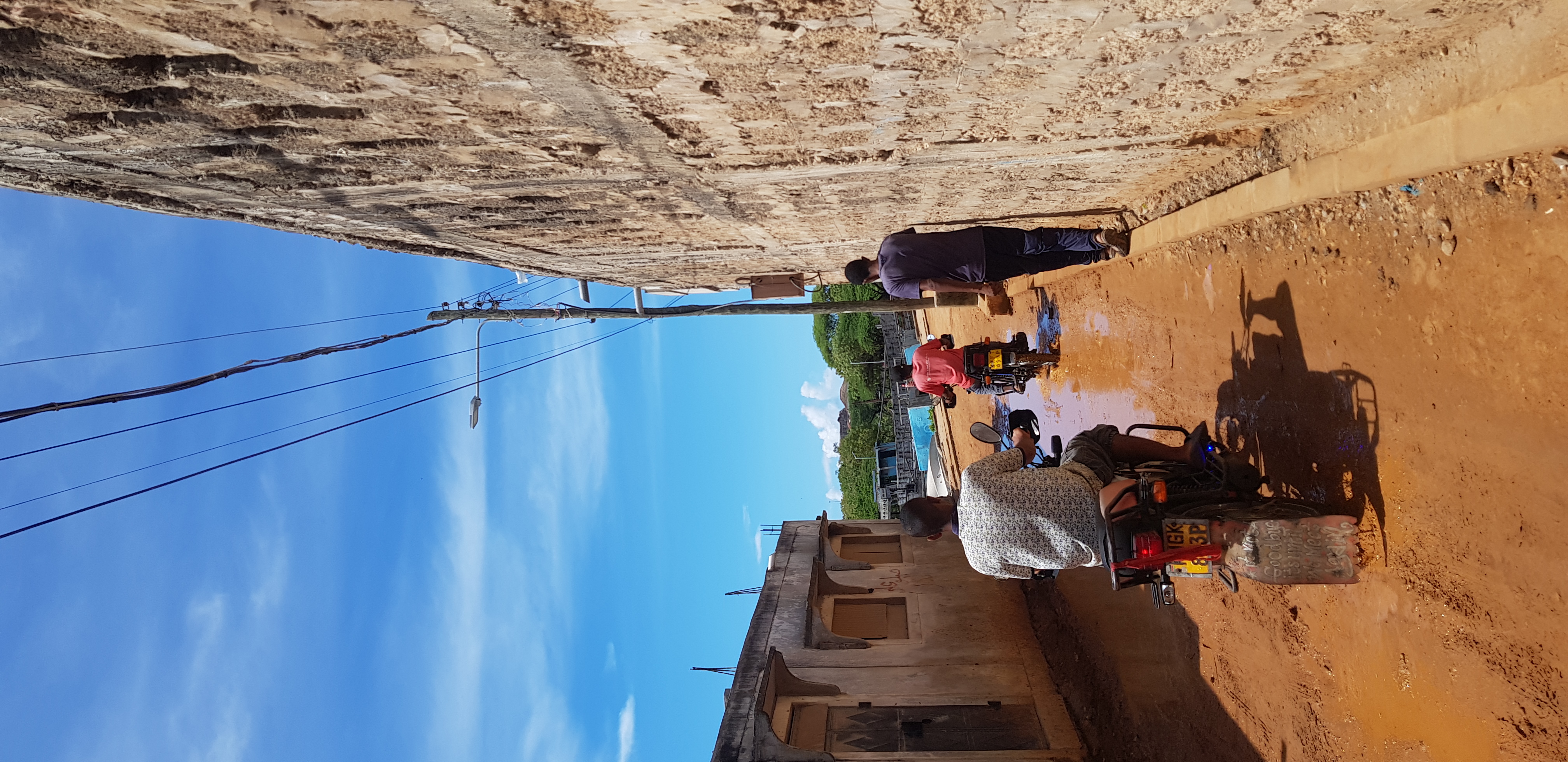
In Islamic society, a woman’s traditional role has been to care for the home and raise the children. Women still spend most of their time at home and when they run a business, it is often located at home or nearby. Women are “hidden” from strangers’ eyes, yet are an important part of Wiyoni’s social infrastructure.
The Covid-19 pandemic, which led to many divorces and a change in views on traditional family structure and household duties, challenged women to become more independent.
Analysing the knowledge we gained after several weeks of research, it became clear that women’s difficulties in Wiyoni are linked not only to Islam’s definitions of a woman’s place as interpreted in Lamu, but also to broader social changes. A lack of formal education, distrust in the state system, and, as a result, missed opportunities to seek support from organisations helping women’s businesses work together to create unique barriers for women-owned businesses.

While researching and trying to understand Wiyoni’s uniqueness in terms of women-owned businesses, I began wondering: is this case really unique in a global context? Studying works on Black feminism and feminism in general makes it clear that discrimination against women because of their gender, skin color, race, and social class is a pattern repeated on many pages of history. The struggles of building a business as not only a woman but also a newcomer to a community are deeply permeated with centuries of fighting for rights, facing discrimination, and striving for a brighter future. Yet, facing these challenges again and again, women coming with their families to live in Wiyoni continue their path, no matter what.
Women, Migration and Everyday in Wiyoni #2503
Kupatikana si Kukubalika:
Kupatikana si Kukubalika:
Belonging, Informality, and Moral Navigation Among Migrant Women in Wiyoni, Lamu
During a walk to Wiyoni, I noticed that one of the local people I had interacted with before was wearing her veil differently; in addition to her usual hijab, she was also wearing a niqab. Curious, I asked why. The answer came with gentleness, care, and a certain discomfort: she didn’t want to be recognized or associated with Wiyoni.
At first, I didn’t fully understand why. But as we talked more about it, I began to grasp (even if not explicitly) an unease in her words: a discomfort with how people from Wiyoni were perceived.
At first, I didn’t fully understand why. But as we talked more about it, I began to grasp (even if not explicitly) an unease in her words: a discomfort with how people from Wiyoni were perceived.
She described them as “modern,” influenced by outside customs, with different behaviors; almost as a threat, a stain on the expected moral conduct, or something that endangered tradition.
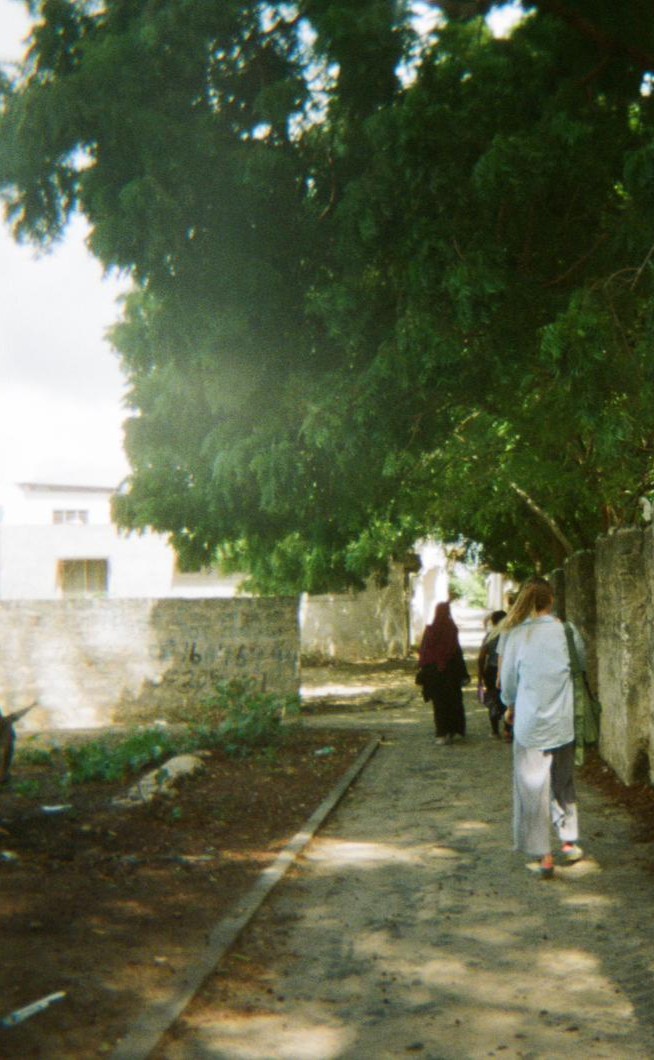
Research team during fieldwork in Wiyoni
Being associated with that neighborhood, or with the people who lived or circulated there, was a risk to her reputation within her own community. And in Lamu, community is one of the most valuable things a person can have. Beyond one’s immediate family, the community includes religious leaders, childhood friends, and neighbors — people you're taught from a young age to respect and keep close. It represents an extended network of financial, emotional, social, familial, and religious support; fundamental for belonging and success on the island: whether to get a job, to receive help in times of need, to secure housing, or to form a family.
In some way, this discomfort with the “new” or the “different” also echoed within the internal dynamics of this year’s research group, composed of researchers from UniBasel and LYA. During the last week, some local researchers shared their impressions, and it became clear that maintaining a relationship with us, foreign researchers, felt like walking a fine line. They enjoyed the company and accessed spaces they normally wouldn’t frequent, such as cafés, restaurants, interviewees’ homes, hotels, and more. Yet, at the same time, they felt a certain tension about what their families and the community might think. As different and external, we could represent a risk of moral influence. A possible departure from local norms and traditions.
In some way, this discomfort with the “new” or the “different” also echoed within the internal dynamics of this year’s research group, composed of researchers from UniBasel and LYA. During the last week, some local researchers shared their impressions, and it became clear that maintaining a relationship with us, foreign researchers, felt like walking a fine line. They enjoyed the company and accessed spaces they normally wouldn’t frequent, such as cafés, restaurants, interviewees’ homes, hotels, and more. Yet, at the same time, they felt a certain tension about what their families and the community might think. As different and external, we could represent a risk of moral influence. A possible departure from local norms and traditions.
It was in this friction, between visibility, belonging, and exclusion, that I began to perceive a deeper tension in Lamu, within the community and, beyond it, among its residents. Belonging in the local community was not a given, not even for those born there or connected through friendship or faith. There were subtle limits and unofficial but widely understood rules that determined who could occupy certain spaces, under what conditions, and when it was acceptable to slightly cross the line.
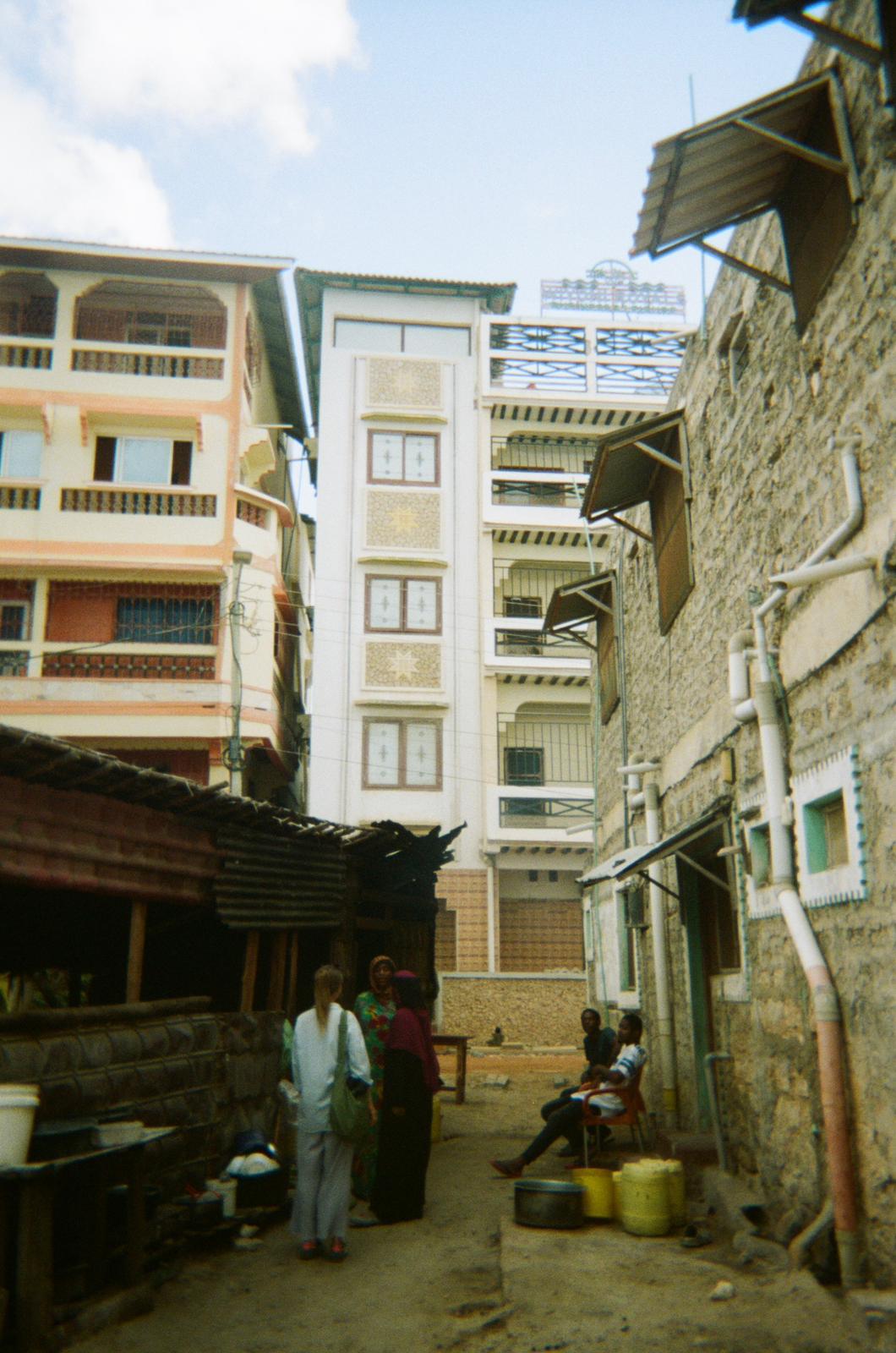
Members of the research team interviewing a local business owner in Wiyoni
That was the starting point of my seminar paper. Not a grand revelation, but a persistent discomfort perceived and observed. Something that repeated itself and resurfaced. I began to realize that everyday decisions, which I call performances, inspired by Sarah Hillewaert, such as what to wear or which route to take to a neighborhood, were not made solely on an individual basis, but also as deliberate actions in relation to others’ gazes, public opinion, and unspoken rules.
Reflecting on the daily experiences of the women in our research group, most of whom are originally from the island, and the impact of these dynamics on their lives, I shifted my focus to understand how such issues affect migrant women. In this context, Wiyoni proved to be a key place for this observation, as it is where most people from other parts of the country are concentrated on Lamu Island.
Reflecting on the daily experiences of the women in our research group, most of whom are originally from the island, and the impact of these dynamics on their lives, I shifted my focus to understand how such issues affect migrant women. In this context, Wiyoni proved to be a key place for this observation, as it is where most people from other parts of the country are concentrated on Lamu Island.
As a migrant, I recognize that moving involves profound changes in daily life and in how one envisions the future. However, my own migratory experience may differ significantly from that of the women in Wiyoni, whose motivations, circumstances, and contexts are distinct from mine. Therefore, when addressing social codes and forms of belonging in Lamu, especially in Wiyoni, it is essential to emphasize that these are specific contexts with their own dynamics that cannot be generalized to all migratory experiences. This diversity shows that the concept of “migrant” encompasses multiple realities, making it necessary to understand the specificities of each group in order to grasp the complexity of their trajectories. That said, it is possible to affirm that social codes vary everywhere, but I developed a particular curiosity about how these codes manifest in Lamu and, above all, in Wiyoni, where the senses of belonging were unfamiliar to me and had different complexities and carried different meanings.
For example, as a Brazilian living in Switzerland, I have had to adapt to certain local norms. However, most of the time, I do not feel obliged to behave “like a Swiss woman” and I believe I do not perform as such. The consequences of this, and the impact it has on my life, perhaps affect me less or matter less to me. But in Wiyoni, migrant women navigate codes that, if not followed, can compromise their support networks as well as their emotional, social, and even material security.
Of course, in any context, there are always individuals who, despite being aware of local social expectations, consciously choose not to follow them, and this is also a legitimate way of being. This is the case, for example, of the women who run the Wiyoni pub, who intentionally position themselves outside these rules, embracing the risks and possibilities that this stance entails.
For example, as a Brazilian living in Switzerland, I have had to adapt to certain local norms. However, most of the time, I do not feel obliged to behave “like a Swiss woman” and I believe I do not perform as such. The consequences of this, and the impact it has on my life, perhaps affect me less or matter less to me. But in Wiyoni, migrant women navigate codes that, if not followed, can compromise their support networks as well as their emotional, social, and even material security.
Of course, in any context, there are always individuals who, despite being aware of local social expectations, consciously choose not to follow them, and this is also a legitimate way of being. This is the case, for example, of the women who run the Wiyoni pub, who intentionally position themselves outside these rules, embracing the risks and possibilities that this stance entails.
This theme of non-belonging and adaptation to local rules came up repeatedly in our interviews with migrant women living in Wiyoni. They occupy the most sensitive and vulnerable edge of this social “chain.”
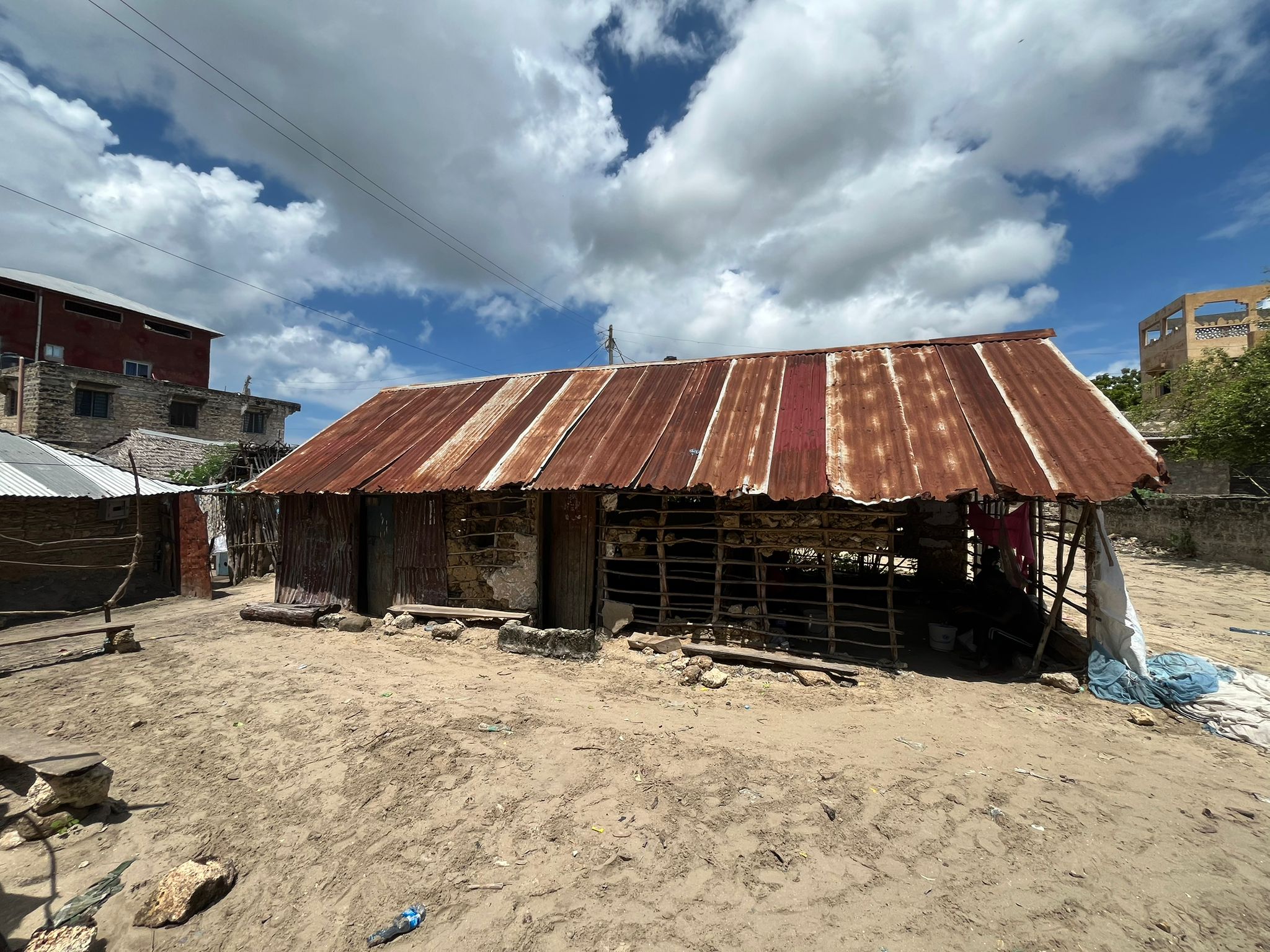
Local pub in Wiyoni
The question that has guided me since then is: how do these women (migrant, observed, scrutinized) construct a sense of belonging in a place that so often denies them legitimacy? How do they show the community whether they are (or are not) conforming to social norms?
Throughout the research, I realized that belonging in Wiyoni is constantly negotiated: never full, never guaranteed. For migrant women, this process is even more complex: beyond adapting to the material demands of life in a new place, they must also learn to navigate social codes that are often unknown or challenging.
Throughout the research, I realized that belonging in Wiyoni is constantly negotiated: never full, never guaranteed. For migrant women, this process is even more complex: beyond adapting to the material demands of life in a new place, they must also learn to navigate social codes that are often unknown or challenging.
Instead of seeking adherence to local norms (which are often exclusionary) many of them build alternative forms of belonging through horizontal alliances, informal exchanges, mutual support, and selective visibility. These practices compose a kind of social infrastructure that doesn’t appear on official maps but sustains life in Wiyoni. It is made of relationships, care, silent agreements; an everyday engineering that challenges the formal frameworks of institutional urbanism and reveals the strength of women as infrastructural agents.
At the intersection of vulnerability and agency, these women create small shifts at the boundaries of moral acceptability. Some perform respectability as expected; others publicly push against those limits and invent new ways of being. These performances (at times strategic, at others spontaneous) are not merely individual, but collective and situated. They draw a different moral cartography, in which belonging is not granted, but claimed.
By observing these dynamics, I came to understand that urban life in Wiyoni cannot be read solely through material infrastructures or official plans. It unfolds in the rhythms of everyday life, in the silences of interviews, in moments of self-censorship and rupture. It is in that space, between the visible and the invisible, that the city is made. And it is there that migrant women, with all their ambivalence, courage, and performance, sustain urban life.
Women, Migration
and Everyday in Wiyoni #2504
Infrastructural Assemblages in Wiyoni
The first connection one commonly makes with “infrastructure” is often physical, as the urbanist AbdouMaliq Simone describes (2004: 407). The physicality of infrastructure should also be understood in terms of that which is built by humans. This category then includes things such as roads, electricity networks, or ports. Field research in the neighbourhood of Wiyoni started from this point: inspired by the Kenya Informal Settlements Improvement Project (KISIP), I started to analyse the physical infrastructure of Wiyoni. KISIP plans to improve roads, street lights, and the sewage system in Wiyoni, as local interlocutors explained. However, being in the field and talking to the people who live in Wiyoni, we quickly realised that “infrastructure” consists of many more layers than these visible, physical objects. There are different social relations that are not visible at first sight, especially not as an outsider like the students from Unibas who don’t know about the cultural dynamics of the place.
From there on, I started looking out for “social” infrastructures during the field research. Social infrastructure includes relations people have with their neighbours, family and friends, and strangers, on an individual scale, as well as relations on the scale of the neighbourhood, the community elders (representatives of the neighbourhood), and towards the municipality, county government, or KISIP representatives.
Often, “physical” and “social” infrastructure are understood as separate from each other. This project critically reflects on this dichotomy and argues that they are indeed connected and influence each other. The many layers that “infrastructure” consists of form the place of Wiyoni and the daily lives of the residents. The project aims to shed light on this assemblage of different types of infrastructures, on understanding the making of Wiyoni, and to think of infrastructure as more than a human-built object.
Often, “physical” and “social” infrastructure are understood as separate from each other. This project critically reflects on this dichotomy and argues that they are indeed connected and influence each other. The many layers that “infrastructure” consists of form the place of Wiyoni and the daily lives of the residents. The project aims to shed light on this assemblage of different types of infrastructures, on understanding the making of Wiyoni, and to think of infrastructure as more than a human-built object.
Promises of Infrastructure

Street light built through KISIP
How physical and social infrastructure is connected and influenced is visible in the example of the KISIP project. One wish from the Wiyoni community, as well as the initial plan of KISIP, was to improve the neighborhood’s street lights.
They built one tall street light in the center, about 15 meters high, consisting of nine light bulbs. In that sense, the physical infrastructure was built and a promise kept. However, the light is not addressing the needs of the people, as it only lights up one small part of the neighbourhood. The physical infrastructure has an influence on how people move after dark, and further influences social ties, such as when and where to meet.
One request by the community that has not yet been addressed by officials is a market. People in Lamu usually buy fresh food (vegetables, fruits, meat, fish), usually at the market, which is located in the Old Town. The market is also a place of social interaction. Many women we talked to in Wiyoni expressed their desire for a market in Wiyoni in order to not have to go to the Old Town to buy the food. This is another example of a physical infrastructure that is tied to social interactions, as the market would not just provide people with food but also foster social relations as a place of gathering and simplify daily life by having easier access to products. Furthermore, it would allow more people in Wiyoni to have a business that could contribute to one’s income.
One request by the community that has not yet been addressed by officials is a market. People in Lamu usually buy fresh food (vegetables, fruits, meat, fish), usually at the market, which is located in the Old Town. The market is also a place of social interaction. Many women we talked to in Wiyoni expressed their desire for a market in Wiyoni in order to not have to go to the Old Town to buy the food. This is another example of a physical infrastructure that is tied to social interactions, as the market would not just provide people with food but also foster social relations as a place of gathering and simplify daily life by having easier access to products. Furthermore, it would allow more people in Wiyoni to have a business that could contribute to one’s income.
Social Ties
In our field research we mainly talked to women, as they were the focus of our research theme. Women doing business is another form of social infrastructure: First of all, women need customers to sell their products (such as baked snacks and sweets). If they know many people in the neighbourhood, it is easier to sell. Additionally, if they are well-connected to other women, they have easier access to the merry-go-round.
This is a collective fund in which women regularly pay a small amount of money. One after the other, each then receives a certain amount of money from the fund to invest in her business. This in turn contributes to the physical facilities of the neighbourhood, if a woman, for example, enlarges her store.
Time and Nature
A large part of Wiyoni consists of reclaimed land. In the 1990s, sand was extracted from the canal between Lamu Island and the mainland to enlarge the canal. Sand was put over the mangrove forest. Many buildings in Wiyoni are built on this land. The soil is eroding, which causes challenges for the building of houses and especially for sewage and water systems. These challenges further influence the daily lives of the residents, some of whom expressed their wish for improved access to water and sewage systems. Infrastructures are thus tied to the environment and, even though human-built, not separated from nature. Drawing on the work of geographer Andrew Barry (2016), the earth and soil is the infrastructure that physical, human-made infrastructure is constructed on.
Furthermore, the dimension of time shows, on the one hand, the transience of infrastructure, as nature (i.e. eroding soil) or material infrastructure can be demolished over time. On the other hand, it sheds light on how infrastructure is always in progress. Wiyoni is home to a variety of houses: at times painted buildings, at times only basic walls and a door.
Infrastructure is incomplete in the sense that it is an ongoing process: building new objects, negotiating projects and needs, getting to know new people and, perhaps, letting go of others.
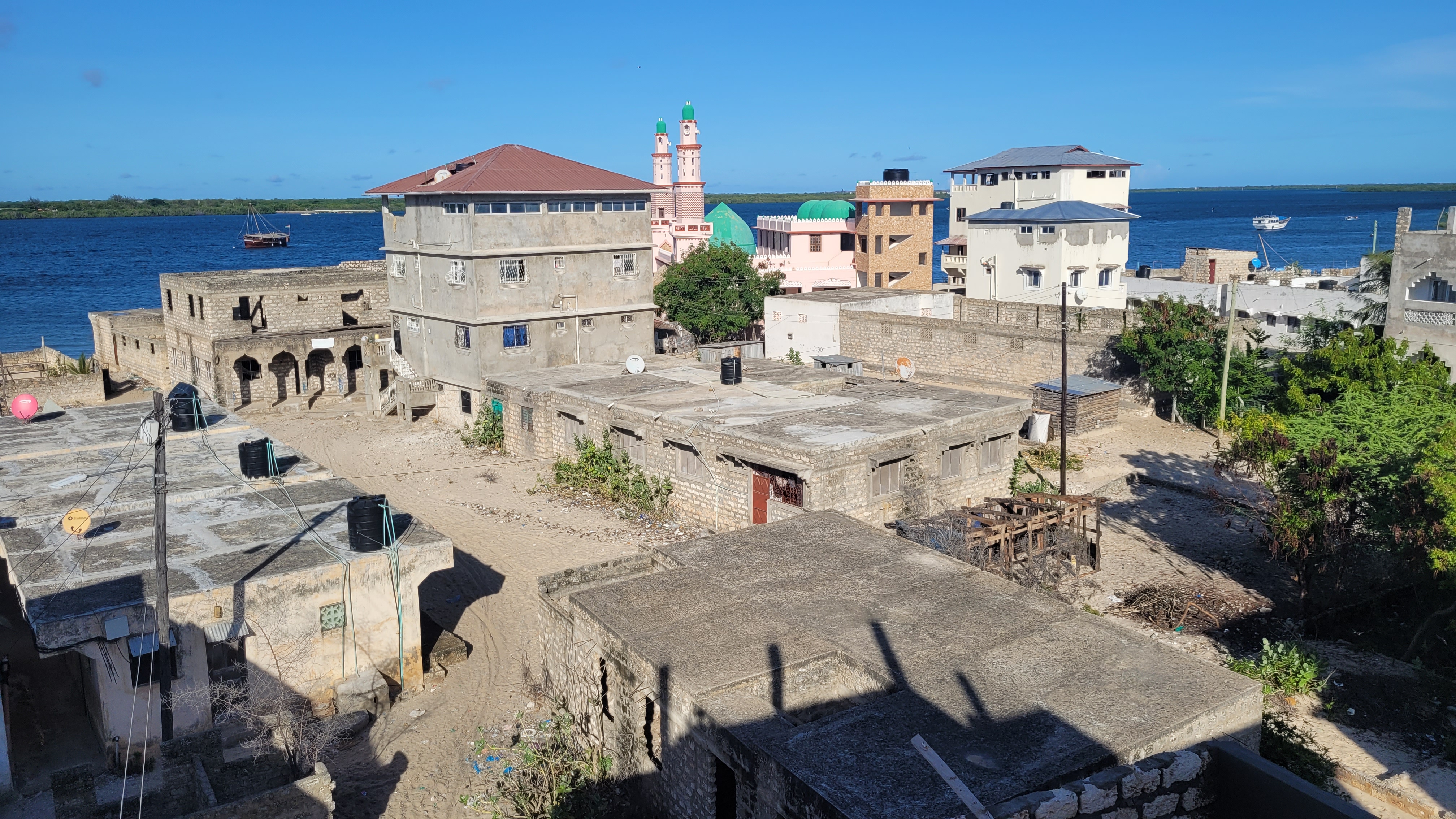
Wiyoni from Above: Buildings located on reclaimed land in different stages of construction.
Uncovering Wiyoni’s Infrastructures
This project shows the layers of infrastructure that together form Wiyoni: human-built objects, relationships between people on different scales, the environment, and the dimension of time. It enables the reader to reflect on one’s personal relations to infrastructures, things that one might take for granted but emerge out of a process of social and political negotiation, power structures, and environmental circumstances.
The Space Between Work and Prayer
Where do working Muslim women pray outside the domestic space? And how do their prayer practices manifest spatially in Lamu?
Authors:
Nusrat Ahmed Ali
Khadija Bwanahamisi
Muanamkuu Salim Bake Ali
Samira Muster
Mara Pepine
Times are changing in Lamu. One of these changes is that women increasingly work outside of their homes. Islam teaches that it is most rewarding for a woman to pray at home and traditionally, Lamu women have largely stayed inside the home. But this does not apply to everyone. Nowadays, an increasing number of Muslim women play an active part in the economic life of the city. So, when the adhan is heard from all directions in Lamu town and their male colleagues go to the mosques to pray, where do these women go?
Our investigation also revealed how the different levels of assertiveness and claim-making on the part of the Muslim working women result in a variety of spaces being made available for prayer – from the storage cupboard to the female mosque. By exploring these spaces, we uncovered underlying connections between gender, culture, faith, labor conditions, and the spatial expansion of Lamu Town.
Taking ablution in the Women’s Mosque
As an all-women research team, we were able to explore how these Muslim women assert their presence in the city through newly emerging places of prayer and how the female embodied practice of Islam enables working Muslim women to shape and in turn be shaped by the spaces they inhabit.
Entrance to Raudha Women’s Mosque
Projects
The Space Between Work and Prayer #2505
Culture, Religion, and the Question of Space
When investigating the topic of working Muslim women in Lamu, questions surrounding the lack of female mosques were answered time and time again with one word: “culture.” What is culture? And how is it different from religion? These are the questions on which I have built the theoretical framework that underpins my exploration of female religious practices outside of domestic space in Lamu Town.
![]()
“Most women in Lamu are not used to going to the mosques because of the culture”
– Abubakar & Hassan,
imams
imams
“We’re fighting with culture and religion.”
– Raya Famau, LWA
(in regards to women
empowerment)
(in regards to women
empowerment)
“Swahili people (women) do not use the mosque for prayer”
– Usthada Asya, teacher and radio moderator (regarding Swahili culture)
Due to an unstable and declining economy on the one hand, and a higher level of education on the other, more and more Muslim women are joining the workforce. In anticipation of the mega infrastructural project LAPSSET, the town is expanding, both in size and population. In this context, for many working Muslim women, praying at home is no longer a viable option.
Theoretical Framework
The theoretical framework I am using lies at the intersection of three concepts: heshima, embodied piety, and respectability politics. In the Lamu context, heshima is of vital importance; literally “respectability” in Swahili, it represents the unspoken moral code that runs through the Swahili community. Theorized by the anthropologist Sarah Hillewaert as a “relational and performative network” (a system of behavior codes that apply to one’s role in the community and the mutual relationships between members), heshima relies heavily on Islamic values and morals, without, however, being one of the teachings of Islam. The way heshima functions in the Lamu context is very reminiscent of “respectability politics.” This concept, theorized by Evelyn B. Higginbotham in the U.S. context of African-American women and adapted to an African feminist perspective by Sylvia Tamale, refers to the strategies used by women to attain legitimacy in a patriarchal environment, by exercising social control over each other’s bodies and behavior.
In order to avoid the pitfalls of binary oppression-liberation narratives, I also introduce Saba Mahmoud’s concept of embodied piety. The anthropologist reframes agency not as resistance to norms, but as the ethical cultivation of the self through religious practices. Through this lens, the actions and choices undertaken by the women of Lamu in regards to their preferred spaces of prayer become proofs of agency and self-determination under the prevalent moral system, defined by the respectability politics of heshima.
![]()
Prayer and Spatial Negotiations:
Women’s Strategies in Daily Life
I apply this theoretical framework in order to reveal the socio-cultural reasons behind some of the more prevalent choices among Muslim working women in Lamu about where to pray. For instance, the choice to pray at home during lunch breaks has two underlying reasons: the Islamic prescription that teaches that women receive more spiritual rewards by praying at home and the more practical reason of having domestic responsibilities, like preparing lunch for the children.
This is where the spatial expansion of the town comes into play, as urban development becomes a hurdle in the most heshima-elevating prayer practices that working Muslim women can engage in. With longer distances and unreliable means of transportation, women can no longer easily go home on their lunch break to pray for dhuhr, the midday prayer. As such, they employ various strategies. Some visit the homes of relatives or friends that live closer to their place of employment, whereas others pray directly at their workplace, with a growing minority preferring to pray in the one accessible and adequate female mosque: Raudhwa Mosque.
The Role of Mosques
Generally, women pray in a mosque more often during Ramadan, as there are fewer domestic duties during the day, due to the fasting, which allows women to congregate en-masse in female mosques. Outside of Ramadan however, only one female mosque fulfills all the criteria to be properly used. In February 2025, Raudhwa Mosque opened its female section which, despite its small size, is bright, clean, and equipped with everything that women might need to fulfill their religious duties. It is also, as opposed to other mosques that have or have had a female section, conveniently located on the Seafront within walking distance from most workplaces that employ Muslim women. Raudhwa Mosque, however, is not perfect; most of the time it is locked and only a select few have a key and thus access to the building. Despite their popularization campaign, the mosque is still largely unknown by the women working within a radius larger than 100 meters.
The Culture-Religion Vicious Circle:
Why Women Don’t Pray in Mosques
The lack of female mosques in Lamu and the lack of visitors to those mosques reveals a vicious circle that proliferates at the intersection of religion and culture. Islam professes that it is more rewarding for a woman to pray at home and historically, most women did not leave the domestic space for prolonged periods of time. As such, it has become a part of the culture that women do not pray in mosques, which has been used as the reasoning behind the meager offering of female sections. The lack of appropriate space, in turn, makes women prefer the comfort and familiarity of their domestic space, further entrenching the idea that Muslim women in Lamu simply do not pray in mosques.
“Swahili people (women) do not use the mosque for prayer”
– Usthada Asya, teacher and radio moderator (regarding Swahili culture)
Improvised Sacredness:
Prayer in the Workplace
When praying outside of a domestic space, we can see women’s religious practices as a form of embodied piety, a way to express their agency in an environment that does not cater to them. Workplace prayer spaces are rarely institutionalized and thus often improvised. Offices, storage rooms, and the back rooms of shops take on a religious function through the act of prayer. However, these spaces, not being designed for such a function, are often lacking: too small, not clean enough, and occasionally without the proper ablution facilities. Regardless of their shortcomings, these improvised prayer spaces represent a way for women to appropriate and transform them in accordance with their religious needs, thus becoming an act of religious self-cultivation.
The Space Between Work and Prayer #2506
Gendered Contestations of Urban Space in Lamu, Kenya
Micropolitics of Prayer
Gendered Contestations of Urban Space in Lamu, Kenya
“How do Muslim working women’s prayer practices challenge the gendered cityscape of Lamu, fostering new female spaces of worship and increasing women’s presence in public areas?”
This research started from an interest in women’s spaces of prayer. While Muslim men usually pray five times a day at one of the 42 mosques in Lamu Town, Lamu’s Muslim women habitually pray in their homes. The recent increase in Muslim women engaging in non-domestic work is changing this. I was curious to first understand where the idea that women should pray at home comes from. From there, I was then trying to learn about these women's motivations for participation in the structural workforce and the changing needs that come with it. Lastly, I was looking at the way the practice of religion plays into this dynamic and the spatial manifestations of it.
In Swahili society, someone’s position in the social hierarchy used to be defined by their wealth, descent, and heshima (respectability). Having heshima is roughly defined by factors such as behaving respectfully and being a good Muslim. What that means in practice, though is constantly renegotiated amongst the members of Swahili society. An increased emphasis on heshima in the beginning of the last century led to the seclusion of women becoming a status symbol for the family. The effects of this practice had a substantial impact on the position of women in the public sphere, which is still palpable in Lamu today. Many places in town, especially the bigger streets, squares, the Seafront, and many workplaces, continue to be male-dominated, which leads women to either avoid them or navigate them with precaution. For a long time, women were also discouraged from pursuing higher education.
“Most women in Lamu are housewives. My mom didn't go to school. […]. In the past, Lamu girls didn't go to school, only the boys did. The common assumption was that the girl child is there for marriage. This was the culture.”
– Young Woman from Lamu
Today however, changes in Lamu’s economy and the rising level of education in women have led to their increased participation in the non-domestic workforce.
Working, for many of them, is much more than just a way to make money. It became clear to me that it is also a means to gain some independence and to open life paths beyond marriage and domestic duties. Through the insights of Belgian anthropologist Sarah Hillewaert’s study of Lamu’s youth, we also understand that these women see working, especially in NGOs and aid organisations, as contributing to development and therefore to the wellbeing of the town and its residents, contributing to their heshima.
At the same time, by joining the workforce, and with their increased presence in the streets and workplaces, Muslim women challenge the ever-present, unwritten rules of heshima. However, religion remains central in many of their lives, contradicting a western view of secularisation as a liberating element. For most of the women we spoke to, there was no doubt that they would continue their salat (the practice of their five daily prayers) when working. Scholars like John R. Bowen describe the Muslim daily prayers as one of the most visible aspects through which Muslims distinguish themselves from other religions, but also from one another and their varying degrees of religious observance. It therefore comes as no surprise that women in Lamu also employ their own religiosity to show that a practicing Muslim, a person with heshima, can also come in the form of a working woman.
![]()
A prayer room inside an office
The increased participation of Muslim women in Lamu's formal workforce is not merely an economic shift but a transformation of the city's social and spatial dynamics. As these women navigate the complexities of work and religious observance, they challenge traditional norms of heshima and redefine the gendered nature of public spaces. Their commitment to maintaining their daily prayers while engaging in non-domestic work emphasises the intricate relationship between gender, religion, and urban space. Through their everyday practices, these women are not only asserting their place in the city but also reshaping its urban fabric. The creation of new prayer spaces, from ad-hoc solutions to dedicated women's mosques, materializes their evolving needs and aspirations. My research highlights the importance of acknowledging and adapting to these transformations to cultivate more inclusive and equitable urban environments. The “micropolitics of prayer” utilized by these women stand as a compelling illustration of their agency and determination, embodying the continuous evolution of societal norms within Swahili society.
![]()
Outside Raudha Women’s Mosque
At the same time, by joining the workforce, and with their increased presence in the streets and workplaces, Muslim women challenge the ever-present, unwritten rules of heshima. However, religion remains central in many of their lives, contradicting a western view of secularisation as a liberating element. For most of the women we spoke to, there was no doubt that they would continue their salat (the practice of their five daily prayers) when working. Scholars like John R. Bowen describe the Muslim daily prayers as one of the most visible aspects through which Muslims distinguish themselves from other religions, but also from one another and their varying degrees of religious observance. It therefore comes as no surprise that women in Lamu also employ their own religiosity to show that a practicing Muslim, a person with heshima, can also come in the form of a working woman.
A prayer room inside an office
The increased participation of Muslim women in Lamu's formal workforce is not merely an economic shift but a transformation of the city's social and spatial dynamics. As these women navigate the complexities of work and religious observance, they challenge traditional norms of heshima and redefine the gendered nature of public spaces. Their commitment to maintaining their daily prayers while engaging in non-domestic work emphasises the intricate relationship between gender, religion, and urban space. Through their everyday practices, these women are not only asserting their place in the city but also reshaping its urban fabric. The creation of new prayer spaces, from ad-hoc solutions to dedicated women's mosques, materializes their evolving needs and aspirations. My research highlights the importance of acknowledging and adapting to these transformations to cultivate more inclusive and equitable urban environments. The “micropolitics of prayer” utilized by these women stand as a compelling illustration of their agency and determination, embodying the continuous evolution of societal norms within Swahili society.
“The opening of the women’s Mosque made me feel seen.”
– Working woman regularly praying at Raudha
Outside Raudha Women’s Mosque
Lamu’s Mkunguni Square
While some women go back to their homes at prayer time, through Lamu’s growing spatial expansion and the further distances, this is not always possible anymore, which leads to a new need for prayer places for women close to their workplaces.
I read the women’s everyday practices of working and especially praying in the city as acts of “micropolitics,” a term first coined by French philosopher Michel de Certeau in 1984, and taken up by Yasminah Beebeejaun, Professor for Urban Planning from the University College London. She appeals to planners to pay attention to women’s everyday actions and read them as acts of ‘micropolitics,’ to inform their planning and create more just cities for all genders. In the context of Lamu and other cities of the Global South, where the role of planning is distinctly different from a Western context, I argue that women’s ‘micropolitics of prayer’ negotiate symbolic but also physical space with the community and religious leaders. From small ad-hoc prayer spaces like a storage cupboard to more institutionalised spaces like the mosque dedicated to women, the material impact of this negotiation is manifold. The most prominent form of it is certainly the new creation of a mosque just for women, which enjoys great popularity amongst working Muslim women, but also serves travelling women as a temporary refuge in a city where there are not many other public spaces dedicated to women.
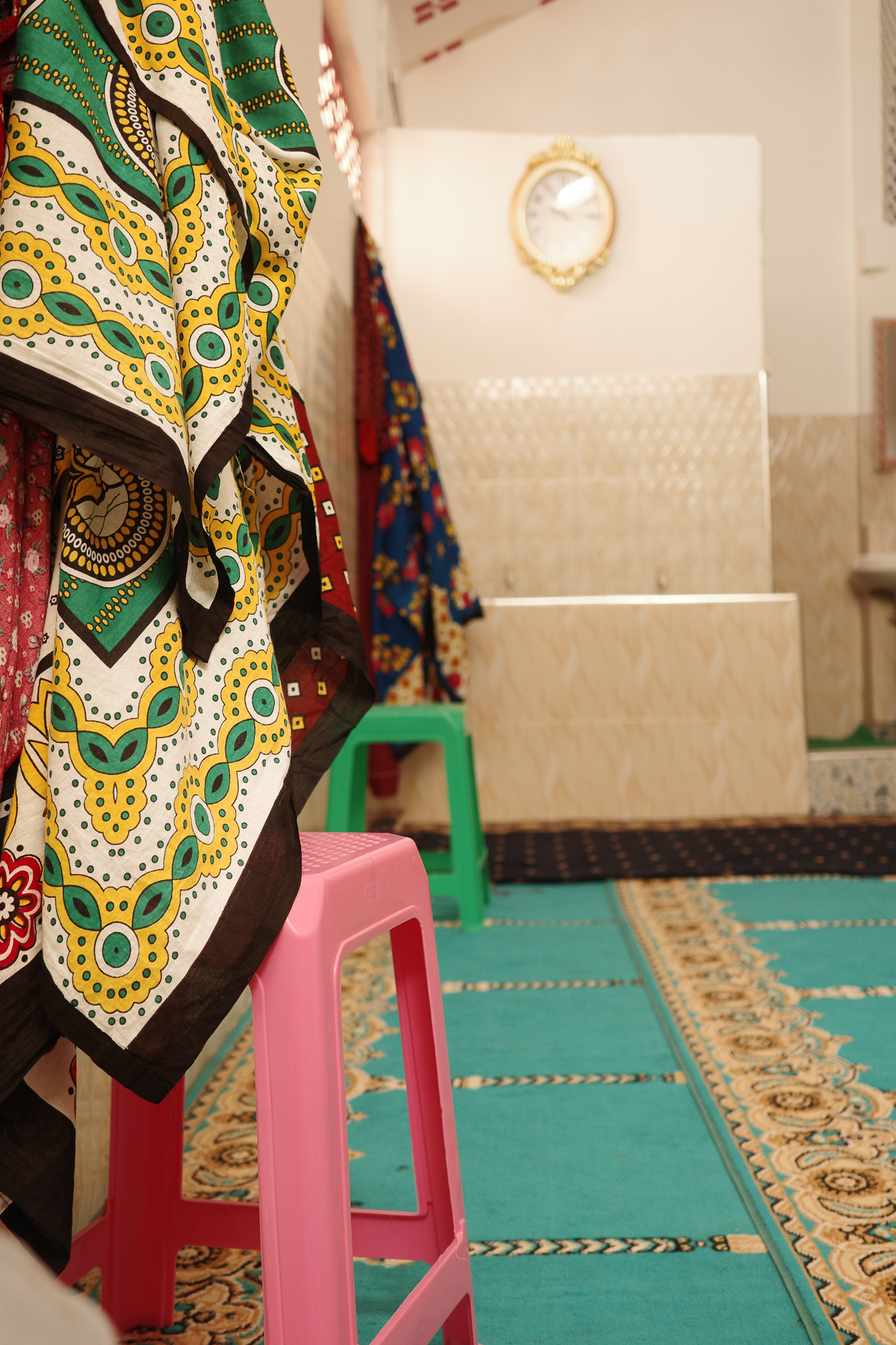
Inside Raudha Women’s Mosque
Mpishi Hula Moshi
How is food a creative medium that articulates Lamu’s oscillating relationships between bodies, places, and time?
Authors:
Nusrat Ahmed Ali
Ummi Haroun
Marie-Jean Malek
Olga Voiushina
Oliver Frayne
A proverb from Lamu that translates as “the cook eats smoke” highlights the hardships of cooking and the fact that the fruits of the cook’s labor are meant for others.
Nusrat Ahmed Ali
Ummi Haroun
Marie-Jean Malek
Olga Voiushina
Oliver Frayne
A proverb from Lamu that translates as “the cook eats smoke” highlights the hardships of cooking and the fact that the fruits of the cook’s labor are meant for others.
This theme traces the stories of food on Lamu Island, where different actors use food as a method to navigate daily challenges, leverage their status, and negotiate gender advantages and social connections by exploring new business opportunities.
Food has become a technology to access earning opportunities for those previously left out, hence reimagining and recreating urban spaces. We examine how this access shapes the uniqueness of Lamu's food culture, fostering value exchange both materially and culturally. This sustains a connection to traditions while providing hope for a future that may or may not be tied to the food business.
![]()
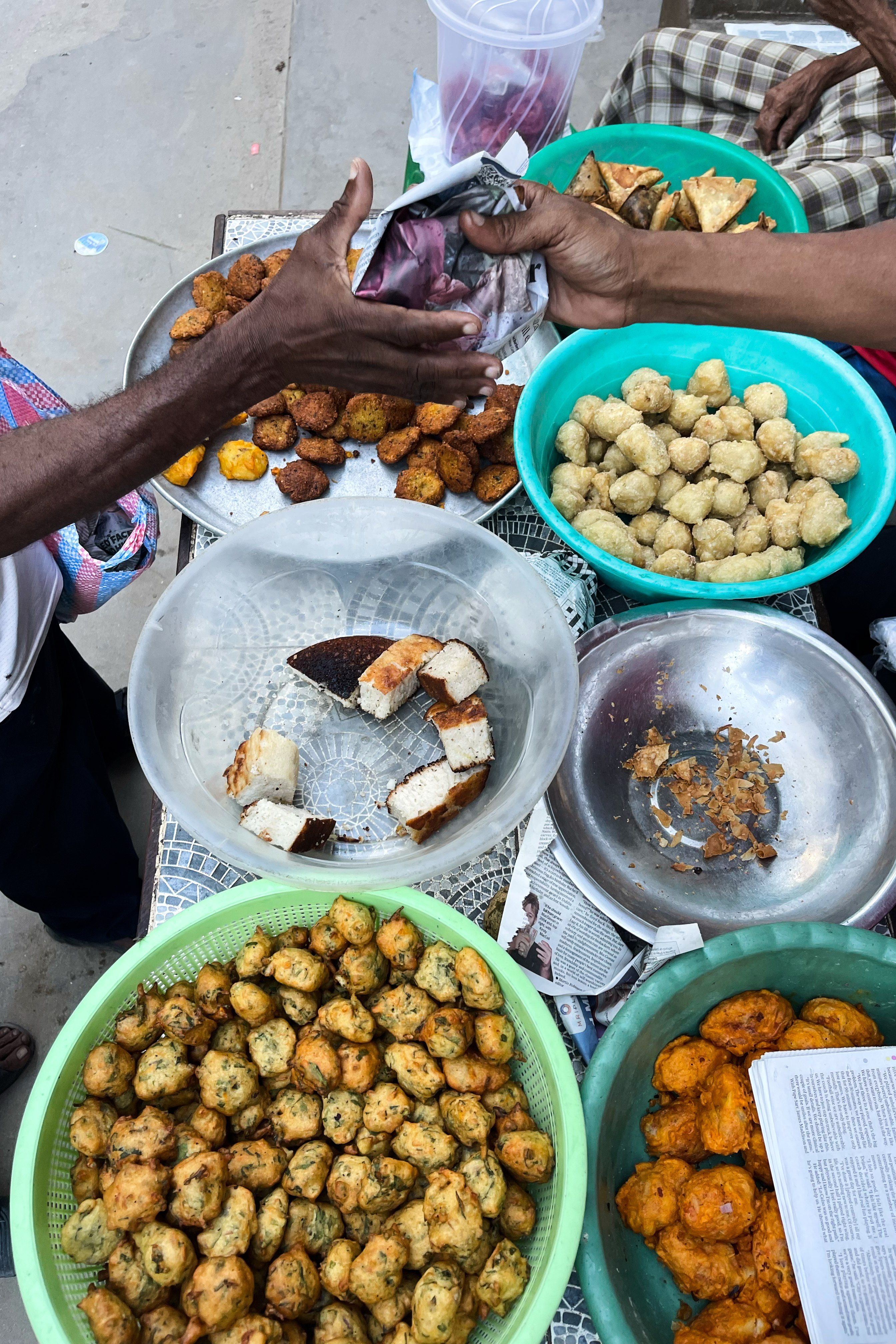
Projects
Mpishi Hula Moshi #2401
Mpishi Hula Moshi
Food Methodologies
With a diverse group of five researchers differing in age, gender, and cultural background, we began by reflecting on our positionality as individuals from various parts of the world. Starting with a simple task of cooking and sharing meals together as team members, food preparation and consumption initiated our journey in order to better connect and understand each other and the focus of our research. This approach aimed to immerse ourselves in local culinary practices and traditions and, depending on our sensory perceptions shaped by the immediate surroundings, to guide and inform our interpretations. The practice of collaborative research has allowed us to better "cook" our research interests, which lies in understanding how food, as an absolute good for all living organisms, entails practices in a social environment that varies from culture to culture.
With a diverse group of five researchers differing in age, gender, and cultural background, we began by reflecting on our positionality as individuals from various parts of the world. Starting with a simple task of cooking and sharing meals together as team members, food preparation and consumption initiated our journey in order to better connect and understand each other and the focus of our research. This approach aimed to immerse ourselves in local culinary practices and traditions and, depending on our sensory perceptions shaped by the immediate surroundings, to guide and inform our interpretations. The practice of collaborative research has allowed us to better "cook" our research interests, which lies in understanding how food, as an absolute good for all living organisms, entails practices in a social environment that varies from culture to culture.
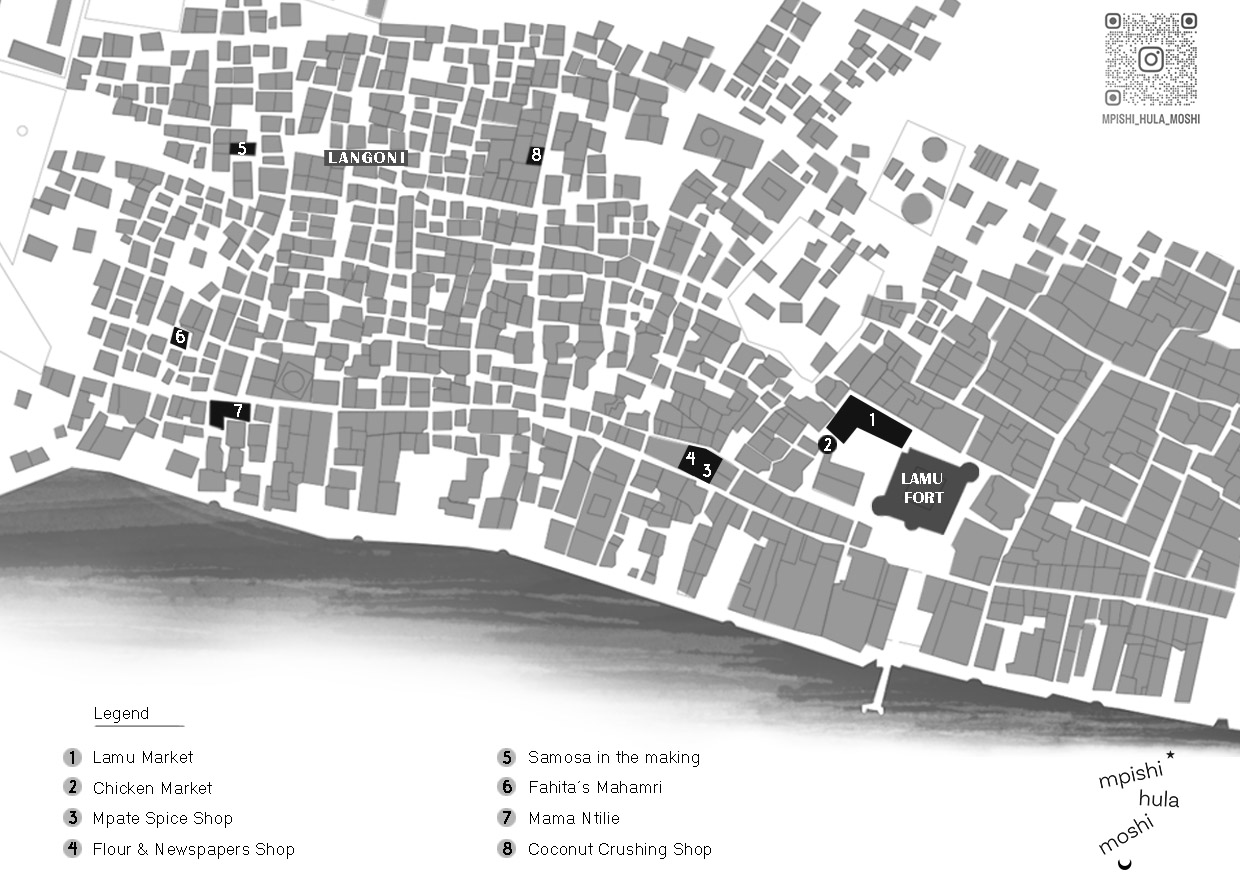 Lamu Foodscape Journey: Mapping Six Weeks of Food Stories
Lamu Foodscape Journey: Mapping Six Weeks of Food Stories Foodscapes are defined by the food practices that create the character of a place. As we were collecting food stories, a map of our research path was developed covering the stories of recipes, ingredients, tools, challenges, and opportunities embodied in the processes of preparing, selling, sharing, and eating food on a daily basis.
Lamu Food Stories
A Space for Aspiration - Farzana’s Story
![]()
Farzana’s kitchen is a cramped, three-square-metre space with no windows or ventilation. It serves as both a workspace for household duties and a small business, with shelves packed with tools for every cooking need. Her equipment blends traditional and modern: a multi-cooker for speed, a gas oven for power cuts, and a charcoal burner as a backup. Limited by space, her tools spill into other rooms.

Farzana’s kitchen is a cramped, three-square-metre space with no windows or ventilation. It serves as both a workspace for household duties and a small business, with shelves packed with tools for every cooking need. Her equipment blends traditional and modern: a multi-cooker for speed, a gas oven for power cuts, and a charcoal burner as a backup. Limited by space, her tools spill into other rooms.
For Farzana, cooking is both a duty and a creative outlet. She personalizes meals with secret ingredients, adapts broken tools, and tries TikTok-inspired recipes. Cooking lets her care for her family’s health and gives her a rare space for self-expression, constrained by cultural traditions in Lamu. Her investment in modern tools reflects her desire to ease her domestic load and expand her small food business from home, symbolizing a broader tension between tradition and modernity where personal and professional aspirations meet.
This dual pursuit - seeking efficiency in household chores while aspiring to economic activities centered on the home space reflects a larger picture in Lamu. It is a nuanced balance between tradition and modernity a negotiation of space where personal and professional aspirations converge.
Biryani Night - The Story of Many Hands for One Dish

In our journey to unveil the different scales and spaces of food-making, the preparation of wedding food marks a traditional festivity rich with socio-cultural stories and connections. In a one-night setup to prepare biryani, a traditional wedding meal, an often invisible social infrastructure comes to life where private and commercial aspects merge while maintaining the societal hierarchy. In this setup, the top supervisory roles were held by the adult men of the family, who oversaw the preparations.
Below them were two paid chefs from Mombasa, assisted by younger male family members or, in wealthier families, hired helpers. The most basic tasks were assigned to women, who were close family members or friends. Biryani preparation becomes a rare and valuable opportunity for women to connect and socialize away from their daily lives, which are still shaped by strict social norms and extensive domestic responsibilities. The community hall nonetheless transforms into a space for women to breathe, engage in self-making, and bond socially through chanting, dancing, and small conversations around food trays.
Lost Recipes, Lost Connections - A Recipe’s Story

With our desire to explore Lamu's traditional dishes through hands-on learning, we focused on local, typical ingredients that require simple preparation. Bananas, coconut, and sugar seemed simple in theory but led us to discover the creativity and variety employed by locals to create two distinct dishes: Mazu (or Ndizi za Nazi), a familiar dessert for Lamu residents, and Mboko, a fading recipe at risk of being forgotten.
What began as a goal to exchange knowledge, practices, food, and joy within our group evolved into recording one of many unwritten food archives that are gradually disappearing, along with the stories of the women who invented and once cooked these dishes.
A Space of Experimentation - Asma’s Story

Carrying on her family’s heritage in the food business and driven by a desire to have a self-independent work, Asma—fondly known as “Mama Ntilie” by those who visit her small outdoor kitchen—introduces a new dimension of Lamu food stories.
For 24 years, her corner of the street witnessed her innovations in the Lamu food business, demonstrated by the arrangement of her cooking platform to accommodate both the family business and her customers’ needs.
The display of her cooking tools, the preparation of the jiko for a live cooking experience, and the promotion of various homemade dishes on her small table—some made by other women in the family— all contribute to transforming the place into a warm and comfortable dine-in experience for repeated customers, embodying the genuine warmth and hospitality of a true ‘Mama Ntilie.’
The display of her cooking tools, the preparation of the jiko for a live cooking experience, and the promotion of various homemade dishes on her small table—some made by other women in the family— all contribute to transforming the place into a warm and comfortable dine-in experience for repeated customers, embodying the genuine warmth and hospitality of a true ‘Mama Ntilie.’
A Space of Resilience - Fahita’s Story

We approached Fahita to learn more about her mahamri, by some accounts the best mahamri in town. In a quiet, narrow alley blackened from years of wood smoke, Fahita makes mahamri each day. She buys the ingredients from the same place—she has her person. She cuts and shapes them here, but the dough is mixed off-site at her in-laws' shop, where they have a standing mixer suitable for larger amounts of dough needed for her small mahamri business.
We learn that one aspect that makes this mahamri popular is that they taste, look, and feel homemade—something that gets lost in commercialized baking.
The steps of mahamri making start inside the house—shaping the triangular mahamri, rolling a small disc, and cutting it into quarters, which are then stacked and set aside. Fahita then moves outside to her usual corner to start the frying. As she begins frying she becomes quiet. The dough triangles are tossed into the oil; they inflate and become a dark orange-gold before being turned out into a colander to drain off excess oil. Fahita says a small prayer each time she fries another batch. We depart with hot mahamri wrapped in newspaper advertising discounts on electronics.
The steps of mahamri making start inside the house—shaping the triangular mahamri, rolling a small disc, and cutting it into quarters, which are then stacked and set aside. Fahita then moves outside to her usual corner to start the frying. As she begins frying she becomes quiet. The dough triangles are tossed into the oil; they inflate and become a dark orange-gold before being turned out into a colander to drain off excess oil. Fahita says a small prayer each time she fries another batch. We depart with hot mahamri wrapped in newspaper advertising discounts on electronics.
Exhibition
The stories and characters featured on this page became part of an exhibition at the Lamu Fort Museum in May 2024, where the collaborative work was shared with the people of Lamu. A folded map served as a key to the exhibit, allowing visitors to journey from story to story - not only within the exhibition but also to discover these places and people throughout the city.
By gathering recipes, stories, and symbolic objects, the exhibition aimed to show how food bridges the global and local, uniting past traditions with modern technologies, personal expressions with collective identities.
Through preparing, sharing, and enjoying food, it becomes a creative medium that reimagines the connections between bodies, places, and time.





Mama na Bahari
“Mama na Bahari” investigates the transformative role of women in Lamu’s fishing industry, particularly through their involvement in projects like sustainable octopus closures.
It asks, how do social identities and the community roles of women in Lamu evolve through their engagement in the fishing industry? How do gender dynamics and cultural practices influence women's roles and participation in environmental conservation efforts in Lamu, Kenya? By examining these initiatives and women’s activism, our research highlights how women’s participation is reshaping community structures, redefining, and challenging traditional roles. These sustainable practices not only enhance environmental conservation but also elevate women’s standing within the community, contesting long-held gender norms.
![]()
The research underscores the pivotal contributions of women in fostering economic adaptability and environmental stewardship in Lamu. Through these initiatives, women become agents of change, reshaping local perceptions of gender roles and actively contributing to Lamu’s socio-economic landscape.
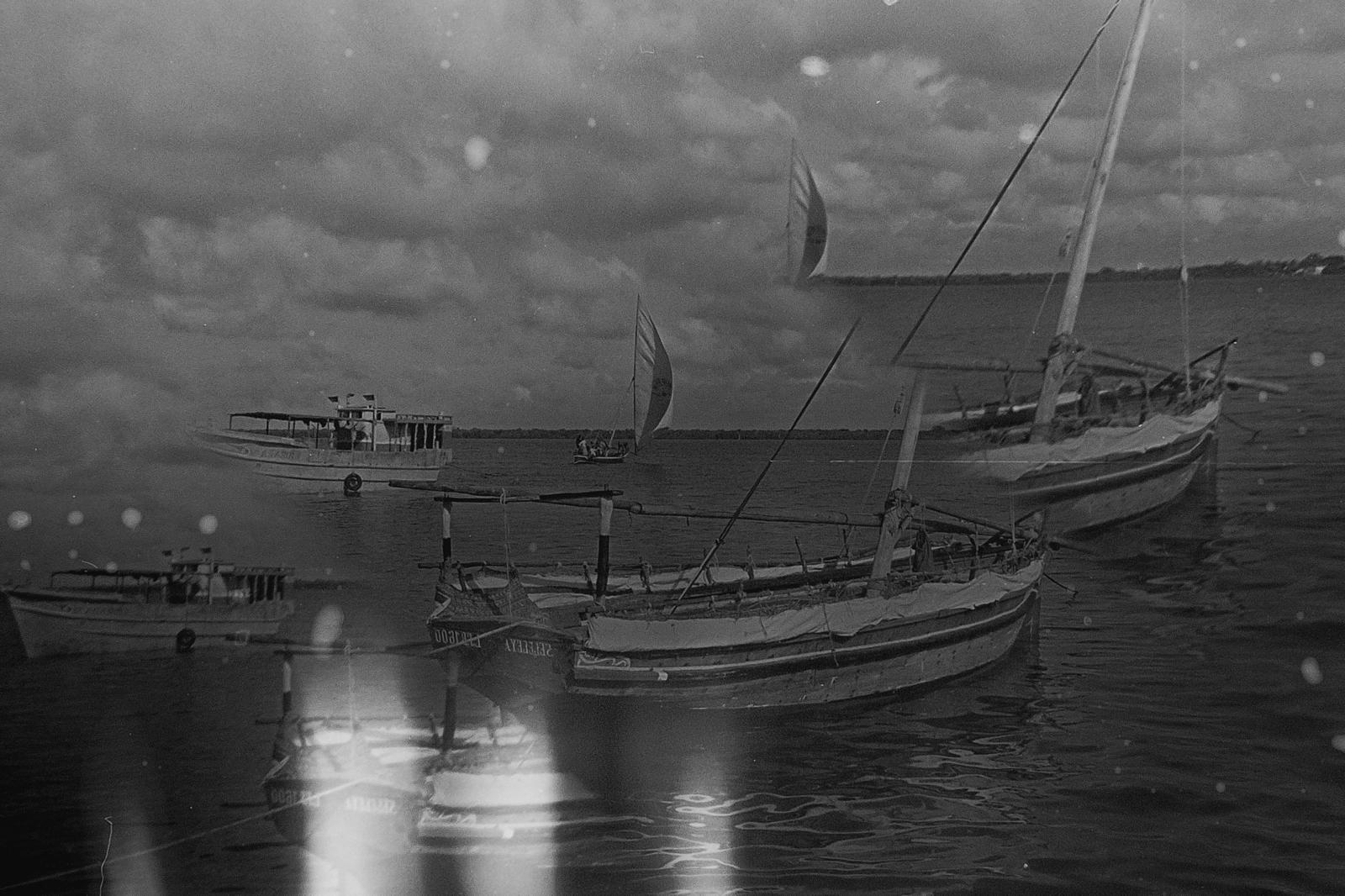
The research underscores the pivotal contributions of women in fostering economic adaptability and environmental stewardship in Lamu. Through these initiatives, women become agents of change, reshaping local perceptions of gender roles and actively contributing to Lamu’s socio-economic landscape.
This project offers a comprehensive view of how women are reimagining their place within the fishing industry, interweaving the intersections of gender, economy, and environmental sustainability to build a more inclusive and empowered future.

Projects
Introduction
This project investigates the intersection of Islamic feminism, decolonial feminism, and environmental justice in Lamu, Kenya, with a focus on women’s roles in environmental conservation and social justice within the fishing industry.
Using an intersectional approach, it highlights the complex socio-cultural and economic barriers that shape women’s experiences, revealing the ways in which gender, environment, and power are interconnected.
![]()
This project investigates the intersection of Islamic feminism, decolonial feminism, and environmental justice in Lamu, Kenya, with a focus on women’s roles in environmental conservation and social justice within the fishing industry.
Using an intersectional approach, it highlights the complex socio-cultural and economic barriers that shape women’s experiences, revealing the ways in which gender, environment, and power are interconnected.
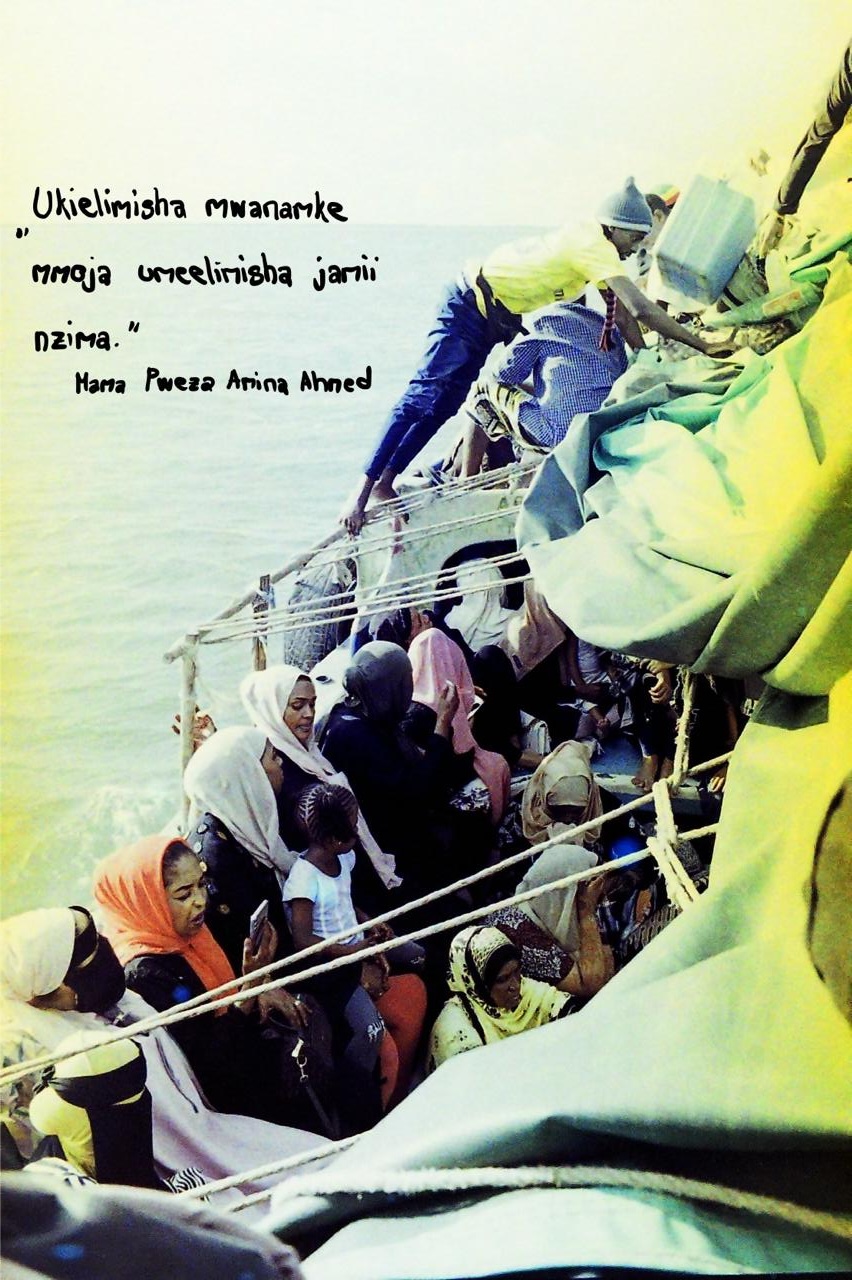
Through interviews, group discussions, participatory observations, and literature review, the study emphasizes the critical role of women in addressing climate-related challenges, such as droughts and floods, which disproportionately impact their lives and livelihoods.
The Mama na Bahari exhibition serves as a central element of the research, demonstrating the significant influence of women’s conservation efforts and their contributions to both the environment and society.
Findings suggest that environmental justice in Lamu cannot be achieved without gender justice, and this paper advocates for an integrated approach that combines both.
Sustainable Futures
Women in Lamu’s fishing industry face numerous challenges, particularly those exacerbated by climate change. These include not only environmental pressures like rising sea levels and unpredictable weather patterns but also socio-cultural restrictions that limit their mobility and participation in the industry.
The paper documents that women, who are often responsible for household duties, are more vulnerable during environmental crises. During floods, for example, women’s caregiving roles increase their exposure to danger, limiting their ability to seek safety. Moreover, health risks for women are amplified, as climate change contributes to increased incidences of stillbirths and diseases such as malaria and Zika. The intersection of these issues underscores the urgent need for gender-sensitive policies that recognize the unique vulnerabilities faced by women.
![]()
Local organizations, such as the Lamu Women Alliance, play a vital role in supporting women in overcoming these barriers. They advocate for what they call a “girl code” of solidarity to counter political and social challenges, including harassment and exclusion from decision-making processes. The need for comprehensive educational programs and greater support from both governmental and non-governmental organizations is also highlighted, particularly programs that incorporate indigenous knowledge and are sensitive to local cultural values.
The paper documents that women, who are often responsible for household duties, are more vulnerable during environmental crises. During floods, for example, women’s caregiving roles increase their exposure to danger, limiting their ability to seek safety. Moreover, health risks for women are amplified, as climate change contributes to increased incidences of stillbirths and diseases such as malaria and Zika. The intersection of these issues underscores the urgent need for gender-sensitive policies that recognize the unique vulnerabilities faced by women.
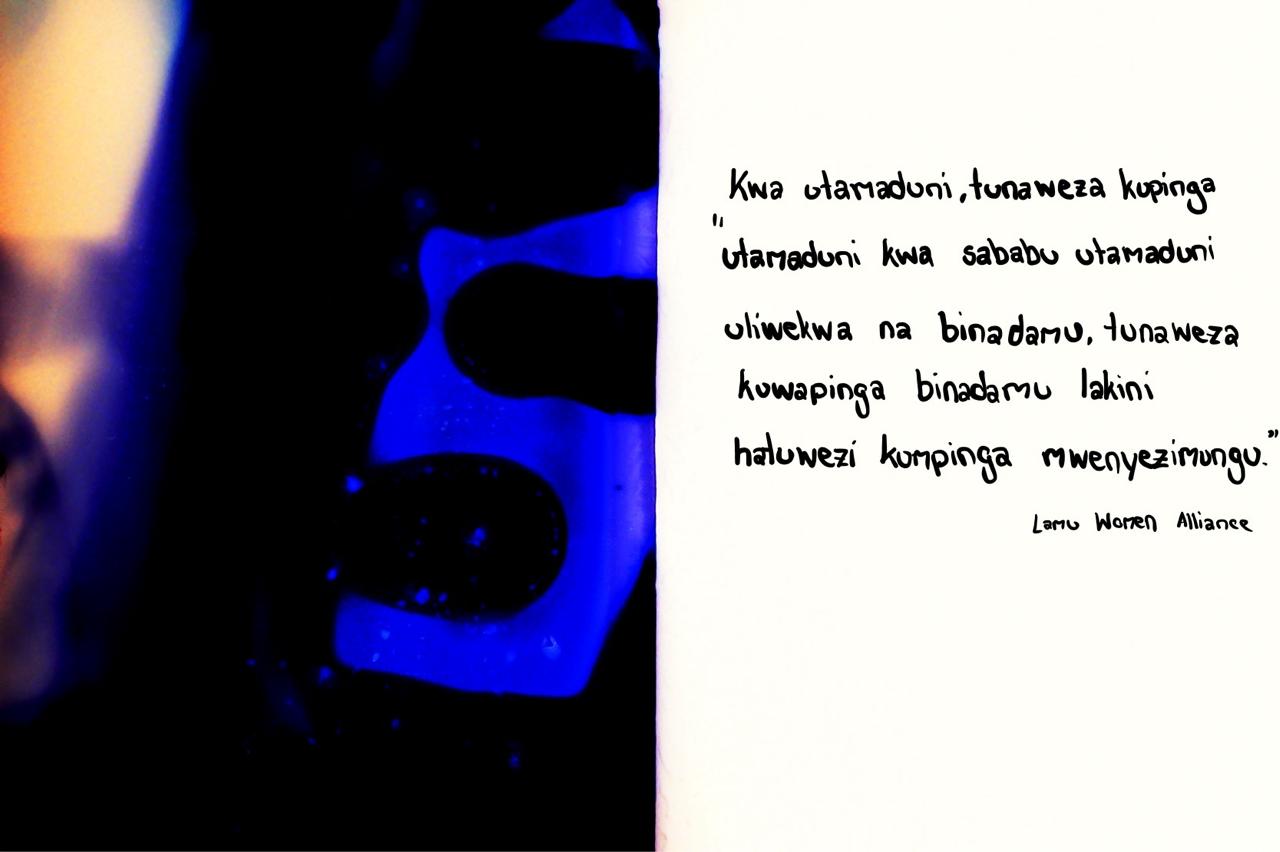
Local organizations, such as the Lamu Women Alliance, play a vital role in supporting women in overcoming these barriers. They advocate for what they call a “girl code” of solidarity to counter political and social challenges, including harassment and exclusion from decision-making processes. The need for comprehensive educational programs and greater support from both governmental and non-governmental organizations is also highlighted, particularly programs that incorporate indigenous knowledge and are sensitive to local cultural values.
The Faza Youth Action Group similarly addresses historical injustices, aiming to amplify marginalized voices and promote equal inclusion. The contributions of these groups emphasize that gender equality is essential for achieving environmental justice in Lamu, where socio-cultural and economic limitations have historically restricted women’s participation in sustainability efforts.
The research explores decolonial and Islamic feminist frameworks to understand how colonial legacies and religious principles influence environmental policies and gender norms in Lamu. Decolonial feminism critiques the enduring effects of colonialism, capitalism, and imperialism, challenging global structures that perpetuate inequality and exploitation. By valuing indigenous knowledge and amplifying marginalized voices, this perspective seeks to dismantle oppressive systems and promote self-determination for women in Lamu.
Islamic feminism, in turn, provides a framework for advancing gender justice within the context of Islamic principles, allowing women to engage in conservation and leadership roles without directly challenging religious beliefs.
For instance, the following statement from an interviewee of the Faza Youth Action Group reflects how women differentially challenge social and religious structures:
The research explores decolonial and Islamic feminist frameworks to understand how colonial legacies and religious principles influence environmental policies and gender norms in Lamu. Decolonial feminism critiques the enduring effects of colonialism, capitalism, and imperialism, challenging global structures that perpetuate inequality and exploitation. By valuing indigenous knowledge and amplifying marginalized voices, this perspective seeks to dismantle oppressive systems and promote self-determination for women in Lamu.
Islamic feminism, in turn, provides a framework for advancing gender justice within the context of Islamic principles, allowing women to engage in conservation and leadership roles without directly challenging religious beliefs.
For instance, the following statement from an interviewee of the Faza Youth Action Group reflects how women differentially challenge social and religious structures:
“We can fight the culture because that was made by humans. We can challenge humans, but we cannot challenge God.”
Initiatives
In addition to these feminist perspectives, this research illustrates how women-led initiatives are essential to sustainable development and social justice. Community projects such as coral reef restoration and octopus closures are examples of how environmental sustainability and economic independence are intertwined. Women in these initiatives challenge traditional gender roles, contributing both financially and socially to their communities while promoting ecological balance. Education is central to these efforts, fostering awareness of environmental issues and reinforcing women’s capacity to advocate for their rights.
The research finds that women’s involvement in Lamu is often defined within cultural contexts; as one member of the Lamu Women Alliance described, empowerment means “changing the way of life to the culture.” Similarly, the Faza Youth Action Group observed that the empowerment process has elevated women’s self-worth and expanded their roles within the community. Such culturally specific understandings of empowerment align with decolonial feminism’s goal to respect local values and resist external influences. The interconnections between gender, religion, and culture thus shape women’s leadership and environmental activism in complex ways.
The research finds that women’s involvement in Lamu is often defined within cultural contexts; as one member of the Lamu Women Alliance described, empowerment means “changing the way of life to the culture.” Similarly, the Faza Youth Action Group observed that the empowerment process has elevated women’s self-worth and expanded their roles within the community. Such culturally specific understandings of empowerment align with decolonial feminism’s goal to respect local values and resist external influences. The interconnections between gender, religion, and culture thus shape women’s leadership and environmental activism in complex ways.
The gendered division of labor and women’s disproportionate vulnerability to climate change highlight the importance of integrating gender perspectives into environmental justice. Community-led aspirations for environmental conservation align with economic activities, enabling women to develop strength and self-sufficiency. However, while women bear many responsibilities in their roles as primary caregivers, they often lack formal recognition and support. Local women’s knowledge, rooted in their cultural heritage and everyday experiences, is invaluable in promoting sustainable practices, as illustrated by their roles in conservation initiatives and traditional fishing practices.
The research emphasizes that sustainability and social justice must go hand in hand, particularly in the context of women’s contributions to environmental conservation in Lamu.
Participants frequently echoed the sentiment that “There is no climate justice without gender justice,” underscoring that sustainability efforts must be inclusive to be effective.
The Lamu Women Alliance advocates for integrating these principles into environmental policies to address gender-specific challenges and ensure women’s participation in leadership roles. The study illustrates that women’s voices are essential to sustainable development.
![]()
The research emphasizes that sustainability and social justice must go hand in hand, particularly in the context of women’s contributions to environmental conservation in Lamu.
Participants frequently echoed the sentiment that “There is no climate justice without gender justice,” underscoring that sustainability efforts must be inclusive to be effective.
The Lamu Women Alliance advocates for integrating these principles into environmental policies to address gender-specific challenges and ensure women’s participation in leadership roles. The study illustrates that women’s voices are essential to sustainable development.
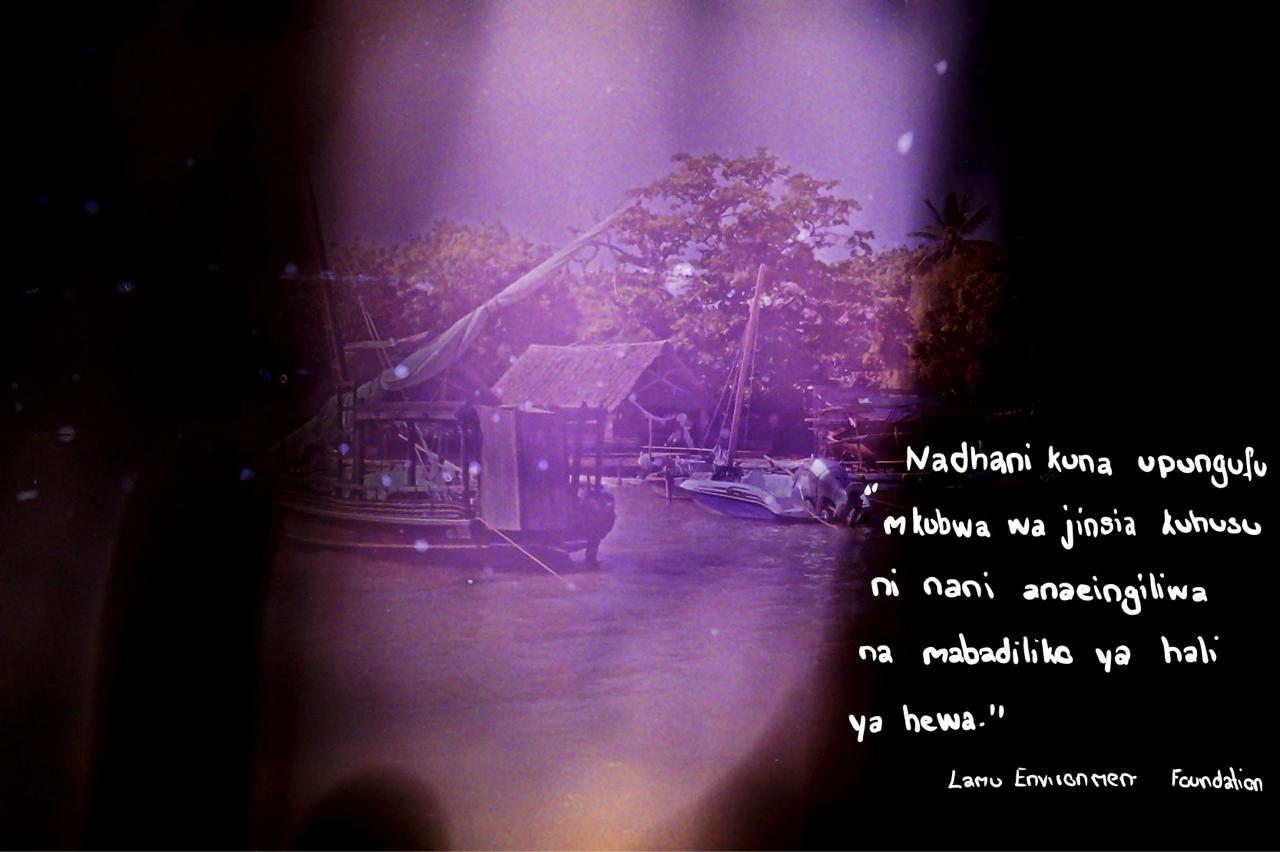
Conclusion
This research underscores the importance of integrating gender justice with environmental sustainability, advocating for policies that support women’s roles in conservation and address the socio-cultural barriers they face. Women’s leadership in Lamu demonstrates the transformative potential of decolonial and ecofeminist frameworks, which challenge global structures of inequality and foreground indigenous knowledge and local empowerment.
These findings illustrate that achieving environmental justice requires acknowledging and addressing gendered inequalities, recognizing women as key contributors to environmental preservation and community resilience.
Through their collective efforts, women in Lamu not only contribute to the local ecosystem but also foster a more equitable and sustainable future for their community.
This research offers valuable insights for policymakers, highlighting the need for inclusive approaches to environmental justice that respect cultural identities and promote gender equity within sustainability practices.

Mama na Bahari #2407
This research project examines the role of women in the fishing industry on Lamu Island, Kenya, where men typically dominate the field. Women primarily engage in fish processing and, in some cases, specialize in octopus fishing.
This project explores how these women navigate traditional boundaries, how cultural expectations shape their participation, and the socio-economic impacts of their contributions.
Their involvement challenges traditional gender norms within the culturally conservative, Muslim-majority society of Lamu.
This project explores how these women navigate traditional boundaries, how cultural expectations shape their participation, and the socio-economic impacts of their contributions.
Context and objectives
The fishing industry in Lamu is vital to the community. Fishing is traditionally seen as men’s work, particularly deep-sea fishing, which is physically demanding and requires specialized skills.
Women’s participation has been largely restricted to shore-based activities like fish processing, trading, and small-scale, near-shore fishing, such as octopus harvesting. This gendered division reflects deep-rooted cultural norms and Islamic teachings, which influence gender roles in Lamu.
Women’s participation has been largely restricted to shore-based activities like fish processing, trading, and small-scale, near-shore fishing, such as octopus harvesting. This gendered division reflects deep-rooted cultural norms and Islamic teachings, which influence gender roles in Lamu.
My central research question is: “What factors and societal values influence women’s participation in the fishing industry in Lamu?”
The study’s objectives include understanding the cultural and religious norms that shape women’s work, examining the challenges they face, and assessing their economic contributions to their communities.
![]()
Findings
The findings reveal that women in Lamu’s fishing industry operate within a framework heavily influenced by cultural and religious expectations. Women’s roles remain largely tied to household responsibilities and shore-based fish processing, a key activity known locally as Mama Karanga, which aligns with conservative Islamic perspectives that assign distinct responsibilities to each gender. Furthermore, in certain areas, especially octopus fishing, women fish independently, staying closer to shore and working among themselves. The economic importance of octopus fishing has led some community elders to accept women’s involvement due to the financial benefits it brings.
Women’s involvement in the fishing industry is influenced by economic necessity, particularly due to limited employment options on the island. The fishing industry however, faces significant economic and environmental challenges. Inadequate infrastructure, like the lack of cold storage facilities, complicates fish preservation and affects women’s incomes.
Environmental issues, including the LAPSSET project, have also impacted fish availability, with pollution and changing marine conditions reducing catches and creating additional economic pressures on women.
Empowerment, as perceived by these women, is nuanced and community-oriented. Through initiatives led by organizations, women receive training and access to resources.
![]()
Women’s involvement in the fishing industry is influenced by economic necessity, particularly due to limited employment options on the island. The fishing industry however, faces significant economic and environmental challenges. Inadequate infrastructure, like the lack of cold storage facilities, complicates fish preservation and affects women’s incomes.
Environmental issues, including the LAPSSET project, have also impacted fish availability, with pollution and changing marine conditions reducing catches and creating additional economic pressures on women.
Empowerment, as perceived by these women, is nuanced and community-oriented. Through initiatives led by organizations, women receive training and access to resources.
Many interviewees expressed a sense of agency from their work, noting that financial independence helps them support their families and contribute to the community.
Empowerment is evident in the women’s ability to make household decisions and engage in collective action to address community issues, such as marine conservation.
Despite the influence of Western perspectives on empowerment, the local women’s concept is rooted in Nego-feminism (Nnaemeka 2004), a form of African feminism that emphasizes negotiation and harmony rather than confrontation. For example, many women continue to balance their fishing activities with traditional roles, such as caring for children and managing household duties, in line with conservative expectations. Women like Mama Pweza, an octopus fisherwoman, embody this approach by working in groups, thus respecting cultural norms about gender-appropriate activities while still advancing economically.
At the same time however, women’s increasing visibility and agency create tensions within the community, particularly regarding traditional expectations.
Some men and elders disapprove of women’s involvement in fishing, fearing it disrupts social structures.
It is said:
“wazee wanasema wanawake wamekuwa kichwa ngumu”, which means “Elders say women have become stubborn”.
However, the acceptance of economically beneficial activities, like octopus fishing, shows that traditional norms in Lamu can be flexible when financial incentives are evident.
Conclusion
This study illustrates how women in Lamu balance economic empowerment with traditional roles, navigating a complex social landscape shaped by cultural norms and economic necessity.
They leverage resources and opportunities within the framework of Islamic gender norms, achieving a form of empowerment that aligns with African feminist ideals of collective welfare.
Although women face significant challenges, they contribute substantially to their families and communities by adapting traditional roles to new economic contexts.
This research underscores the need for culturally sensitive empowerment initiatives that respect local customs while providing meaningful support. Ultimately, the women of Lamu are redefining empowerment on their terms, blending traditional values with economic strengths in ways that contribute positively to their community’s socio-economic and environmental sustainability.
Ways of Living with the Lamu Archipelago
Today the Lamu Archipelago is undergoing a period of change, where land and sea converge under the influence of local and global forces.
These transformations affect the ways in which the community live with their near environment, as well as more distant surroundings in various ways.
Our research aims to capture this evolving landscape through a blend of voices and perspectives, highlighting key themes:
Each perspective reflect the Lamu’s ongoing dialogue, rooted in both tradition and adaptation, as it faces environmental, social, and economic changes.
Our research aims to capture this evolving landscape through a blend of voices and perspectives, highlighting key themes:
- Promises and Pitfalls of the Blue Economy;
- Changing Performance of Fisheries in Amu;
- Experience and Sense-Making of Climate Change;
- Relations to Nature in Times of Crisis;
- Archipelagic Stories of Spirituality; and
- Managed Mangroves.
Each perspective reflect the Lamu’s ongoing dialogue, rooted in both tradition and adaptation, as it faces environmental, social, and economic changes.
Authors
Leo Witzig
Lilian Salama
Lion Tautz
Clara Alder Juul
Rukia Issa
Runzhu Qian
Projects
Ways of Living #2402
“I can read dua in Lamu and cure you in Dubai”: On the Transoceanic Circulation of Spirits
This proejct reflects on how spirituality circulates through spaces in Lamu, and what spiritual practices tell us about the islands’ transoceanic ties to other ports cities in the Indian Ocean.
“I can read dua in Lamu and cure you in Dubai,” Hashid told me one evening during my fieldwork in Lamu, after explaining the various methods he uses as a healer (mtabibu), to cure people of being overcome by spiritual forces (Field notes 25.04.2024).
We sit in the living room of his home in Lamu Old Town. The room offers a tranquil and undisturbed space for our conversation, with the exemption of his two-year-old daughter, who at times seems fairly displeased that I take up her father’s attention. Despite her young age, it occurs to me that she is somehow aware of her father’s expertise, and conscious that I, a complete stranger, have come to her home to learn.
The general term for a spiritual force in Lamu is jinn (jinns or majinni in plural). There exist good and bad jinns. The good jinns do not disturb humans, while it is believed that the bad jinns bring all sorts of misfortune to people. The process of being “taken over” or “put out of control” by a spiritual force is conceived as spirit possession or dispossession. This is where Hashid’s profound knowledge of spirituality is most evident, as he has the ability to free people from spirit possession. As a mtabibu, he carries a jinn, that together with his religious faith, serves as a guiding force in his treatments:
“I have religion in one hand, and the jinn in the other” he states, and hands me his medical license issued by the social services.
Due to Lamu’s maritime connections to other nations in the Indian Ocean, the advent of Islam has led to an enduring influence on the cultural history of the port city. This research presents a study of spirituality on Lamu Island through a relational lens. For this, I ask the following questions: How does spirituality circulate through spaces in Lamu and across geographies? And how are we as urban scholars to squeeze meaning out of these practices?
Reducing spiritual practices to fears or explanatory rationales dismisses their depth and embeddedness in Lamu society, and the ways in which people relate to other urban sites in the Indian Ocean through spirituality.
I consider relationality the starting point of connections across space and situate Lamu at the nexus of studies on spirituality (Larsen 2009, 2014; Ballarin 2009; Giles 2018; Uimonen & Masimbi 2021) and urban maritime literature (Menon et al. 2022, Mahajan 2022, Lavery & Hofmeyr 2020 Pugh 2013, Glissant 1997) to show how spirituality in Lamu creates an archipelagic space of connections between distant urban locales, that are both geographical, bodily, and more-than-material.
The first part of my study delves into the link between spirituality, water, and people, and shows how my interlocutors embody the island’s history of connectedness through spiritual practices around water (Meier 2017; Kosgei 2021). Interactions with tides reveal a deep spiritual connection to the sea, where tidal movements are seen as sacred and imbued with cleansing powers.
“I can read dua in Lamu and cure you in Dubai,” Hashid told me one evening during my fieldwork in Lamu, after explaining the various methods he uses as a healer (mtabibu), to cure people of being overcome by spiritual forces (Field notes 25.04.2024).
We sit in the living room of his home in Lamu Old Town. The room offers a tranquil and undisturbed space for our conversation, with the exemption of his two-year-old daughter, who at times seems fairly displeased that I take up her father’s attention. Despite her young age, it occurs to me that she is somehow aware of her father’s expertise, and conscious that I, a complete stranger, have come to her home to learn.
The general term for a spiritual force in Lamu is jinn (jinns or majinni in plural). There exist good and bad jinns. The good jinns do not disturb humans, while it is believed that the bad jinns bring all sorts of misfortune to people. The process of being “taken over” or “put out of control” by a spiritual force is conceived as spirit possession or dispossession. This is where Hashid’s profound knowledge of spirituality is most evident, as he has the ability to free people from spirit possession. As a mtabibu, he carries a jinn, that together with his religious faith, serves as a guiding force in his treatments:
“I have religion in one hand, and the jinn in the other” he states, and hands me his medical license issued by the social services.
Due to Lamu’s maritime connections to other nations in the Indian Ocean, the advent of Islam has led to an enduring influence on the cultural history of the port city. This research presents a study of spirituality on Lamu Island through a relational lens. For this, I ask the following questions: How does spirituality circulate through spaces in Lamu and across geographies? And how are we as urban scholars to squeeze meaning out of these practices?
Reducing spiritual practices to fears or explanatory rationales dismisses their depth and embeddedness in Lamu society, and the ways in which people relate to other urban sites in the Indian Ocean through spirituality.
I consider relationality the starting point of connections across space and situate Lamu at the nexus of studies on spirituality (Larsen 2009, 2014; Ballarin 2009; Giles 2018; Uimonen & Masimbi 2021) and urban maritime literature (Menon et al. 2022, Mahajan 2022, Lavery & Hofmeyr 2020 Pugh 2013, Glissant 1997) to show how spirituality in Lamu creates an archipelagic space of connections between distant urban locales, that are both geographical, bodily, and more-than-material.
The first part of my study delves into the link between spirituality, water, and people, and shows how my interlocutors embody the island’s history of connectedness through spiritual practices around water (Meier 2017; Kosgei 2021). Interactions with tides reveal a deep spiritual connection to the sea, where tidal movements are seen as sacred and imbued with cleansing powers.
Through rituals, Hashid uses the ebbs and flows as a medium to engage with spirits, invoking prayers to channel divine forces of the sea for protection and healing. Hashid’s practices connect him to a broader cultural and historical tapestry, reflecting an embodied spiritual relationship that links Lamu to other Indian Ocean communities.
After converging around the watery quality of spirituality in Lamu, I extend the analysis to a focus on the fringe between water and land as being a specifically dense spiritual space (Mahajan 2022; Kucher 1995).
After converging around the watery quality of spirituality in Lamu, I extend the analysis to a focus on the fringe between water and land as being a specifically dense spiritual space (Mahajan 2022; Kucher 1995). My interlocutor Yunus’ memory of a spirit encounter near the main jetty of Lamu Old Town highlights the jetty’s unique role as a liminal space, where the boundary between water and land holds spiritual intensity and guides social behaviour. The materiality and the social relations played out around the jetty-space extends Mahajan’s concept of "archipelagic relationality".
The second part of my study explores the translocal nature of jinns in Lamu, and challenges the dichotomy between human and spiritual identities, suggesting a more integrated and archipelagic relationship between the worlds. Hasid’s recalling of his friend Issa’s possession by a Russian-speaking jinn exemplifies Ensing Ho's (2006) concept of "local cosmopolitanism.” I argue that this concept extends into the spiritual realm, where jinns also embody the junctures of local and global influences, which offers a critique of Larsen’s argument (2024) that the spiritual and human world are considered separate, though they are intertwined. I rather propose that spirituality in Lamu is regarded an inseparable part of the human world.
The last and third part proposes that modernity offers alternative ways of practicing spirituality in Lamu (Meier 2017). This argument is further deepened by a comment to Dilip Menon’s argument that migration across the oceanic distances creates a scale of its own (Menon et al. 2022: 8). Based on Hashid’s remarks “I can read dua in Lamu, and cure you in Dubai”, I suggest spirituality as a scale of it own.
The last and third part proposes that modernity offers alternative ways of practicing spirituality in Lamu (Meier 2017). This argument is further deepened by a comment to Dilip Menon’s argument that migration across the oceanic distances creates a scale of its own (Menon et al. 2022: 8). Based on Hashid’s remarks (“I can read dua in Lamu, and cure you in Dubai”), I suggest spirituality as a scale of it own.
Spirituality as a scale of its own creates alternative connections between spatial, temporal, emotional and socio- political elements and provides a pathway to think space less as a surface to move on or a scene for cultural practices or beliefs, and more of a medium to think about felt connections.
By exploring the role of jinns on Lamu Island, my study reveals the role of spirituality in Lamu as a means of cultural and historical relationality to the wider Indian Ocean world, where multiple spiritual practices intersect. Together they create an archipelagic space of connections between Lamu and distant urban locals that are both geographical, bodily, and more-than-material, demonstrating that spirituality circulates through numerous spaces in Lamu and across the Indian Ocean as process and result of many relations at a time.
Ways of Living #2403
Mangroves
We were on the boat, the sky was blue and the clouds were white.
I saw a lot of mangroves above the sea, like soldiers protecting the coast. Slowly darkness fell, and the forest became as silent as the dark night.
They are so mysterious, beautiful, and reliable, and it is said that elves live in them. I don’t want to talk about elves here. I want to consider their future.
Mangroves, which are a natural and cultural element of heritage in Lamu, have received a lot of attention due to the industrialization and urbanization of Lamu. Many institutions are trying to protect and restore them, such as the KFS (Kenya Forest Service), CFAs (Community Forest Associations), NGOs, and local communities.
I saw a lot of mangroves above the sea, like soldiers protecting the coast. Slowly darkness fell, and the forest became as silent as the dark night.
They are so mysterious, beautiful, and reliable, and it is said that elves live in them. I don’t want to talk about elves here. I want to consider their future.
Mangroves, which are a natural and cultural element of heritage in Lamu, have received a lot of attention due to the industrialization and urbanization of Lamu. Many institutions are trying to protect and restore them, such as the KFS (Kenya Forest Service), CFAs (Community Forest Associations), NGOs, and local communities.
What is the relationship between these institutions? What is the relationship between mangroves and local people? And are mangroves effectively protected?
This project focuses on the relationship between mangrove conservation groups, people, and mangroves themselves. The aim is to answer the following question: What kind of restoration method can better ensure that mangroves are effectively passed on to future generations as natural and cultural heritage?
If we still have a little compassion for the remaining species, if we really put ourselves in the middle of them, we will understand that animals and plants are as alive as humans.
Based on existing research and inspired by Calkins’ “empathy with plants”(2020), this project has preliminarily and poetically explored which of the several existing restoration methods is more conducive to restoring the mangroves themselves and restoring people’s relationship with them.
If we still have a little compassion for the remaining species, if we really put ourselves in the middle of them, we will understand that animals and plants are as alive as humans.
Based on existing research and inspired by Calkins’ “empathy with plants”(2020), this project has preliminarily and poetically explored which of the several existing restoration methods is more conducive to restoring the mangroves themselves and restoring people’s relationship with them.
Lifestyle
Work at sunrise and rest at sunset.
People pray, people sing.
The boat drifting with the sea,
The starry sky in sight.
Houses in the distance,
Waves close by,
Chatty backpackers.
All tell the stories...
People pray, people sing.
Children and donkeys are crying
from time by time.
However, you do not feel noisy at all,
You feel that, this is life itself.
The boat drifting with the sea,The starry sky in sight.
Houses in the distance,
Waves close by,
Chatty backpackers.
All tell the stories...
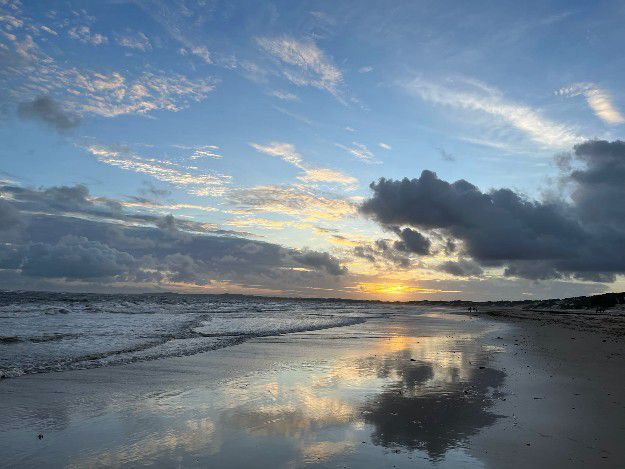
Forest and sea
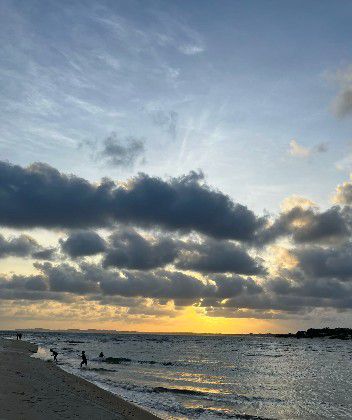
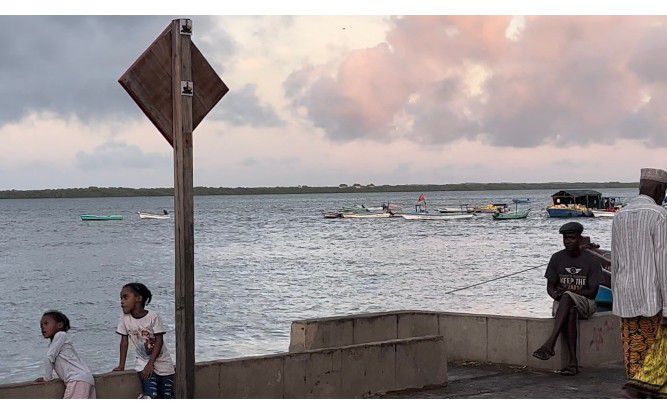
If the forest is the habitat of the soul,
then the sea is the home of the wanderer.
Rare seabirds were low in the sky,
The moon showing half its face.
The clouds are like the white breasts of swans,
People running, laughing and crying.
Day after day, year after year,
Until the end of the world...
Sometimes, the darkness
extinguished the light of the clouds,
Just like the distant dreams.
Lonely old people,
Lost middle-aged people,
And the little ones,
Who do not know what they are doing...
Ways of Living #2404
Complexity and Contradiction in Ecology
“Will we allow anthrax or cholera microbes to attain self-realization in wiping out sheep herds or human kindergartens? Will we continue to deny salmonella or botulism micro-organisms their equal rights when we process the dead carcasses of animal and plants that we eat?”
(Chakrabarty 2021, 194)We meet in Hassan’s office on the first floor. Hassan is a community organizer, and he has arranged for us to speak with an Ustadh, a Muslim teacher and leader. My co-researcher has asked Hassan to set up the interview, and she has invited me to come along. Lamu is a majority Muslim community and before the Ustadh arrives, we chat with Hassan about the rules of Islam regarding the treatment of animals. The Ustadh, a man around 30 years old wearing a football jersey, feels most comfortable speaking in Kiswahili, so Hassan has volunteered to translate. Throughout, he also offers his own opinions at various points.
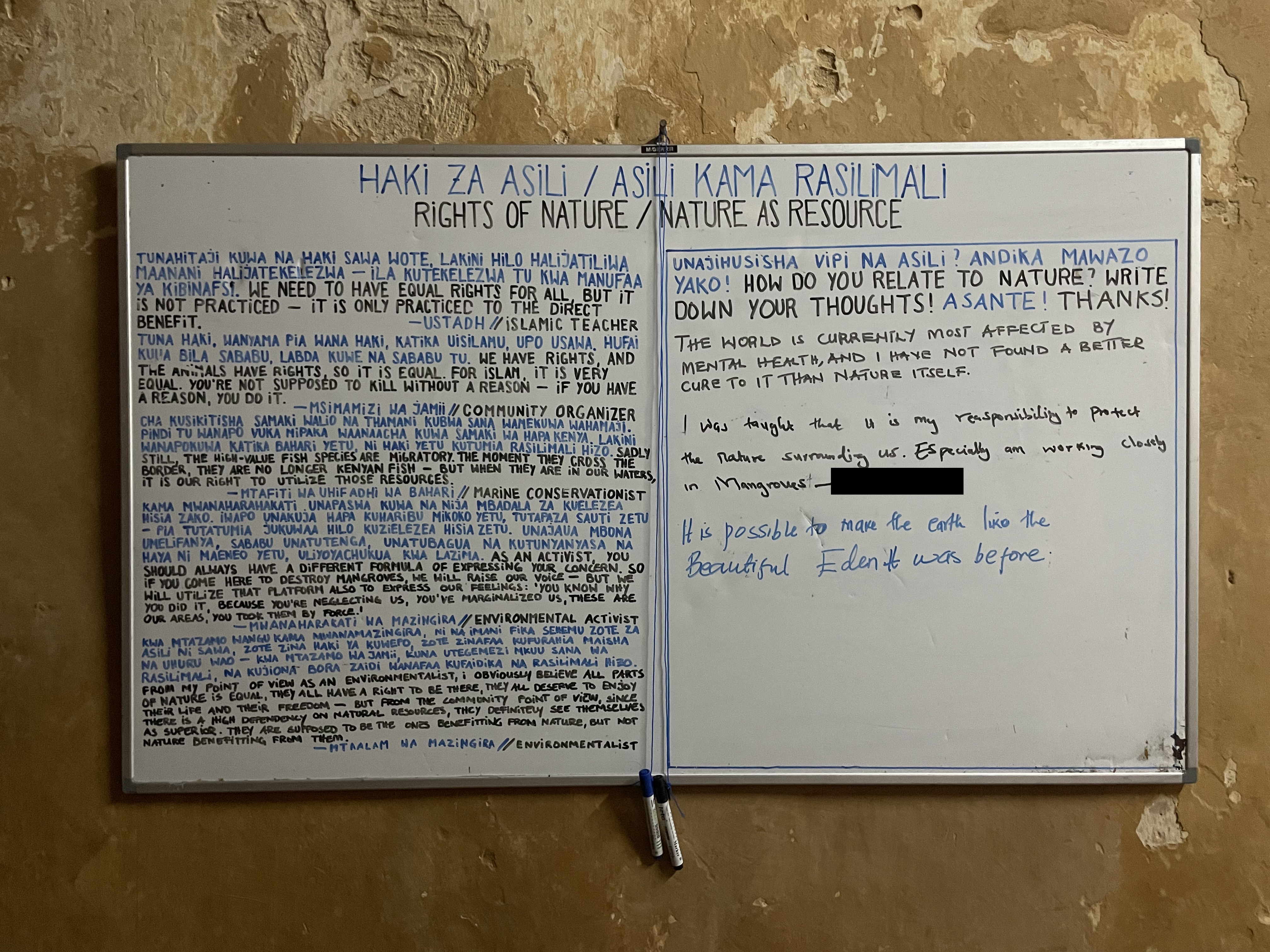
In the second half of the interview, after my co-researcher has asked her questions, we return to the topic of animals in Islam. The Ustadh explains that while the elders still follow the rules of the Qu’ran, younger people have lost their way and treat animals — from donkeys to ants — poorly. I ask if the rules extend to fish and Hassan takes a moment to explain something to me before translating:
“Okay, let me tell you something. In the sea, Islamically, everything that comes from the sea is edible.”
The Ustadh’s response is similar: “In the sea, there is no mistreatmeant. Because they're going there for fish, and fish is a meal. People will eat it, right?”
In Lamu, a historically seafaring town on the shores of the Indian Ocean, “70 percent of the local population depends on artisanal fishing.” (Lesutis 2022, p. 2438) A hierarchy of beings begins to emerge, with (differentiated) humans on top and a value-gradient of animals below. What seems at first glance to be an instance of the double fracture laid out by Malcom Ferdinand in his book Decolonial Ecology is quickly qualified by the Ustadh: “In a killing of this animal or insect, there is a way of killing. Like, for instance, we cannot kill a mosquito for consumption, right? But it's just for prevention. Because if you don't take care, we'll get malaria.” Malaria is a serious illness and can be fatal — fracture or not, preventive action is necessary for health and survival.
Still, I cannot shake the feeling that we have very different concepts of equality. Hassan explains that “we have rights, and animals have rights. So, it's equal. For Islam, it's very equal. You're not supposed to kill it without a reason. If you have a reason, you do it. […] That is Islam.” As a conscientious vegan, I want to think there is never a reason to kill a human or any other animal. One might reasonably ask what makes my drawing of the line between justified and condemnable in between plants and animals more valid than Hassan’s at the border in between animals and humans; I leave it to you, the reader, to consider this ethical quandary. No matter which version of equality you settle on, though, the Ustadh acknowledges that that is not how things are anyways:
Still, I cannot shake the feeling that we have very different concepts of equality. Hassan explains that “we have rights, and animals have rights. So, it's equal. For Islam, it's very equal. You're not supposed to kill it without a reason. If you have a reason, you do it. […] That is Islam.” As a conscientious vegan, I want to think there is never a reason to kill a human or any other animal. One might reasonably ask what makes my drawing of the line between justified and condemnable in between plants and animals more valid than Hassan’s at the border in between animals and humans; I leave it to you, the reader, to consider this ethical quandary. No matter which version of equality you settle on, though, the Ustadh acknowledges that that is not how things are anyways:
“We need to have equal rights for everything. But it is not practiced. It is only practiced to the direct benefit. […] Things are done for productivity. So, if something is not productive to me, I don't care about it. But there is a need for everything to be treated equally.”
Haki Za Asili // Asili Kama Rasilmali
Rights Of Nature // Nature As Resource
Tunahitaji kuwa na haki sawa wote, lakini hilo halijatiliwa maanani, halijatekelezwa -ila kutekelezwa tu Kwa manufaa ya kibinafsi.
We need to have equal rights for all, but it’s not practiced — it’s only practiced to the direct benefit.
Tuna haki, wanyama pia Wana haki, Katika uisilamu, upo usawa. Hufai kuua bila sababu, labda kuwe na sababu tu.
We have rights, and the animals have rights, so it is equal. For Islam, it is very equal. You’re not supposed to kill without a reason — if you have a reason, you do it.
Cha kusikitisha samaki walio na thamani kubwa sana wamekuwa wahamaji. Pindi tu wanapo vuka mipaka waanaacha kuwa samaki wa hapa Kenya. Lakini wanapokuwa katika bahari yetu, ni haki yetu kutumia rasilimali hizo.
We need to have equal rights for all, but it’s not practiced — it’s only practiced to the direct benefit.
— Ustadh / Islamic Teacher
Tuna haki, wanyama pia Wana haki, Katika uisilamu, upo usawa. Hufai kuua bila sababu, labda kuwe na sababu tu.
We have rights, and the animals have rights, so it is equal. For Islam, it is very equal. You’re not supposed to kill without a reason — if you have a reason, you do it.
— Msimamizi wa Jamii / Community Organizer
Cha kusikitisha samaki walio na thamani kubwa sana wamekuwa wahamaji. Pindi tu wanapo vuka mipaka waanaacha kuwa samaki wa hapa Kenya. Lakini wanapokuwa katika bahari yetu, ni haki yetu kutumia rasilimali hizo.
Sadly still, the high-value fish species are migratory. The moment they cross the border, they are no longer Kenyan fish — but when they are in our waters, it is our right to utilize those resources.
— Mtafiti wa Uhifadhi wa Bahari / Marine Conservationist
Kama mwanaharahakati unapaswa kuwa na njia mbadala za kuelezea hisia zako. Iwapo unakuja hapa kuharibu Mikoko yetu, tutapaza sauti zetu — Pia tutatumia jukuwaa Hilo kuzielezea hisia zetu. Unajaua mbona umelifanya, sababu unatutenga, unatubagua na kutunyanyasa na haya ni maeneo yetu,uliyoyachukua kwa lazima.
As an activist, you should always have a different formula of expressing your concern. So if you come here to destroy mangroves, we will raise our voice — but we will utilize that platform also to express our feelings: ‘You know why you did it, because you’re neglecting us, you’ve marginalized us, these are our areas, you took them by force.’
— Mwanaharakati wa Mazingira / Environmental Activist
Kwa mtazamo wangu kama mwanamazingira, Ni na Imani fika sehemu zote za asili ni sawa,zote zina haki ya kuwepo, zote zinafaa kufurahia maisha na uhuru wao — Kwa mtazamo wa jamii, Kuna utegemezi mkuu sana wa rasilimali, na kujiona bora zaidi wanafaa kufaidika na rasilimali hizo .
From my point of view as an environmentalist, I obviously believe all parts of nature is equal, they all have a right to be there, they all deserve to enjoy their life and their freedom — but from the community point of view, since there is a high dependency on natural resources, they definitely see themselves as superior. They are supposed to be the ones benefitting from nature, but not nature benefitting from them.
As an activist, you should always have a different formula of expressing your concern. So if you come here to destroy mangroves, we will raise our voice — but we will utilize that platform also to express our feelings: ‘You know why you did it, because you’re neglecting us, you’ve marginalized us, these are our areas, you took them by force.’
— Mwanaharakati wa Mazingira / Environmental Activist
Kwa mtazamo wangu kama mwanamazingira, Ni na Imani fika sehemu zote za asili ni sawa,zote zina haki ya kuwepo, zote zinafaa kufurahia maisha na uhuru wao — Kwa mtazamo wa jamii, Kuna utegemezi mkuu sana wa rasilimali, na kujiona bora zaidi wanafaa kufaidika na rasilimali hizo .
From my point of view as an environmentalist, I obviously believe all parts of nature is equal, they all have a right to be there, they all deserve to enjoy their life and their freedom — but from the community point of view, since there is a high dependency on natural resources, they definitely see themselves as superior. They are supposed to be the ones benefitting from nature, but not nature benefitting from them.
— Mtaalam wa Mazingira / Environmentalist
Mvuvi chake ni unga– the fishermen goes with the flour
This Swahili proverb was quoted by a Lamu County executive committee member, who used it to explain the precarious situation of fishermen in Lamu today. According to him, “go with the flour” is translatable to the english proverb living from the hand to the mouth. Although fishing and fishing-related business is one of the main income sources of coastal communities in the Lamu archipelago, many fishers live day to day and with little means. In recent years, they have faced multiple challenges such as rising fuel prices and loss of access to good fishing grounds as a result of LAPSSET, a major regional infrastructure project. The health of fish populations and their ecosystems is under pressure from ocean warming, pollution, and illegal fishing practices, all of which damage the fish population and decrease overall biodiversity.
While this description depicts a challenging situation, it is only a momentary state of a dynamic field. Starting a few years ago, connected through the term Blue Economy, a plethora of programs and policies where initiated, which should help the socioeconomic development of coastal communities while introducing measures to protect life in the ocean. The Kenyan government and external actors such as the World Wildlife Foundation, the World Bank and the European Union are mobilizing the term Blue Economy in their programs with the promise to uplift fishers from poverty, develop the market capacity and meanwhile ensure a better security and environmental protection in the coastal waters.
Research goal
The goal of this research was to understand the interplay of different programs and policies active in Lamu and their related ambitions and challenges.
Therefore I approached the topic from two sides. On the one hand, I studied the context and ambitions of programs which use the term “Blue Economy” and the recent development of governing structures in the Kenyan maritime and costal domain. On the other hand, I conducted interviews with fishermen, NGO workers, and local government representatives in order to learn about the interests, lived experiences, and challenges faced in the implementation of different programs and policies.
Interventions
Current developments in the Blue Economy are heralded by stating their ambitions to help fisherfolk have more stable incomes, to protect the marine environment, and simultaneously increase production.
This should be facilitated by creating alternative income sources for some, while providing others with boats big enough to exploit the fish resources further out in the EEZ (Exclusive Economic Zone). Meanwhile, the fisherfolk practicing near coast fishing should participate in the management of the co-managed areas, in which temporary closures allow the fish population to recover.
Co-managed areas are relatively nascent and although often mentioned as a key part of the solution, they are still far from a common sight. Offshore fishing is often spoken of, but so far the Lamu Archipelago lacks the cooling infrastructure to even support the current catch.
Though many plans exist and large sums of funding have been invested, most of the fishermen still go with the flour.
Though many plans exist and large sums of funding have been invested, most of the fishermen still go with the flour.
New Markets
What will come with quite high certainty is a new landing site with cold storage capacities, an adjacent marketplace and processing plant for fish and seafood in Mokowe. This will help to build the aspired deep sea capacity and, thanks to more direct access to the international market, likely increase potential profits. Whether boat owners will stay as intermediaries or whether government initiatives to give the fisherfolk access to sell directly in the market remains to be seen when it is built.
Conflicting with the hope to get the now too numerous fisherfolk to find other occupations, the potential higher incomes enabled through this new market access combined with the scarcity of other job opportunities could have an adverse effect.
Ultimately, while changing the sector might take some time, overfishing and ocean warming induced changes are accelerating. Coral bleaching related to the 2023-2024 El Niño has shown how sensitive the coral ecosystem reacts to temperature changes. On top of that, the environmental impact the further construction and operation of the LAPSSET Port will put additional stress on the ecosystems.
Outlook
Since leaving Lamu in May 2024, compensation for livelihood loss caused by the first part of the LAPSSET Port construction was finally paid, after many years of waiting.
This spurs hopes that fishermen will be able to invest in alternative income sources or their own equipment to reduce the dependencies on boat owners as middle men.
In June 2024, massive protests against the new financial bill, which would have further increased gas prices, have forced President William Ruto to renounce the bill and replace his entire board of ministers. I conducted my research in a moment when many things were changing, on different scales at different speeds. What comes of it remains to be observed in the future.
Ng'amba // Plastic
Through the stories of local residents, our documentary film “Ng'amba: Maji yakishamwagika hayazoleki tena” (Once Water Has Been Spilled, It Cannot Be Recovered) delves into the impacts of plastic waste on the community and its environment.
It highlights the challenges in waste management, the local initiatives for handling plastics such as PET, and the economic inequalities that complicate these efforts. The films aims to raise awareness about the complex, global nature of plastic pollution and its local impact on Lamu island.
Authors
Ahmed Adhan
Ruth Lozi
Nadja Nievergelt
Henning Weiss
Ahmed Adhan
Ruth Lozi
Nadja Nievergelt
Henning Weiss
Projects
What is truly disposable?
This seemingly simple question reveals more than meets the eye. It is a question that relates to what we consider less important, less valuable, and less necessary. It encourages us to reflect on the ease with which we grant both material and immaterial things worthlessness. How is it that we view certain objects and even people as disposable, and what are the wider consequences of this disposability?
In contemporary western discourse there is frequent dialogue surrounding our consumer society, which is tied the desire to purchase new things, use, and then dispose of them, turning these objects into waste (Crocker 2012, 1,2; Goodwin et al. 2008, 1,4). That moment of an object turning into waste is often when the object is considered somebody else’s problem (Crocker 2012, 1). Waste is out of sight and out of mind (Barnes 2019, 1), encapsulated by the NIMBY syndrome meaning “Not in my back yard” (Dalzero 2021, 207). But the question is in whose back yard then? Who must carry the burden of disposability?
Working alongside two members of the Lamu Youth Alliance and a fellow student from the University of Basel, we immersed ourselves in the community's approach to plastic waste and the lives of waste pickers. As we learnt our way through the everyday landscape of discarded materials, the question of what we throw away and why stayed present in my mind during both the research and writing phases of this project. In Lamu, the discarded pieces of plastic felt like a reflection of the cultural, economic, and historical complexity of the island, showing how deeply the concept of disposability is entangled in local and global life.
In contemporary western discourse there is frequent dialogue surrounding our consumer society, which is tied the desire to purchase new things, use, and then dispose of them, turning these objects into waste (Crocker 2012, 1,2; Goodwin et al. 2008, 1,4). That moment of an object turning into waste is often when the object is considered somebody else’s problem (Crocker 2012, 1). Waste is out of sight and out of mind (Barnes 2019, 1), encapsulated by the NIMBY syndrome meaning “Not in my back yard” (Dalzero 2021, 207). But the question is in whose back yard then? Who must carry the burden of disposability?
Working alongside two members of the Lamu Youth Alliance and a fellow student from the University of Basel, we immersed ourselves in the community's approach to plastic waste and the lives of waste pickers. As we learnt our way through the everyday landscape of discarded materials, the question of what we throw away and why stayed present in my mind during both the research and writing phases of this project. In Lamu, the discarded pieces of plastic felt like a reflection of the cultural, economic, and historical complexity of the island, showing how deeply the concept of disposability is entangled in local and global life.
To delve deeper into the topic surrounding waste, particularly plastic waste and waste workers in the context of Lamu, I was inspired by Lucy Bell’s paper “Place, People, and Processes in Waste Theory: A Global South Critique” (Bell 2019). In it she critiques the fact that traditional waste theories predominantly take European and US-centered perspectives that often ignore the realities of the Global South (Ibid, 99-100). These theories usually assume a physical and ideological distance from waste, which is not the case in many communities in the Global South including, from my observations, Lamu (Ibid, 101).
Bell's critique guided me to fulfil her call to understand waste from the perspective of those who live with, on, and beside it (Bell 2019, 98).
Waste is present, it is visible and so are those who work with it.
For countless people in places like Lamu, waste is an immediate, everyday presence that affects and shapes their lives in profound ways.
Bell's critique guided me to fulfil her call to understand waste from the perspective of those who live with, on, and beside it (Bell 2019, 98).
Plastic boys
During our research, I found the story of a local plastic waste collector, Jassim, whose daily work is often stigmatized and overlooked, particularly touching (Issa Interview 2024). We shadowed Jassim in Lamu's newly built India quarter, where he gathers waste for pickup by Flipflopi, a local waste management group. India, unlike the well-kept parts of Lamu Town, relies heavily on local waste pickers like Jassim. As we began our interview, a group of young men laughingly called out to him “Rastaman”, a term which then characterized the conversation we were about to begin.
Jassim shared insights that reveal not only his daily and economic struggles, but also the broader societal attitudes towards his waste work and subsequent marginalization and stigmatization:
“Young people feel ashamed to collect these things; they feel embarrassed to be seen collecting these things; they feel they look like me”,
he remarked, his voice steady, but reflecting the burden of the societal scrutiny he is regularly facing[ML1] . Derogatory remarks like “Rastaman is crazy” further illustrate a belief system that equates waste collecting with madness or failure, ignoring its environmental significance and its societal value. In areas on Lamu’s outskirts, where no governmental waste workers are present (Lee Fieldnotes 2024a), Jassim’s role is vital yet stigmatized. This reflects a broader prejudice towards certain types of labor also seen globally, where waste work is often labeled as “dirty” or “impoverished”, the work of those who “lack economic resources” or “prospects”, closely associated with the waste they collect or even equated with the waste itself (Kornberg 2020, 148; Vázquez 2016, 127; Porras Bulla, Rendon, and Espluga Trenc 2021, 1303).
Jassim’s story raises important questions about the wider implications of waste, disposability, and invisibility.
Jassim shared insights that reveal not only his daily and economic struggles, but also the broader societal attitudes towards his waste work and subsequent marginalization and stigmatization:
“Young people feel ashamed to collect these things; they feel embarrassed to be seen collecting these things; they feel they look like me”,
he remarked, his voice steady, but reflecting the burden of the societal scrutiny he is regularly facing[ML1] . Derogatory remarks like “Rastaman is crazy” further illustrate a belief system that equates waste collecting with madness or failure, ignoring its environmental significance and its societal value. In areas on Lamu’s outskirts, where no governmental waste workers are present (Lee Fieldnotes 2024a), Jassim’s role is vital yet stigmatized. This reflects a broader prejudice towards certain types of labor also seen globally, where waste work is often labeled as “dirty” or “impoverished”, the work of those who “lack economic resources” or “prospects”, closely associated with the waste they collect or even equated with the waste itself (Kornberg 2020, 148; Vázquez 2016, 127; Porras Bulla, Rendon, and Espluga Trenc 2021, 1303).
Jassim’s story raises important questions about the wider implications of waste, disposability, and invisibility.
The stigma associated with what is often viewed as “dirty work” is not only physical, but also societal and moral, deeply impacting those who manage waste (Meiu 2020, 225-26). Meiu’s analysis highlights how plastic boys are marginalized not just for their economic status but also for handling the foreign and culturally degrading plastic objects.
This exploration into the lives of various waste workers in Lamu not only highlights the stigmatization they face, but also forces us to acknowledge and recognize their essential but overlooked contribution to our daily lives and the wellbeing of our environment. It prompts us to re-examine our notions of what constitutes valuable labor and challenges the origins of these ideas. By examining how waste is viewed as disposable, we see a parallel to how people who work with waste are similarly viewed as tainted by their association with the objects they handle. However, this stigma seems to vary depending on the context, history, and type of waste handled, suggesting that the stigma attached to waste work is not uniform, but is influenced by these factors.
![]()
Both plastic boys and waste workers, through their association with plastic, confront judgments tied to the broader implications of disposability and societal invisibility.
This exploration into the lives of various waste workers in Lamu not only highlights the stigmatization they face, but also forces us to acknowledge and recognize their essential but overlooked contribution to our daily lives and the wellbeing of our environment. It prompts us to re-examine our notions of what constitutes valuable labor and challenges the origins of these ideas. By examining how waste is viewed as disposable, we see a parallel to how people who work with waste are similarly viewed as tainted by their association with the objects they handle. However, this stigma seems to vary depending on the context, history, and type of waste handled, suggesting that the stigma attached to waste work is not uniform, but is influenced by these factors.
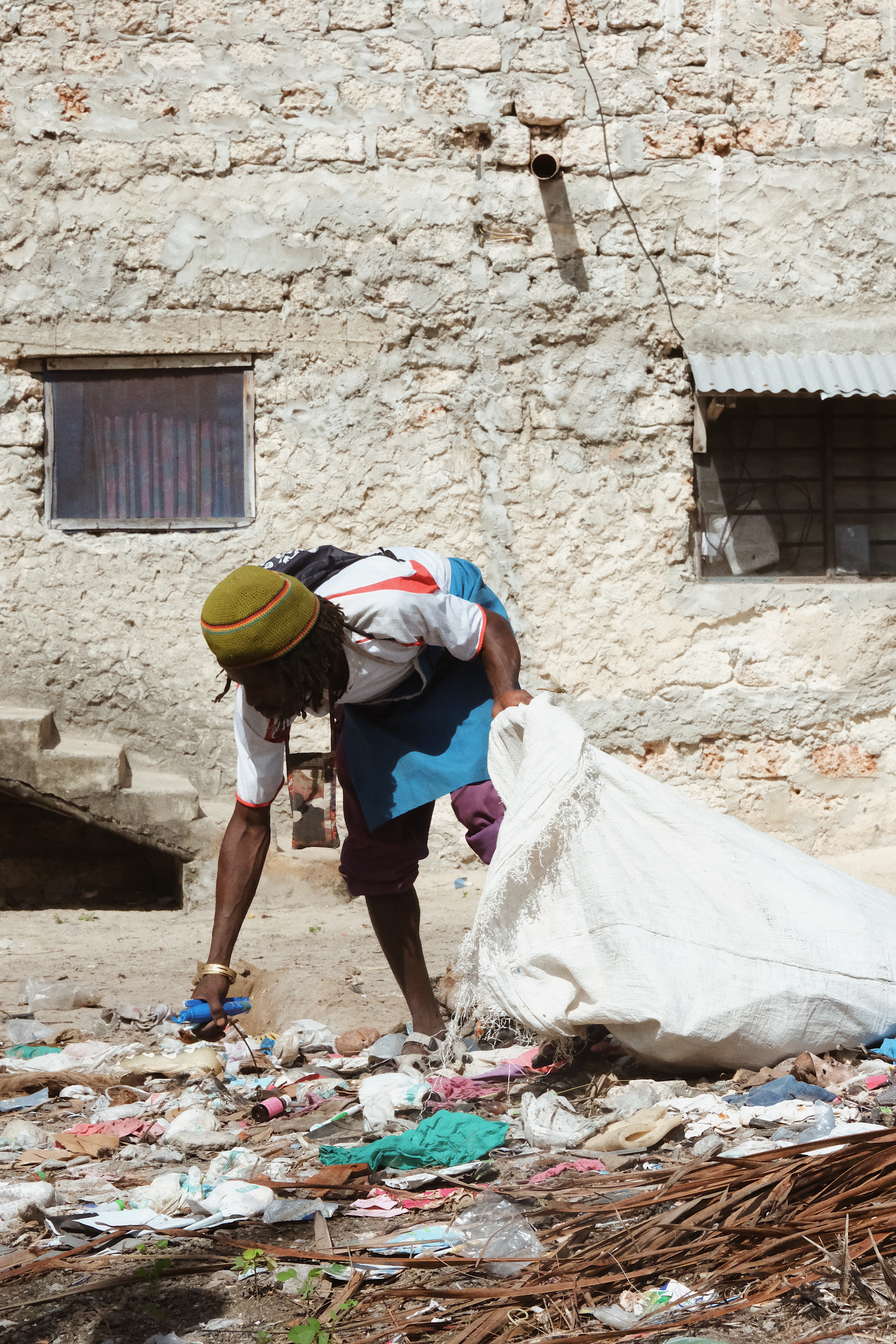
Ecologies of Belonging
How does home-building shape people’s life stories and their sense of belonging in Lamu? What do common building materials such as coral stone and mangrove wood tell us about the future of Lamu?
Most new houses on Lamu island are built with local coral stones and mangrove wood. These ancient building materials are key to Lamu’s world-famous architectural heritage, yet home-builders often integrate them with modern techniques such as poured concrete. These building practices raise pressing questions of who belongs to Lamu.
Lamu’s coral stones come from the quarry of Maweni on nearby Manda Island. Workers in this village carve the stones by hand from the coral stone bedrock of the island. They transport the stones by boat and donkey to Lamu, where they are used to build new houses on the outskirts of the historic town. Prospects of prosperity have long attracted people to work and live in Maweni, which has been a site of coral stone extraction since at least the 1980s. Many in this community of stone workers hail from western Kenya and are considered to be outsiders to the region.
Our research focused on the relationship between Lamu and Maweni. What do they share? What separates them? And how do these communities depend on each other?
Lamu’s coral stones come from the quarry of Maweni on nearby Manda Island. Workers in this village carve the stones by hand from the coral stone bedrock of the island. They transport the stones by boat and donkey to Lamu, where they are used to build new houses on the outskirts of the historic town. Prospects of prosperity have long attracted people to work and live in Maweni, which has been a site of coral stone extraction since at least the 1980s. Many in this community of stone workers hail from western Kenya and are considered to be outsiders to the region.
Our research focused on the relationship between Lamu and Maweni. What do they share? What separates them? And how do these communities depend on each other?
Building a house out of permanent materials is a common aspiration. Yet living in Lamu and Maweni comes with very different challenges. While most inhabitants of Lamu’s neighborhoods enjoy tenure, the inhabitants of Maweni face precarity and the risk of eviction. Few of their homes are built with the precious stones around which they have organized their livelihoods. Most homes in Maweni are made out of a combination of thatch, mud, and wood. Despite these inequalities, residents’ lives in both Lamu and Maweni are interlaced with complex stories of aspiration and belonging that are not contained by either of these locations.
Our urban research with community organizers, stone masons, house builders, home owners, and neighborhood residents combined hand drawing with photography, mapping, interviews and ethnographic walks. We used drawings and maps to convey the ecological relations of belonging that structure these stories. Someone’s sense of belonging cannot be easily pinned on a map or represented in a drawing, yet the dialogical practice of drawing together with community members allowed us to better understand what it means to belong.
Our urban research with community organizers, stone masons, house builders, home owners, and neighborhood residents combined hand drawing with photography, mapping, interviews and ethnographic walks. We used drawings and maps to convey the ecological relations of belonging that structure these stories. Someone’s sense of belonging cannot be easily pinned on a map or represented in a drawing, yet the dialogical practice of drawing together with community members allowed us to better understand what it means to belong.
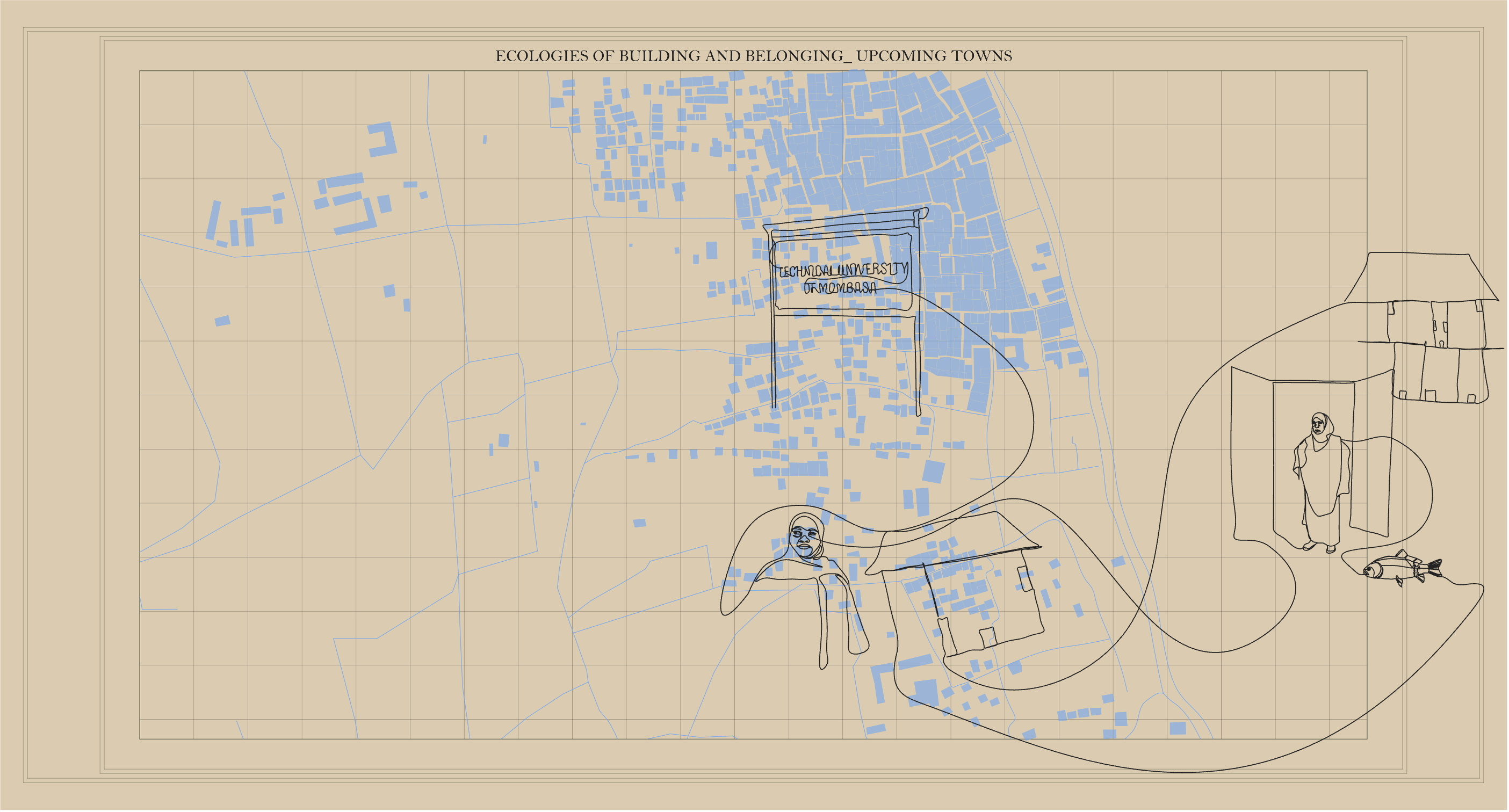
Nasba’s story
Nasba comes from the coastal area of Kiwayuu, she is Swahili and Muslim. Nasba’s father is a fisherman and her mom owns a shop. She moved to Lamu Island for her studies because the university was close to home. She has been living in Lamu town ever since. Nasba still goes and visit her family in Kiwayuu - she buys groceries in Lamu and brings them to her mother’s shop. She initially lived with relatives and later moved from one rental apartment to another in the town.
Nasba comes from the coastal area of Kiwayuu, she is Swahili and Muslim. Nasba’s father is a fisherman and her mom owns a shop. She moved to Lamu Island for her studies because the university was close to home. She has been living in Lamu town ever since. Nasba still goes and visit her family in Kiwayuu - she buys groceries in Lamu and brings them to her mother’s shop. She initially lived with relatives and later moved from one rental apartment to another in the town.
This is why Nasba says she has so many neighbors. She greets all of them when she walks her streets. Today, she lives in Bombay, one of the new neighborhoods on the outskirts of the historic town. She rents an apartment there and has a close relationship with her neighbors, who she says are like family. In the future, Nasba wants to invest and build a big house back in Kiwayuu, and she also wishes to own a shop there. But she can also imagine living in Lamu, buying a plot of land and building a house of her own.
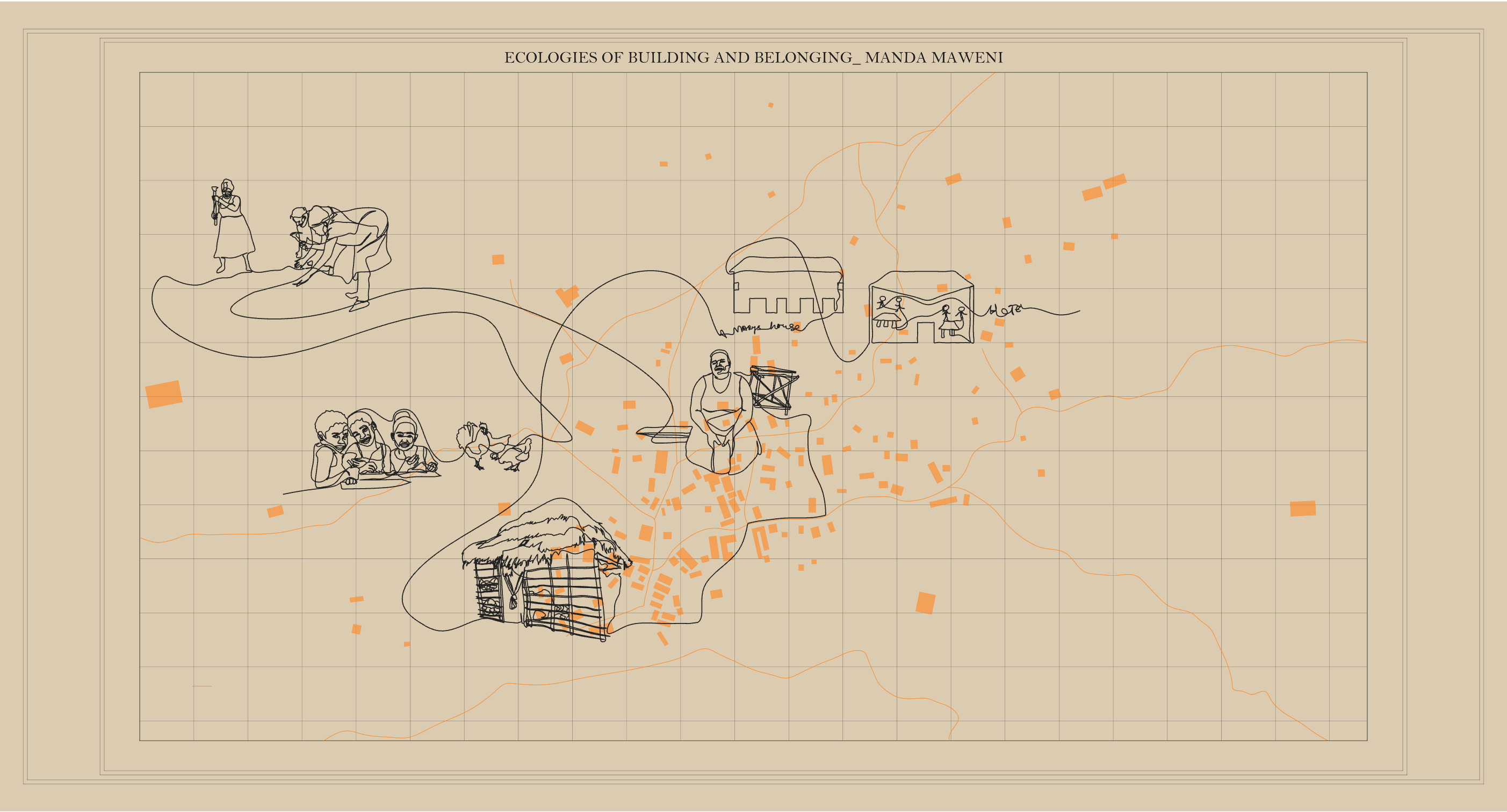
Mary’s story
Mary was born in central Kangundo in Machakos County. She is Christian and identifies as Kamba. She was brought up in Mpeketoni, where she attended school and learned Kiswahili and English. Her parents could not fully finance her education, so she started working on a farm when she was still young. Her husband was an alcoholic and could not provide for their four children. She divorced him and moved to Maweni for work all by herself. She first lived in a rented house and started working in the quarry to save money for her childrens’ education.
Mary was born in central Kangundo in Machakos County. She is Christian and identifies as Kamba. She was brought up in Mpeketoni, where she attended school and learned Kiswahili and English. Her parents could not fully finance her education, so she started working on a farm when she was still young. Her husband was an alcoholic and could not provide for their four children. She divorced him and moved to Maweni for work all by herself. She first lived in a rented house and started working in the quarry to save money for her childrens’ education.
After ten years of hard work, she saved enough money to take over a restaurant lease and build a house of her own. She is currently renovating it with a tin roof and wishes to build a four-bedroom house. In the future, Mary also wants to build her own restaurant and manage employees in order to welcome more customers. Mary may decide to return to Mpeketoni in the future, but she does not think there will be work for her there.
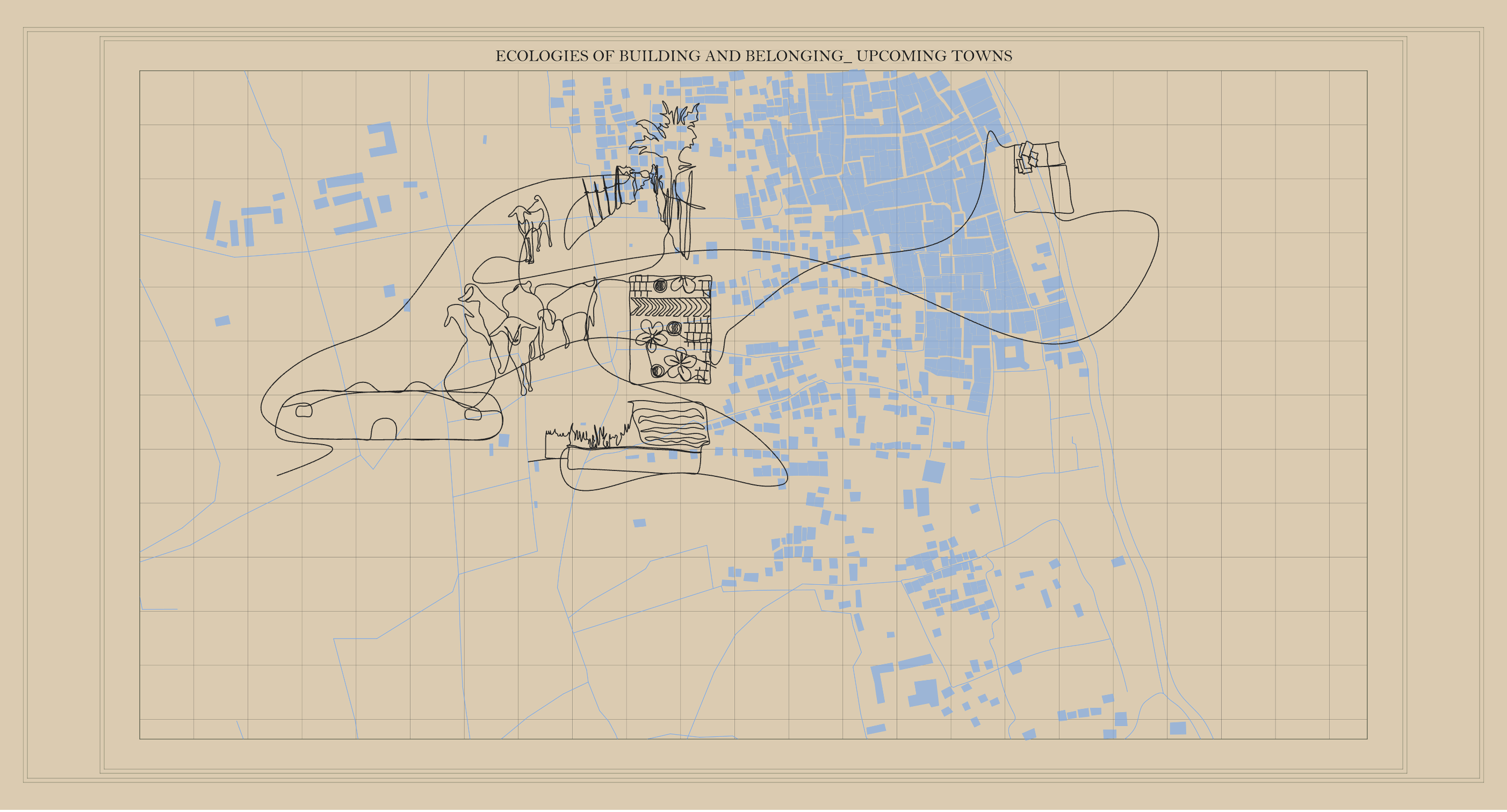
Dida’s story
Dida was born in the nearby county of Tana River. She is Orma and Muslim. She came to Lamu town with her parents when she was six years old. Her family first lived in the neighborhood of Kandahari. Halima does not have any memories of her home village in Tana River. Her father lives in Witu, a town on the mainland, while her siblings are still living in Lamu Island. For work, Halima sells groundnuts, milk and tobacco in town. Sometimes, she sends her children to sell her products when they are not in school. She lives in her late husband's house together with them.
Dida was born in the nearby county of Tana River. She is Orma and Muslim. She came to Lamu town with her parents when she was six years old. Her family first lived in the neighborhood of Kandahari. Halima does not have any memories of her home village in Tana River. Her father lives in Witu, a town on the mainland, while her siblings are still living in Lamu Island. For work, Halima sells groundnuts, milk and tobacco in town. Sometimes, she sends her children to sell her products when they are not in school. She lives in her late husband's house together with them.
Dida’s house is a temporary structure made out of Makuti. She does not feel secure in her house because the land does not belong to her. It belongs to an old Swahili family of Lamu. She understands she is a squatter and can be told to go away anytime. She aspires to own a plot in Lamu town and build a permanent house of her own.
Projects
Ecologies of Belonging #2301
The Violence in Maweni’s Coral Stones
Maweni, 2023
Maeva Yersin
Download PDF
Maeva Yersin
Download PDF
Anticipating the economic prospects of the new port, the region has witnessed a surge in land speculation, sparking intensifying disputes about belonging in the region. These disputes encompass not only matters of land adjudication and ownership, patronage politics and corruption, but also about the stewardship and transformation of lived-in landscapes and ecologies.
Maweni is a small town nestled on Manda Island within the Lamu archipelago. Since the 1980s, people from various parts of Kenya have flocked to Maweni, attracted by the economic prospects offered by the local quarry. This quarry is pivotal in providing an ongoing supply of coral stones to Lamu town and the surrounding region. Coral stone, as the primary construction material of the town, carries profound cultural significance for Swahili coast residents, tightly interwoven with their sense of belonging, extending along the coastal expanse of Kenya.
Maweni is a small town nestled on Manda Island within the Lamu archipelago. Since the 1980s, people from various parts of Kenya have flocked to Maweni, attracted by the economic prospects offered by the local quarry. This quarry is pivotal in providing an ongoing supply of coral stones to Lamu town and the surrounding region. Coral stone, as the primary construction material of the town, carries profound cultural significance for Swahili coast residents, tightly interwoven with their sense of belonging, extending along the coastal expanse of Kenya.
In contrast to the predominantly Muslim population of the Swahili coast, Maweni's workers and residents, recently counted to be around 2,000 people, are mainly Christian. Many identify as Luo—an ethnic identification of communities initially settled around Lake Victoria in Western Kenya.
![]()
A shipment of coral bricks from Maweni, stacked at Lamu waterfront

A shipment of coral bricks from Maweni, stacked at Lamu waterfront
Postcolonial politics in stone
Coastal Kenya’s prevailing political landscape bears the marks of colonial history. European-imposed racial hierarchies intersect with Arab culture and Muslim notions of belonging within a Christian-dominated Kenya. The ambiguous relationship of coastal communities with “Kenya” can be traced back to the British colonial era when Swahili-speaking communities were racially classified as distinct from Africans. Compounding such clafficiations is the fact that since Kenyan independence, coastal communities have suffered state-led marginalization, manifesting in absent or deteriorating infrastructure, imposed security, and limited education and employment opportunities.
Perceptions of neglect by the postcolonial state have intensified the idea of a distinctive coastal identity, which serves both to gain political legitimacy and establish an alternative narrative of belonging independent of the Kenyan nation-state. How do these complex politics of belonging inhabit building materials such as coral stone?
Perceptions of neglect by the postcolonial state have intensified the idea of a distinctive coastal identity, which serves both to gain political legitimacy and establish an alternative narrative of belonging independent of the Kenyan nation-state. How do these complex politics of belonging inhabit building materials such as coral stone?
Since the 12th century, coastal communities have utilised coral stones to construct houses, tombs, and mosques, thereby transforming coastal towns such as Lamu into powerful nodes of trade and civilisation. Coral stones symbolise the aspiration to be part of the civilisational order of urban Islam, as art historian Prita Meier has shown. They perpetuate the celebratory narrative of Lamu Island as a stone town. However, they also evoke the painful legacy of plantation slavery.
“Coral stone masonry encapsulates political and social tensions, embodying both the violent racial histories of dispossession and the celebratory narratives of belonging to an ecosystem.”
Examining building exclusively through the lens of architecture or development today falls short of capturing these profound historical and political complexities.
“Coral stone masonry encapsulates political and social tensions, embodying both the violent racial histories of dispossession and the celebratory narratives of belonging to an ecosystem.”
Examining building exclusively through the lens of architecture or development today falls short of capturing these profound historical and political complexities.
Reaching Maweni
The commute from Lamu to Maweni begins with a 20-25-minute journey aboard a public boat to Manda Island. From there, the trip then involves a 15-minute ride on the back of a motorbike (known as piki piki). Often, three people share a single motorcycle, navigating muddy and rugged roads that have not been renewed in decades. During rainy days, these roads become treacherous, necessitating slower speeds and an increase in the cost of the ride.
Including waiting times, the journey from Lamu Island to Maweni takes an hour or two, with a total cost ranging between 600 and 800KSH. This overland route is slower but cheaper than going by boat. However, for residents working in Manda Maweni who earn just 1000KSH on a good day, leaving Maweni often means saving up their daily pay for weeks or even months.
Most tourists know Manda Island because this is where the airport is located. Just a few kilometers away, however, the village of Maweni remains a highly marginalized space where quarry workers remain bound to backbreaking labour and have limited mobility options due to high transportation costs.
Nevertheless, material circulates at a frantic pace. Material from the quarrying sites is transported to the shore via donkeys and carts. From there, workers carry the materials on their shoulders onto the boat, which then ferry them to the seafront of Lamu Town.
And just as coral stones are carried out of the village, water containers are carried in. The island has no source of drinking water. Cyclists are often seen transporting yellow water containers brought from Lamu Island. Drinking water makes up a significant portion of household expenses in Maweni.
Mining and Blacknes
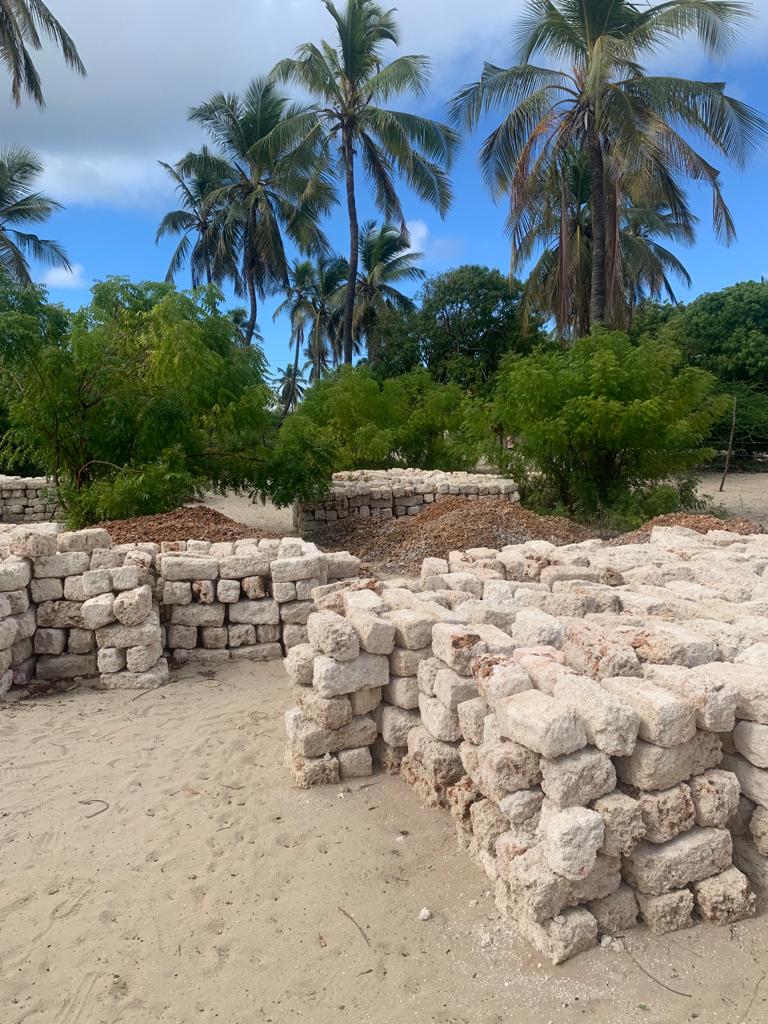
Minerals are commonly perceived as inert matter available for exploitation and activation. The logic of extraction and the language used to describe geological processes pervade the experiences of those involved in mining. Geographer Kathryn Yussof has argued that the extraction and commodification of mineral material goes hand in hand with colonial logics of dehumanization. This process is intricately tied to the racialisation of bodies, as the categorisation of blackness is a prerequisite for extracting resources from colonised territories.
Blackness is closely linked to the formation of a subjectivity intentionally distorted by the logic that the violence inherent in resource extraction must be absorbed by black bodies. Blackness, furthermore, is an embodied experience, manifesting itself in journeys and interactions, characterised by the constant movement of bodies, memories, and cultures. These populations possess the capacity to evolve and adapt, "to become different things at different times," reflecting an urban population in perpetual motion or considered available for movement," as urbanist Abdoumaliq Simone writes.
“The concept of Blackness assumes a relational character in Maweni, pertaining to individuals perceived as “immigrants” (colloquially “up-country people”) rather than indigenous residents in the local politics of Lamu.”
“The concept of Blackness assumes a relational character in Maweni, pertaining to individuals perceived as “immigrants” (colloquially “up-country people”) rather than indigenous residents in the local politics of Lamu.”
Ecologies of belonging #2302
Fixators of oppression in space
2023
Cristina De Lucas
Download PDF
Cristina De Lucas
Download PDF
This paper aims to shed light on the connections between property, belonging, and power dynamics in Lamu, Kenya. It relates the historical and conceptual foundations of property to the role of emotions and social negotiation in the construction of belonging. By exploring this interplay between land and belonging, the paper aims to gain a deeper understanding of social hierarchies and identity in Lamu.
Property can be conceptualised as a potent instrument of power, driven by the act of possession akin to domination, thereby ensuring the perpetuation of oppression. Moreover, belonging can be understood as a profound sense of comfort and the emotional responses derived from a harmonious alignment with one's surroundings in terms of behavioural constraints, which are influenced by the directives imposed by a dominant authority. This parallel can be drawn to apprehensions regarding discrimination and exclusion.
Lamu is a vibrant and heterogeneous place characterised by diverse ethnicities, religions, and cultures. With a blend of Islam and Christianity, the region features a fusion of traditions and beliefs. However, despite its rich cultural heritage, Lamu often finds itself stigmatised by Kenya as "the poor, undeveloped one." This discrimination stems from prevailing narratives that undermine the economic and social progress of the area. Additionally, Lamu bears the lasting consequences of British colonisation, having inherited a foreign system of governance that continues to influence its present-day development.
Property can be conceptualised as a potent instrument of power, driven by the act of possession akin to domination, thereby ensuring the perpetuation of oppression. Moreover, belonging can be understood as a profound sense of comfort and the emotional responses derived from a harmonious alignment with one's surroundings in terms of behavioural constraints, which are influenced by the directives imposed by a dominant authority. This parallel can be drawn to apprehensions regarding discrimination and exclusion.
Lamu is a vibrant and heterogeneous place characterised by diverse ethnicities, religions, and cultures. With a blend of Islam and Christianity, the region features a fusion of traditions and beliefs. However, despite its rich cultural heritage, Lamu often finds itself stigmatised by Kenya as "the poor, undeveloped one." This discrimination stems from prevailing narratives that undermine the economic and social progress of the area. Additionally, Lamu bears the lasting consequences of British colonisation, having inherited a foreign system of governance that continues to influence its present-day development.
“Traditionally, the indigenous peoples of Lamu lived in tightly-knit communities where a council of elders played a central role in decision-making processes.”
These respected figures were responsible for ensuring the community's well-being, managing land usage, maintaining security, and overseeing trade activities. They also presided over civil disputes among neighbours and conducted annual religious rituals, many closely tied to economic practices such as farming, livestock rearing, and fishing.
However, the current administrative structure of the government, particularly the presence of the provincial administration, conflicts with these traditional modes of rule.
Consequently, some communities in Lamu have strained relationships with these appointed leaders, resulting in a lack of effective representation and limited opportunities for community participation in decision-making processes. It is within these contexts that housing construction, property dynamics, and the formation of social belonging become salient factors that both influence and are influenced by Lamu's broader power structures.
However, the current administrative structure of the government, particularly the presence of the provincial administration, conflicts with these traditional modes of rule.
“Chiefs, sub-chiefs, and headmen appointed by the government now handle most disputes, effectively sidelining the authority of the Council of Elders. This erosion of power has led to a loss of the indigenous peoples' sense of prior informed consent, as the government-appointed local leaders often fail to consult with the communities they are meant to represent.”
Consequently, some communities in Lamu have strained relationships with these appointed leaders, resulting in a lack of effective representation and limited opportunities for community participation in decision-making processes. It is within these contexts that housing construction, property dynamics, and the formation of social belonging become salient factors that both influence and are influenced by Lamu's broader power structures.
A disenchanted home
As we delve into the exploration of property as an instrument of power, navigating the realm of belonging becomes essential—a concept intricately intertwined with the transmission of narratives surrounding cultural identity. Belonging encompasses the multifaceted tapestry of connections, attachments, and associations individuals forge with spaces, objects, and communities. Within this framework, we can discern how emotional motivations traverse the landscape of property relations.
Scholar Nira Yuval-Davis defines belonging as "an emotional (or even ontological) attachment about feeling 'at home', understood as a safe space." She attests that belonging is always a dynamic process, not a reified fixity, arguing that the latter is only a naturalised construction of a particular hegemonic form of power relations.
However, the feeling of belonging also exists in relation to fixed factors such as family and social roles. These are not only emotional attachments but also structures of power.
Scholar Nira Yuval-Davis defines belonging as "an emotional (or even ontological) attachment about feeling 'at home', understood as a safe space." She attests that belonging is always a dynamic process, not a reified fixity, arguing that the latter is only a naturalised construction of a particular hegemonic form of power relations.
However, the feeling of belonging also exists in relation to fixed factors such as family and social roles. These are not only emotional attachments but also structures of power.
“Romanticising the role of belonging as solely an emotional attachment to childhood memories diminishes the power dynamics at play.”
While it is true that emotional attachments to memories become more pronounced when one is distanced, this heightened visibility results from confronting the feeling of not belonging. These sentiments merely reflect the social comfort of knowing that one's values align with the prevailing social norms of the surroundings.
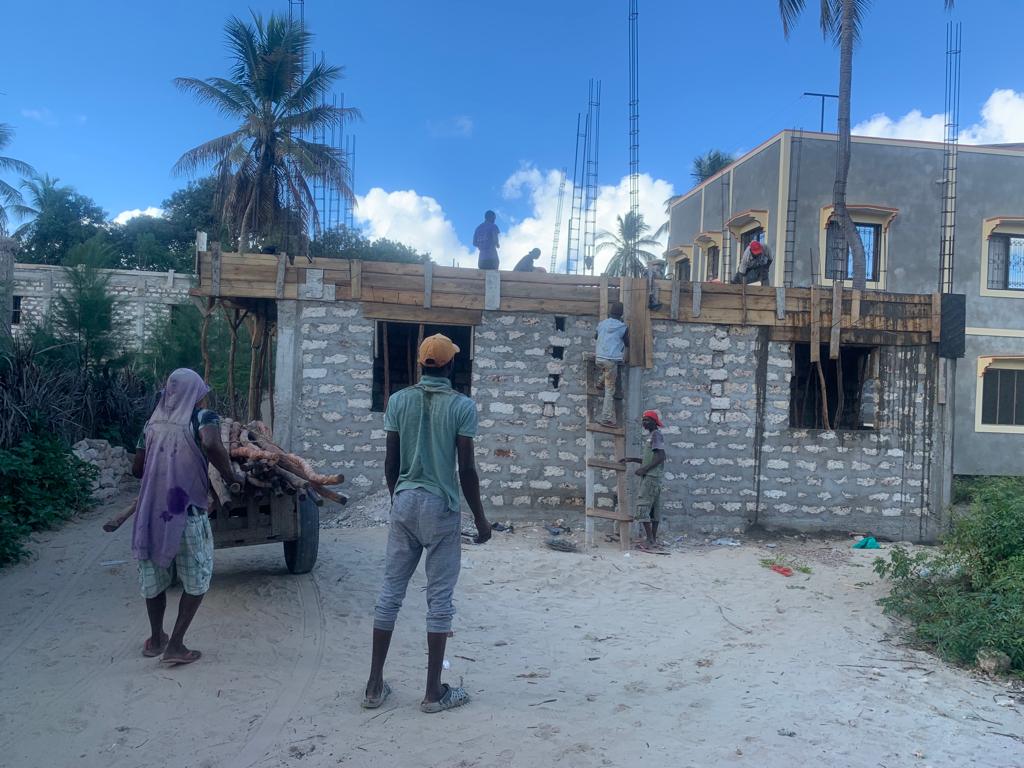
Communal, state, and private property
In Lamu, the dynamics of land ownership are shaped by a complex interplay of cultural, historical, and political factors. The local population, who predominantly practice Islam, strongly advocates for preserving traditional system of ownership, governed by councils of elders.
The elders hold the power to allocate land use but not ownership. However, the authority of the elders extends beyond land, as they also make decisions pertaining to security trade and oversee annual religious rituals.
However, the administrative structure imposed by the government, particularly through the presence of the provincial administration, means a centralization of power. This shift has resulted in a sense of detachment amongst the people and lack of transparency and accountability in government.
The elders hold the power to allocate land use but not ownership. However, the authority of the elders extends beyond land, as they also make decisions pertaining to security trade and oversee annual religious rituals.
However, the administrative structure imposed by the government, particularly through the presence of the provincial administration, means a centralization of power. This shift has resulted in a sense of detachment amongst the people and lack of transparency and accountability in government.
“The Kenyan government's categorisation of land as Government Land has been exploited by the political and financial elite to gain access to ancestral lands, branding the indigenous communities as ‘squatters’ on their territories.”
A significant portion of Lamu's land, however, is recognised as "community land," intended for communal use and livelihoods. To protect these communal lands, regulations stipulate that they should be held by communities identified based on ethnicity, culture, or similar community interests. Within the community, families and individuals are allocated rights to use the land in perpetuity, with the ultimate ownership vested in the community.
The dynamics of land ownership in Lamu reflect the tension between traditional governance systems, the imposition of colonial structures, the influence of political and financial elites, and the ongoing struggle to protect communal land and livelihoods from land grabbing.
![]()
The dynamics of land ownership in Lamu reflect the tension between traditional governance systems, the imposition of colonial structures, the influence of political and financial elites, and the ongoing struggle to protect communal land and livelihoods from land grabbing.
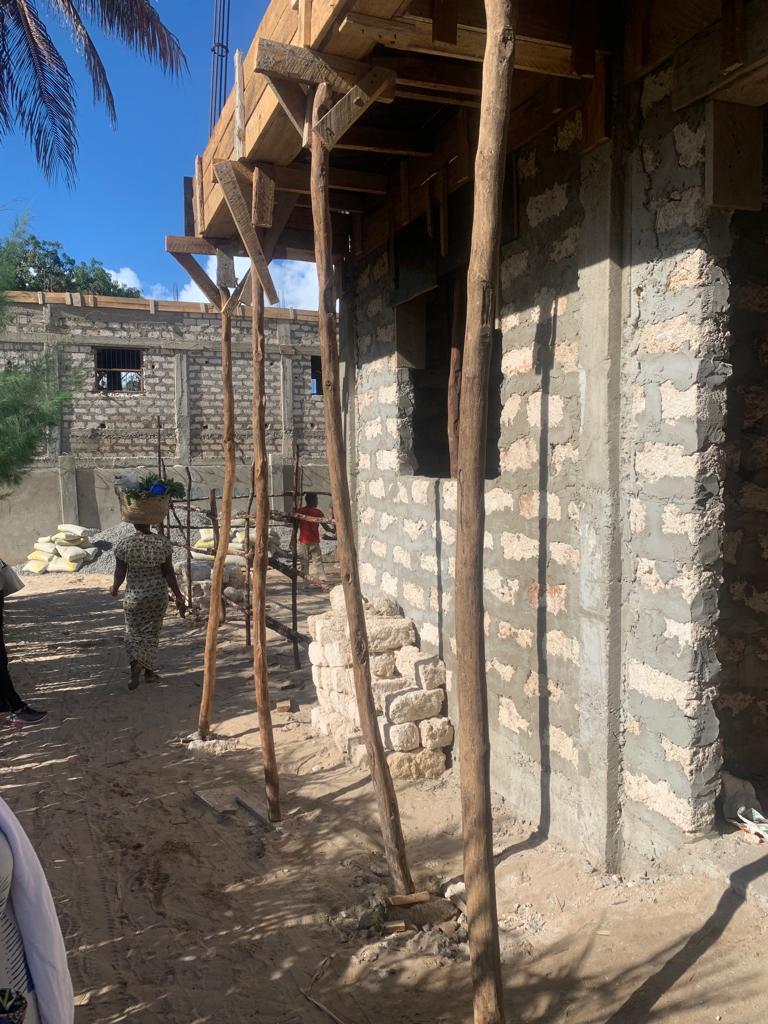
Maritime mobilities
How does the construction of the new port disrupt maritime mobility patterns and marine-based livelihoods? What interventions will be needed to safeguard these for the future, and which new livelihoods might emerge?
The new regime of mobility which the LAPSSET project aims to establish disrupts existing maritime livelihoods and mobility across the Lamu region. Sustained civil society action has resulted in a one-time, highly contested compensation scheme for fisherfolk. But many in the community are aware that this compensation does little to guarantee locals’ inclusion in economic development, nor mitigate the risks and threats to existing way of life.
Meanwhile, anxiety about the future of Lamu is prompted by rumours about a new bridge and ferry connections and fears about the closure of the dug-out channel that facilitates crucial east-west travel in the archipelago.
Meanwhile, anxiety about the future of Lamu is prompted by rumours about a new bridge and ferry connections and fears about the closure of the dug-out channel that facilitates crucial east-west travel in the archipelago.
Through ethnography and mapping, our work explores the relationships between the ways people move across the archipelago and their ability to sustain themselves. It shows how mangrove, fishing, and tourist livelihoods depend on maritime movement, shaped by the intricacies of tides, seasons, and state security. Following diverse narratives from different groups of people, the research addresses the tension between hopes for a prosperous future and fears of losing livelihoods.
Projects
Maritime mobilities #2304
A Port of Splintered Promise
“These people”
We arrive in the early hours of dawn and dock at the main jetty of Mokowe, Lamu County’s first mainland town west of the archipelago. From Lamu town, the commute takes a mere 15 minutes, and one does not have to wait long for the boat to garner the dozen or so passengers it needs to make the journey worth the captain’s while. Traffic commences early on this most frequented of thoroughfares, as the movement of cargo, schoolchildren, and government functionaries underlies the island’s dependence on mainland supplies and infrastructure.
Morning cargo on the shore of Mokowe Jetty
One is greeted by heaps of cargo littered about the place, waiting to be loaded onto cargo boats embarking back towards various stations within the Island network. A procession of porters animates the scene, transferring merchandise between lorries and cargo ships. On-land conveyance awaits further on from the slope of the shore, with vans and buses idling alongside private-hire estate cars and motorbikes.
Porters at Mokowe
A porter frantically waves at us from afar, taking exception to our filming of the spectacle. The man walks up to interrogate our objectification of their drudgery and is unusually verbose for his occupation, asking if we thought they were “imbeciles”. Courtesy obliged us to concede to his protests all too willingly, but the man seemed to relish this break from his labour and continued conversing in practiced English.
We talked of his occupational hazards, and he went through a litany of accidents they had grown accustomed to, including overloading, capsizing, and even fires. Soon this turned towards what the future held, which gave us a segue to mention the prospect of a rumoured bridge between Lamu town and the mainland. This was seen as part of the infrastructural upgradation that LAPSSET brought to the region, and would streamline the daily commute of many.
We arrive in the early hours of dawn and dock at the main jetty of Mokowe, Lamu County’s first mainland town west of the archipelago. From Lamu town, the commute takes a mere 15 minutes, and one does not have to wait long for the boat to garner the dozen or so passengers it needs to make the journey worth the captain’s while. Traffic commences early on this most frequented of thoroughfares, as the movement of cargo, schoolchildren, and government functionaries underlies the island’s dependence on mainland supplies and infrastructure.
Morning cargo on the shore of Mokowe Jetty
One is greeted by heaps of cargo littered about the place, waiting to be loaded onto cargo boats embarking back towards various stations within the Island network. A procession of porters animates the scene, transferring merchandise between lorries and cargo ships. On-land conveyance awaits further on from the slope of the shore, with vans and buses idling alongside private-hire estate cars and motorbikes.
Porters at Mokowe
A porter frantically waves at us from afar, taking exception to our filming of the spectacle. The man walks up to interrogate our objectification of their drudgery and is unusually verbose for his occupation, asking if we thought they were “imbeciles”. Courtesy obliged us to concede to his protests all too willingly, but the man seemed to relish this break from his labour and continued conversing in practiced English.
We talked of his occupational hazards, and he went through a litany of accidents they had grown accustomed to, including overloading, capsizing, and even fires. Soon this turned towards what the future held, which gave us a segue to mention the prospect of a rumoured bridge between Lamu town and the mainland. This was seen as part of the infrastructural upgradation that LAPSSET brought to the region, and would streamline the daily commute of many.
However, this proposition was met with a patient sigh, followed by a rather resigned explanation of why this prospect, real as it was, could not materialise. A plan for the bridge was indeed proposed, but the local boatsmen vehemently protested against such inconsiderate benevolence, seeing as a land connection would spell an end to their means of livelihood. Excluding himself as a Kikuyu mainlander, he decried the siege mentality of the islanders:
“They feel like the main government is working with the Chinese, and the Swahili people are kind of just pushed aside. I remember the Chinese proposed to construct the bridge very well – they even came with a map… but these Swahili from Lamu refused it. The main reason is that the bridge would deny them jobs.”
“These people… they don’t like change, they don’t like development, they want the same of what they have – that is why they are against such projects.”
This political rift, mapped onto ethnic difference, has been central to Lamu’s relationship with the national government.
Coastal communities tend to look back on the Omani maritime empire as a period of prosperity for Lamu, in contrast to the marginalization of the region since Kenyan independence. Kikuyu communities arguably bore the brunt of colonial oppression during British rule, and their anti-colonial resistance is foundational to Kenyan independence and post-independence nation-building. However, Kikuyu political elites, with president Jomo Kenyatta at the top, are also widely described as the biggest landgrabbers of Kenya, responsible for the country’s neo-colonial injustices after independence.
Mirroring the feelings of marginalisation the porter felt in Bajuni-led Lamu, this complex history inhabits contemporary politics and social dynamics. Coastal communities are wary of state impositions from Kikuyu and other “upcountry Kenyan functionaries, of local real-estate speculation by their investment-savvy middle class, and of the mainland’s vague but consequential conflation of Al-Shabaab with the local community.
The porter occupied us for a rather generous half hour, before we realised he was holding out for some renumeration for his time. This made us realise how little of his exposition depended on our prompts, and why it had all seemed rather rehearsed. Well-meaning wazungu were to be sold a story, or so it seemed.
Infrastructure as a frame of analysis
While the LAPSSET infrastructure project served as both topic and context in our research, we were also inspired to mobilize infrastructure as an analytical lens. By virtue of the vastness of its purview, and the indeterminacy of the boundaries of its causal and effectual spheres of influence, infrastructure evades disciplinary caging. It does however lend itself quite naturally as a site of inquiry to a diversity of social science disciplines such as anthropology, history, human geography, urban studies, and science and technology studies. Each of these offer approaches that addresss particular aspects of such a boundless chain of phenomena.
In short, the challenge confronted by a researcher is first and foremost of delimitation; a matter of honing in on a case through a selection of methods, and then framing it within spatial, social, and temporal constraints.
Ethnographic imprecision
In order to grapple with the effects of the LAPSSET project spread across such a spatially dispersed area - and to accommodate the nebulous phase this inquiry finds itself in - this undertaking calls for a lenient imprecision in its ethnographic approach. The aim here is to document social attitudes, responses and expectations around the construction of the port.
As Hannah Knox and Penny Harvey summarised the challenge of such a premise, “when studying infrastructure the anthropologist must confront the problem of locating an ethnographic site without limiting the scale of description.”
As Hannah Knox and Penny Harvey summarised the challenge of such a premise, “when studying infrastructure the anthropologist must confront the problem of locating an ethnographic site without limiting the scale of description.”
Following suit, this study aims to take account of the variety and instability of human relations in the shift brought about by this infrastructural intervention within the community, and attempts to offer a snapshot of the social and cultural dynamics of change brought about by the port.
Imaginaries of development
To envisage infrastructure within a public imaginary is to dwell on an aesthetic plane of conception. Framing infrastructure as such relegates its technical function to a separate, secondary concern; the priority instead being the imaginative potential of its image. This implies not only the visuality of the spectacle itself, but also the sense in which it is internalised by its addressees.
Brian Larkin offers a masterful exposition of this potential, pushing back against the trope of ‘infra’ as denoting something hidden and behind the scenes. To be fair, the notion of an out-of-sight network of processes, one that enables the end-user a certain convenience through an unassuming interface, does provide an inexhaustible avenue of research. But Larkin argues that there is no end to the relational webs that one may consider in trying to come to grips with infrastructure, and emphatically states that “discussing infrastructure is a categorical act… a moment of tearing into those heterogeneous networks to define which aspect of which network is to be discussed.”
Drawing license from the clarity of Larkin's declaration, this inquiry’s categorical concern is the connotative baggage of new Lamu port within the local community. Though having enjoyed centuries of prominence as a thriving port city in past regimes, there is a palpable sense of modernity’s belated arrival that the new port announces in the current, Kenyan iteration of Lamu. A “game-changer” as it is so tritely brandished in official pronouncements, the port is held up as Lamu’s fast track ticket to development.
Such proclamations by government officials imply a tacit admission of feeling left behind so far, and speak of a motivating disjunction sorely felt between Lamu’s as-is, and its desired to-be. The trope of the port as a game-changer therefore is not without conviction, and is emblematic of the “postcolonial state’s imaginative investment in technology,” dissonant as it might be with the heritage-tinged, donkey-cart romance of Lamu’s Old Town.
“As a regional gateway to the riches of East Africa, Lamu has the chance to shed its image of a developmental hinterland for a new prominence on the international stage. The proposed LAPSSET project will immensely contribute to the opening up of the County externally to other Port Cities and Nations of the world.”
Such proclamations by government officials imply a tacit admission of feeling left behind so far, and speak of a motivating disjunction sorely felt between Lamu’s as-is, and its desired to-be. The trope of the port as a game-changer therefore is not without conviction, and is emblematic of the “postcolonial state’s imaginative investment in technology,” dissonant as it might be with the heritage-tinged, donkey-cart romance of Lamu’s Old Town.
Maritime mobilities #2303
The role of maritime mobility in sustaining livelihoods within the Lamu Archipelago
Tides of Change
The role of maritime mobility in sustaining livelihoods within the Lamu Archipelago
Lamu archipelago, 2023
Tanja Meier
Download PDF
Tanja Meier
Download PDF
"The place they chose to build LAPSSET port is dangerous. Because if the Mkanda channel is closed, Lamu will be finished."
This is how Mohammad Mbwana - Shungwaya Welfare Association chairman and a local historian - expressed his fear for Lamu's future in our interview. According to Mbwana, disruptions to maritime mobility will be the end of Lamu. The infrastructural development in Lamu is anticipated with both a sense of promise and violence. The government promises growth, modernity, and prosperity for the region against a background of dispossession, displacement, and exclusion.
Lamu County is the northernmost county on the Kenyan coast. It borders Somalia and has direct access to the Indian Ocean. The locals do not perceive this ocean as a border but rather as an extension of the land and life around the islands. Many indigenous communities inhabit the Lamu archipelago. Their cultural identity depends on the natural resources surrounding the archipelago.
Water is of paramount importance, serving as a base for both the fishing industry and mangrove management, two primary means of livelihood within the island network. The sea is often overseen as an environment where people navigate and manoeuvre. However, maritime societies constantly interact between land and sea, and these connections shape their knowledge and practices. Simultaneously, littoral communities, such as the inhabitants of Lamu, are connected to their hinterlands socially, politically, and economically.
LAPSSET may create new markets for Kenya and the region through which state income can be generated. However, these ambitions turn into infrastructural violence around Lamu port, with severe ramifications for various social groups in the wider region.
LAPSSET may create new markets for Kenya and the region through which state income can be generated. However, these ambitions turn into infrastructural violence around Lamu port, with severe ramifications for various social groups in the wider region.
Honing in on transport
Literature on LAPSSET has focused on the social upheaval accompanying infrastructure, touching upon events of land grabbing, fishing bans, monetary compensations, and other processes that animate analysis on a more local scale.
However, within the broad purview of analysing such a massive international project, the disruption of regional maritime mobility has thus far evaded scholarly analysis.
Given a considerable part of the archipelago experience is commuting by boat, we saw this as an opening to inquire further on a topic that suited the limitations of our fieldwork. We thus honed in on maritime mobility and began by questioning the numerous claims on Lamu’s waterways.
How is Lamu’s maritime mobility disrupted by the ongoing port development?
What effects does this have on livelihoods and the movement within the Lamu Archipelago?
What alternatives, promises, and opportunities emerge to safeguard the future of Lamu’s current livelihoods?
Building up to Mkanda
Mkanda is a channel that connects Lamu East with Lamu West. It drastically shortens the commute between islands and provides a calm, secure alternative to the outer seas. The canal cuts through the mangroves between the mainland and Manda Island.
In the 19th century, the maritime economy of the archipelago was dominated by British colonial rule. After independence, the Kenyan state took control of regulating trade.
“In 1978, mangrove harvesting and export to the Middle East was banned, forcing boat captains to resort to other occupations, such as being tour guides. In this and other ways, government involvment fueled the economic decline of the region.”
Before this curtailment of trade, large dhows crossed the outer sea and sailed around the Lamu Archipelago and
![]()
Satellite image of Mkanda channel and Wiyoni town on the bottom left corner
According to fishermen, the government-funded dredging of Mkanda around the year 2000 countered local economic decline and allowed small motor boats to navigate safely within the archipelago. Some people argue that the channel was dug to improve the archipelago’s security, while others interpret it as a precursor to the new port. Furthermore, the dredging allowed for land reclamation near Lamu town, giving rise to the new urban area of Wiyoni. The exact motives behind the government-funded dredging remain unclear; thus, it is hard to distinguish its objectives from both positive and negative side effects. Nonetheless, the channel’s importance to Lamu is undeniable.
The construction of Mkanda also played a role in the transformation of Pate Island. Trade across the Indian Ocean long shaped the orientation of towns such as Pate towards the ocean. However, since the monopolisation of the trans-oceanic trade, these towns were no longer beneficiaries of this trade. This new economic situation led the island to reorient itself towards the mainland side of the archipelago, where smaller boats could more easily dock.
In the 19th century, the maritime economy of the archipelago was dominated by British colonial rule. After independence, the Kenyan state took control of regulating trade.
“In 1978, mangrove harvesting and export to the Middle East was banned, forcing boat captains to resort to other occupations, such as being tour guides. In this and other ways, government involvment fueled the economic decline of the region.”
Before this curtailment of trade, large dhows crossed the outer sea and sailed around the Lamu Archipelago and
across the Indian Ocean.
The maritime economy was then gradually replaced by steamboats operating between British India and East Africa. Today, mostly small boats circulate the island - and captains keep from the outer seas too hazardous to navigate.
Satellite image of Mkanda channel and Wiyoni town on the bottom left corner
According to fishermen, the government-funded dredging of Mkanda around the year 2000 countered local economic decline and allowed small motor boats to navigate safely within the archipelago. Some people argue that the channel was dug to improve the archipelago’s security, while others interpret it as a precursor to the new port. Furthermore, the dredging allowed for land reclamation near Lamu town, giving rise to the new urban area of Wiyoni. The exact motives behind the government-funded dredging remain unclear; thus, it is hard to distinguish its objectives from both positive and negative side effects. Nonetheless, the channel’s importance to Lamu is undeniable.
The construction of Mkanda also played a role in the transformation of Pate Island. Trade across the Indian Ocean long shaped the orientation of towns such as Pate towards the ocean. However, since the monopolisation of the trans-oceanic trade, these towns were no longer beneficiaries of this trade. This new economic situation led the island to reorient itself towards the mainland side of the archipelago, where smaller boats could more easily dock.
Previously - when the island was still oriented towards the outer sea - places like Shanga and Kizingitini were the main docking places on Pate Island. Now, though, Mtangawanda is the island's main dock, easily accessible as it is through the channel from Amu and the mainland.

Routes going through Mkanda connecting Lamu with Pate Island (Mtangawanda & Shanga)
Today, Mkanda is a highly frequented water passage for cargo, tourists, and public transport. Using the channel to commute between Lamu East and Lamu West saves travel time and reduces fuel costs against the sea route. Moreover, Mkanda is crucial for Lamu's fishermen to operate all year round and avoid dangerous voyages into the outer sea.
"For the route of Shela (outer sea) - it is seasonal. When the sea is rough, they use the Mkanda fishing route," explains BMU Amu Chairman.
The Mkanda channel is especially important during the rainy season when the sea picks up, and the route through the outer sea becomes dangerous and impassable for small boats. "So, most of the time, when the sea picks up, we try to advise them not to cross there [the outer sea]. The channel is more on this side [inside the archipelago]. So, we try fishing within here," explains the chairman.

Lamu Port from Mkanda
Although Mkanda is at the centre of the archipelago, many other waterways are highly important. Map 5 displays some of the leading maritime routes that are used regularly. The map shows that maritime routes in the Lamu Archipelago are not only used by fisherfolk but are crucial to other activities such as mangrove cutting, cargo shipping, public transportation, and NGO projects.

Main waterways on Lamu archipelago
The Goliath of global trade
Manda Bay was chosen for the construction of the new port because of its natural geography. The deep sea level here allows several large ships to dock and manoeuvre in the port area simultaneously, which is supposed to facilitate large-scale trade.
Most aspects of the new projects are financed through public-private partnership (PPP), making negotiations complicated. Within this framework, Kenya’s government can contribute by providing land and other investments and profit from the share in (tax)-revenues. Such neo-colonial invitations are not new to the continent. Foreign investors and companies are the primary beneficiaries of the project. Officials are quick to emphasise, however, that this also offers new opportunities for the middle class:
Most aspects of the new projects are financed through public-private partnership (PPP), making negotiations complicated. Within this framework, Kenya’s government can contribute by providing land and other investments and profit from the share in (tax)-revenues. Such neo-colonial invitations are not new to the continent. Foreign investors and companies are the primary beneficiaries of the project. Officials are quick to emphasise, however, that this also offers new opportunities for the middle class:
“You know, Hindi – people have taken land for speculation. Because Hindi is where the project is, and people anticipate it. People know that Hindi will be another place like Dubai in the next 10-20 years.”
The adverse effects of the project are manifold. Environmental concerns and loss of existing livelihoods resulted in various protests and community outcries in Lamu. Coalitions such as Save Lamu understand the community’s worry about the destruction of mangroves and corals and, therefore, the threat to the environment and the livelihoods of Lamu. People are not entirely opposed to LAPSSET but disagree with its violent and exclusionary implementation, with claims of unequal distribution and benefits not being solved.
The port also raises new questions about logistics, ownership and access in Lamu. Increased security measures and the intensified flow of commodities shape transportation patterns. This overlooks local concerns and redirects the focus to a more global economy. It also reconfigures possession and blurs the boundaries of the origin of goods. Moreover, the question of locating accountability becomes more obscure.
The port also raises new questions about logistics, ownership and access in Lamu. Increased security measures and the intensified flow of commodities shape transportation patterns. This overlooks local concerns and redirects the focus to a more global economy. It also reconfigures possession and blurs the boundaries of the origin of goods. Moreover, the question of locating accountability becomes more obscure.
Expected change in maritime routes
The County Integrated Development Plan 2023-2027 emphasises large-scale growth in terms of mobility on land and marine. Highways connecting Lamu to the broader region and the port connecting Lamu - and, more broadly, East Africa - to the Indian Ocean disrupts existing mobility patterns. How these patterns may change in the future is a matter of contestation today.
The plan identifies the provision of land for industrial development, but it does not specify future land usage. However, it does anticipate the development a spatial plan in the coming years.
Seasons, tides, towns, and natural resources influence current mobility patterns in the Lamu archipelago. The map below shows the most frequent waterways on the archipelago and the fishing areas and mangroves around the port area.
![]()
Mobility patterns in Lamu archipelago
The map below shows the extent of Lamu Port and future development areas. These areas will shift the balance of development to the mainland and affect maritime mobility patterns.
“The establishment of the port may make the existing route via the Mkanda channel unviable. As a result of the LAPSSET implementation, these routes are therefore at the centre of anxiety about the future of the region.”
![]()
Maritime mobility patterns and LAPSSET development areas.
The plan identifies the provision of land for industrial development, but it does not specify future land usage. However, it does anticipate the development a spatial plan in the coming years.
Seasons, tides, towns, and natural resources influence current mobility patterns in the Lamu archipelago. The map below shows the most frequent waterways on the archipelago and the fishing areas and mangroves around the port area.

Mobility patterns in Lamu archipelago
The map below shows the extent of Lamu Port and future development areas. These areas will shift the balance of development to the mainland and affect maritime mobility patterns.
“The establishment of the port may make the existing route via the Mkanda channel unviable. As a result of the LAPSSET implementation, these routes are therefore at the centre of anxiety about the future of the region.”

Maritime mobility patterns and LAPSSET development areas.
The plan stress the establishment of highways, as well as new towns and commerce centres on the mainland. The focus lies on a solid road network connecting Lamu Port to other parts of Kenya, South Sudan, and Ethiopia.
![]()
County Spatial Plan (by County Government of Lamu, 2023)
Once the port is fully operational, access to existing waterways might change, and small-scale boating may face more significant restrictions, as the new port prioritises large cargo ships.
The fear of losing personal investments in small-scale livelihoods is shared among many residents. However, the shift from small-scale livelihoods that provide individual incomes to a large-scale port industry is undoubtedly expected to bring changes in the maritime mobility and the livelihoods on the Lamu archipelago.
Despite the expectations and fears, what remains unanswered is whether the promise of modernisation leaves room for small-scale maritime livelihoods in the future.
![]()
Cargo boats docking at Lamu Port

County Spatial Plan (by County Government of Lamu, 2023)
Once the port is fully operational, access to existing waterways might change, and small-scale boating may face more significant restrictions, as the new port prioritises large cargo ships.
The fear of losing personal investments in small-scale livelihoods is shared among many residents. However, the shift from small-scale livelihoods that provide individual incomes to a large-scale port industry is undoubtedly expected to bring changes in the maritime mobility and the livelihoods on the Lamu archipelago.
Despite the expectations and fears, what remains unanswered is whether the promise of modernisation leaves room for small-scale maritime livelihoods in the future.

Cargo boats docking at Lamu Port
Urban stories of Displacement
How are memories of displacement and hopes of return shared in Lamu? How do they impact political claims to address historical and ongoing injustices?
The streets and walls of Lamu town resonate with the collective memory of displacement—etched deeply in the community. Following the Shifta War, a secessionist conflict held in northeastern Kenya between 1963 and 1967, thousands of people who had to flee due to extreme violence found refuge and stability in Lamu. Neighbourhoods like Langoni and Gadeni emerged in part as a result of this influx, and have become living archives of the hopes and struggles of the displaced.
In the face of LAPSSET's promise of infrastructure-led development, these memories of displacement and forced resettlement are reactivated and reworked. This theme explores the urban afterlives of displacement by focusing on the memories and experiences of those affected by displacement.
Projects
Urban Stories of Displacement #2305
Nyumbani ni Nyumbani (Home is Home)
Short film
Authors
Amina Omar
Hajj Shee
Florence Alde
Isabella Pamplona
Amina Omar
Hajj Shee
Florence Alde
Isabella Pamplona
Lamu, 2023
Watch complete film
Watch complete film
Many internally displaced persons who fled the mainland during the Shifta War live in Lamu town, particularly in the urban areas of Gadeni and Langoni. This project shows how displaced communities grapple with belonging and with political claims to historical redress.
"Nymbani ni Nymbani" is based on a series of life story interviews and urban walks with IDPs and their family members of different generations who currently reside in Lamu.
The film gives voice to these families and community leaders at the forefront of political struggles for reparations and portrays how they contributed to make Lamu what it is today.
_
Produced by:
Isabella Pamplona, Florence Alder, Amina Omar and Hajj She.
Featuring:
Mohammed Mbwana, Ahmed Kihobe, Hassan Awadh, Esha Adi, Esha Adi's aunt, Mwana Amina Amin, Mohamed Ali and Omar Shamina.
Language:
English and Kiswahili
"Nymbani ni Nymbani" is based on a series of life story interviews and urban walks with IDPs and their family members of different generations who currently reside in Lamu.
The film gives voice to these families and community leaders at the forefront of political struggles for reparations and portrays how they contributed to make Lamu what it is today.
_
Produced by:
Isabella Pamplona, Florence Alder, Amina Omar and Hajj She.
Featuring:
Mohammed Mbwana, Ahmed Kihobe, Hassan Awadh, Esha Adi, Esha Adi's aunt, Mwana Amina Amin, Mohamed Ali and Omar Shamina.
Language:
English and Kiswahili
Urban stories of Displacement #2306
Displacement and Belonging in Lamu's Archipelago
Where is home?
Displacement and Belonging in Lamu's Archipelago
“We cannot leave this place here... But we would be happy to go back there.”
This quote, by a Lamu resident who identifies as an IDP, captures the complex feelings experienced by the displaced community in Lamu after their displacement from the mainland during the Shifta War. The disappointments of Kenya's post-colonial politics have left them in a kind of limbo where they do not feel full belonging to their ancestral homeland nor fully to Lamu, the place where they currently live.
“Their attachment to Lamu is intertwined with a longing for a different, parallel reality they claim as their home. In claiming to belong to their homeland, ethnicity becomes a political tool through which they exercise agency and negotiate compensation for the historical injustices suffered during the Shifta War.”
This paper investigates the nuanced sense of belonging among Lamu's IDPs in the context of urban archipelagic life. It explores how their feelings are shaped by the complex interplay between postcolonial politics, the particularities of archipelagic life, and the traumas of displacement. In doing so, it traces their relationship with land, sea, livelihoods, community, and their influence on the urban fabric. Furthermore, it shows how displacement and dissatisfaction with postcolonial Kenya inform the mobilizing of ethnicity as a political tool in seeking reparations.
Mainland ancestries
In numerous ways, IDPs and their descendants establish a sense of rootedness in their ancestral homeland. This encompasses their past lives on the mainland, emphasising the significance of agriculture, fishing, trade, and a close-knit community. It also includes the enduring connections to Lamu's land and coastal waters.
The archipelagic way of life, marked by continual movement and fluidity, shapes their perceptions of space, time, and belonging.
Settling into Lamu
Recent scholarly discussions of migration encompass broader socio-political, political-economic, and cultural processes, seeing the geopolitical dynamics of global capitalism as the ultimate cause of forced displacement. These perspectives challenge the idea that migration is purely voluntary or involuntary, considering the interplay between the factors influencing it. Within this context, the settlement of IDPs in Lamu appears as a complex process, influenced by the interplay of available possibilities and the socio-political and economic factors present.
IDPs belong to Lamu in many different ways. This is evident in their adaptive livelihood strategies, integration into the island's socioeconomic fabric, intermarriage with local communities, formation of new community organisations, and their significant impact on shaping the urban landscape. However, their connection to Lamu is not without complexity or ambiguity.
In Lamu island, the two areas generally known for hosting IDPs and "immigrants" are the Langoni and Gadeni neighbourhoods. These areas experienced significant growth during the early twentieth century, in part because of the influx of Indians. With Kenyan independence, many Indians left the island, leaving many properties unoccupied. As families and individuals displaced during the war sought refuge in Lamu, locals offered them access to housing in these neighborhoods.
The Gadeni area, which used to be located on the outskirts of the Old Town, held small farming plots with fruits and vegetables, from where Lamu locals sold their produce both in the local market and to the Middle East. This dynamic of urban farming gave the neighbourhood its name of Gadeni, which comes from "garden.” Since the area was not densely built-up back then, IDPs were given the opportunity to lease the land in the neighbourhood.
IDPs belong to Lamu in many different ways. This is evident in their adaptive livelihood strategies, integration into the island's socioeconomic fabric, intermarriage with local communities, formation of new community organisations, and their significant impact on shaping the urban landscape. However, their connection to Lamu is not without complexity or ambiguity.
IDPs continue to yearn for an imagined home, which is manifested in a sense of detachment from the local community, dedicated efforts to preserve cultural traditions, the perception of being guests in Lamu, and engagement in political activism to return to their homeland.
In Lamu island, the two areas generally known for hosting IDPs and "immigrants" are the Langoni and Gadeni neighbourhoods. These areas experienced significant growth during the early twentieth century, in part because of the influx of Indians. With Kenyan independence, many Indians left the island, leaving many properties unoccupied. As families and individuals displaced during the war sought refuge in Lamu, locals offered them access to housing in these neighborhoods.
The Gadeni area, which used to be located on the outskirts of the Old Town, held small farming plots with fruits and vegetables, from where Lamu locals sold their produce both in the local market and to the Middle East. This dynamic of urban farming gave the neighbourhood its name of Gadeni, which comes from "garden.” Since the area was not densely built-up back then, IDPs were given the opportunity to lease the land in the neighbourhood.
“They were given settlement there because they couldn't afford to rent or buy houses in town, so they got them in monthly or annual leases...”
(Kihobe, A. 2023)Settling in Gadeni gave the IDP community the opportunity to start building new lives in Lamu. Our interlocutor Ahmed Kihobe further explained that this provided a sense of security and peace for the displaced individuals, as the islands were considered safe compared to the mainland. There, they found the possibility to participate in the social life of the town. The provision of settlement and opportunities in Lamu brought a bigger influx of IDPs to the area and facilitated the reunion of dispersed families and communities. As they started to feel at ease with the possibilities in their new environment, many of the IDPs contacted others in Pate, Mtangawanga, and Shanga with the aim of bringing their relatives together again.
Settling in Lamu implied a tradeoff for IDPs in many aspects. As previously mentioned, one of the factors that weighed in when deciding to settle on the island was the possibility of access to education for future generations. In the case of Hassan, while he was only able to secure a source of income with prospects in Takwa, having access to education for his children was an essential factor that contributed to his settling and deciding to build his home in Lamu.
In the past years, being able to access education has allowed the younger generation to secure employment opportunities outside of Lamu, especially in the Middle East. Many individuals, including most of Ahmed's classmates and friends, decided to leave Lamu in pursuit of the opportunity for a better life. Ahmed highlighted that some of these friends have been absent from Lamu for almost four decades. Yet, while choosing to stay away, they still provide financial support to their families, "they will send remittance money to help their family, but they don't want to come back again.” Something worth mentioning is the contrasting situation between the children and grandchildren of IDPs. While wishing to move away, the older generation chooses to keep building and investing in the island, which starkly contrasts with many of their children, who have left young and have no intention of returning to Lamu.
The daily struggle
When walking around Lamu, one of the first things we asked was, “Where are all of the IDPs?”. To our surprise, we were told that most of them were at the main square, exactly where we were standing at that precise moment. Most of the individuals, mostly older men, sitting in this public area were IDPs waiting for any small job opportunity. Interestingly, by not actively working in the middle of a weekday, the common commentary was that they were idle. Yet, this scene reminisces older ways of engaging with the city in Lamu:
“Until about 50 years ago, sitting on one of Lamu’s baraza while sipping Arabic coffee formed the epitome of urban flair. Now it is depicted either as an outdated practice by local youth or as an example of Swahili ‘laziness’ by mainland Kenyans.”
(Hillewaert, Sarah. 2017)This everyday waiting at the main square in Lamu, while they are looking for ways of earning at least 200 KSH to make it through the day, is just one example of the many ways in which IDPs demonstrate a nuanced sense of belonging within the city. Despite their challenging circumstances, IDPs actively navigate their identities and connections to the urban space, finding ways to establish a sense of belonging. While some people actively look for new livelihoods, like walking tourists around or selling tobacco, others are still trying to preserve their traditional livelihoods.
Imaginaries of Home
IDPs construct an imaginary of home based not only on longings for a better life, but also on ancestral narratives, which are passed on through generations. Their sense of belonging is thus in tension between attachment to and detachment from Lamu, with all its aspirations and frustrations. Ethnicity in this context is mobilized as a political tool to demand rights to land and resources and to express dissatisfaction with postcolonial Kenya's politics.
The research indicates that the IDPs strive for inclusion in the local economy and society and aim to overcome their urban marginalization. Their attachment to Lamu is multifaceted, encompassing a connection to the city and the community, a longing for their imagined home, and a desire for justice.
Heritage under Transformation
How do women transform long-standing traditions of dwelling and home-building in Lamu? How does heritage matter in the context of a rapidly changing urban landscape?
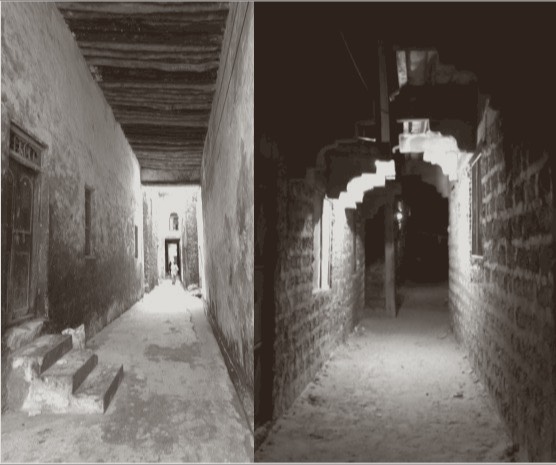 Alleys in old town (L) and new neighborhoods (Kashmir) (R)
Alleys in old town (L) and new neighborhoods (Kashmir) (R)Recognised by UNESCO as a World Heritage Site, Lamu’s ancient Stone Town harbours longstanding dwelling traditions. Yet, the town has experienced fast urban growth in recent years, with the emergence of entirely new neighbourhoods built on the once-agricultural outskirts. How does the old Lamu inhabit this new Lamu? What does dwelling culture mean in this rapidly changing context?
The new homes of Lamu’s emerging neighbourhoods may still be built using coral stone and mangrove wood, but they also feature new kinds of spaces and accommodate new uses. This theme explores this ongoing transformation of domestic cultures and home-building, focusing on the roles and practices of women in Lamu’s historic town as well as its new residential neighborhoods.
The new homes of Lamu’s emerging neighbourhoods may still be built using coral stone and mangrove wood, but they also feature new kinds of spaces and accommodate new uses. This theme explores this ongoing transformation of domestic cultures and home-building, focusing on the roles and practices of women in Lamu’s historic town as well as its new residential neighborhoods.
Using semi-structured interviews and architectural methods of analysis, our research shows how women negotiate with home builders (fundi) to create domestic spaces that meet their needs even as they aim to preserve their inheritance. In doing so, we emphasise the importance of those who inhabit and transform Lamu’s built heritage. This perspective contributes to the ongoing dialogue about heritage and sustainable development in Lamu.
Projects
Heritage under Transformation
#2305
Dwelling in Transition
#2305
Dwelling in Transition
A key element of the ancient Lamu stone house is the melia setup. This sequence of rooms is characterised by a lack of clear demarcations for multiple uses, fostering the flexible uses of domectic space. The absence of assigned rooms promotes communal use, even for individuals valuing privacy within their homes.
Lamu’s famous Stone Town embraces such adaptive use. Families divide houses among themselves or repurpose the structures over time. As families grow, houses expand; multi-story structures are constructed to accommodate the increasing number of family members, reflecting the cultural tradition of mita emphasising collective living.
Lamu’s famous Stone Town embraces such adaptive use. Families divide houses among themselves or repurpose the structures over time. As families grow, houses expand; multi-story structures are constructed to accommodate the increasing number of family members, reflecting the cultural tradition of mita emphasising collective living.
Dwelling entails not just the physical structure of a house but also the profound social, cultural, and emotional connections individuals establish with their living spaces.
Women assume a central role within these spaces as primary users and decision-makers in household arrangements. Furthermore, the expertise of builders contributes to the configuration of these spaces, thus exerting a considerable influence on their design and functionality.
Recognising the cultural and historical layers embedded within these homes allows for shaping future spaces that are both culturally meaningful and sustainable over time.
The collaborative synergy between women, serving as users and decision-makers, and house builders, with their expertise, culminates in the creation of living spaces that both reflect and accommodate the unique cultural and social dynamics of Lamu.
Recognising the cultural and historical layers embedded within these homes allows for shaping future spaces that are both culturally meaningful and sustainable over time.
The emergence of new neighbourhoods
Lamu town comprises three areas in terms of architectural and urban morphology. The Stone Town, object of the UNESCO world heritage designation, is the oldest part of town, and is historically home to the town’s merchant elite. The immediately adjacent neighborhoods of Langoni and Gardeni are former agricultural areas that became popular, less affluent neighborhoods. They were initially built up with wattle-and-daub constructions, which have more recently been replaced with more permanent constructions including modern apartment buildings. The third type of built fabric in Lamu are the new neighborhoods that have emerged on the outskirts, roughly since the 2000s. These areas tend to have homes built on regularized plots, with a size of 30x40 feet. Lamu residents referred to these areas as "bushy" or "forest" before they evolved into well-defined neighbourhoods.
Historically, Stone Town housed the wealthier segments of society, while mud and thatch construction accommodated the less affluent.
These two distinct forms of domestic architecture, however, are interconnected and belong to the same cultural continuum. Lamu residents capture this relationship with the saying "Msitu ni ule ule komba ni wengine," which translates to "the forest is the same, but with different bushes." The differentiation of these two areas has gradually faded away with the replacement of mud by coral blocks.
The notion that stone signifies Arab culture and thatch represents African culture is erroneous, as Lamu's inhabitants have diverse ethnic backgrounds, and construction materials do not correspond to specific racial categories.
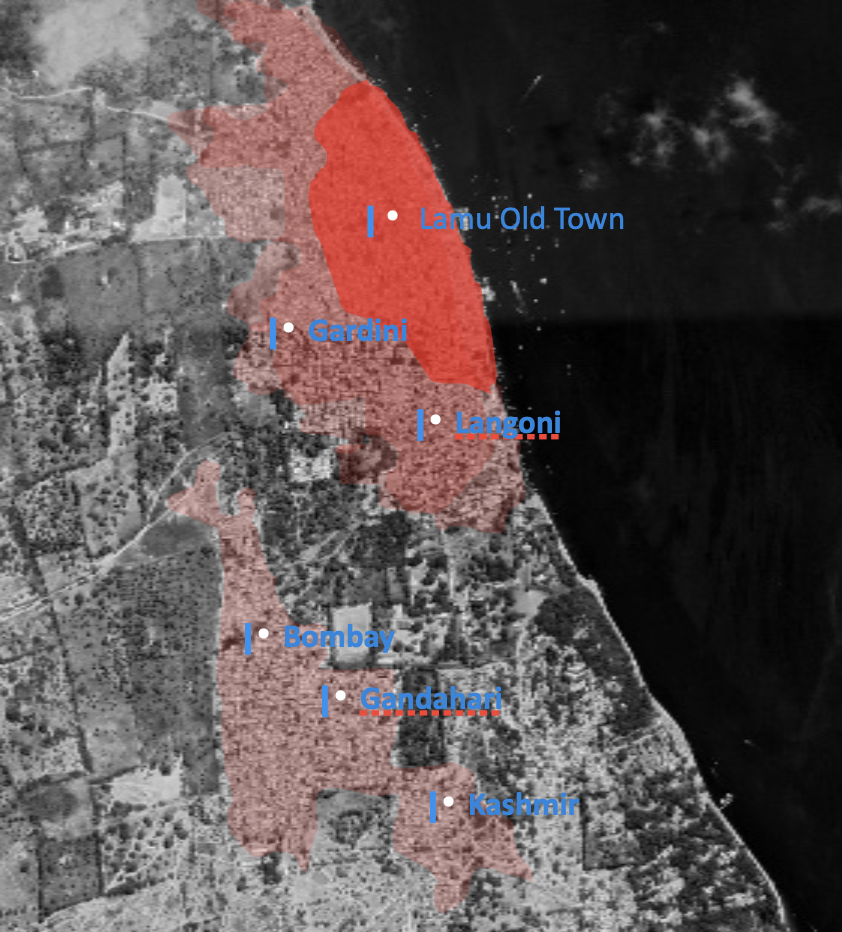 Lamu old and new neighborhoods boundary in 2003
Lamu old and new neighborhoods boundary in 2003However, stone houses still symbolise social status and lineage, providing a sense of permanence and privacy within Swahili culture. These stone houses did not arise from an ideal prototype but rather evolved through the amalgamation of materials and practices by various homebuilders over time. They emerged due to the blending and referencing of the existing tradition of using coral stone for the houses of the merchant elite, as art historian Prita Meier has shown.
The same architectural styles persisted in Lamu for centuries in both towns and houses, characterised by a significant contrast between stone and mud constructions. Lifestyle disparities between the stone and mud towns were evident in the character of the main street, with Langoni displaying a higher density of shops that gradually decreased in number but increased in size as one moved closer to the area of Mkomani.
What changes in spatial organisation, if any, have occurred with this growth?
The new areas, with their regular plot sizes of 30x40 feet, feature new house types. At the same time, many factors influencing the organisation of domestic space remained relatively unchanged in Lamu over centuries. The same construction methods, materials, climate, and plot size continued to shape its domestic culture. However, there were significant shifts in women’s expectations, comfort, and need for seclusion and privacy, and these have become more pronounced in recent decades.
Women & domestic culture
Exploring women's perspectives within Lamu’s evolving domestic culture builds upon feminist approaches to architecture and urbanism. These studies displaced the predominantly masculine lens of previous scholarship, which often reproduced patriarchal conceptions of dwelling culture and urban development.
Dwelling undergoes a natural evolution as inhabitants personalise their homes to align with their preferences and actively adapt their living spaces, fostering a sense of accomplishment, self-expression, and autonomy. The concept of home gradually takes on deeper dimensions, intertwining with a profound sense of belonging, cherished memories, and past life encounters. The presence of relationships, residential history, familiarity, and established routines collectively cultivate the comforting feeling of being truly "at home."
Exploring women's perspectives within Lamu’s evolving domestic culture builds upon feminist approaches to architecture and urbanism. These studies displaced the predominantly masculine lens of previous scholarship, which often reproduced patriarchal conceptions of dwelling culture and urban development.
Dwelling undergoes a natural evolution as inhabitants personalise their homes to align with their preferences and actively adapt their living spaces, fostering a sense of accomplishment, self-expression, and autonomy. The concept of home gradually takes on deeper dimensions, intertwining with a profound sense of belonging, cherished memories, and past life encounters. The presence of relationships, residential history, familiarity, and established routines collectively cultivate the comforting feeling of being truly "at home."
Amid the numerous studies investigating various facets of dwelling, this research probes women's roles and practices as both agents of change and guardians of cultural heritage. By actively immersing ourselves in their everyday practices and negotiations with house builders, this study examines the evolution of domestic culture and explores how meanings and values associated with home have evolved over time.
Examining the intricate interplay among architecture, gender roles, and spatial dynamics reveals entrenched biases, the profound impact of gender on social and spatial constructs, and some unexpected consequences of urban development.
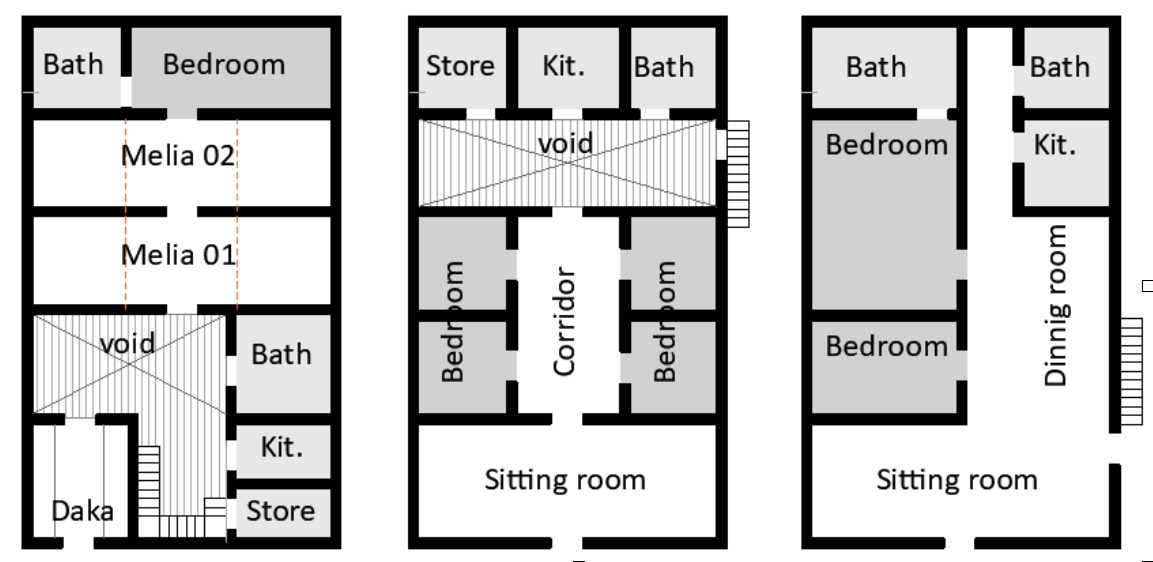
Typical Stone house (L), typical Swahili house from Kashmir and Langoni (M), and what so-called modern house from Melimani
Security Urbanism
What impact does securitisation have on the lived experiences of community members and on the region's future development?
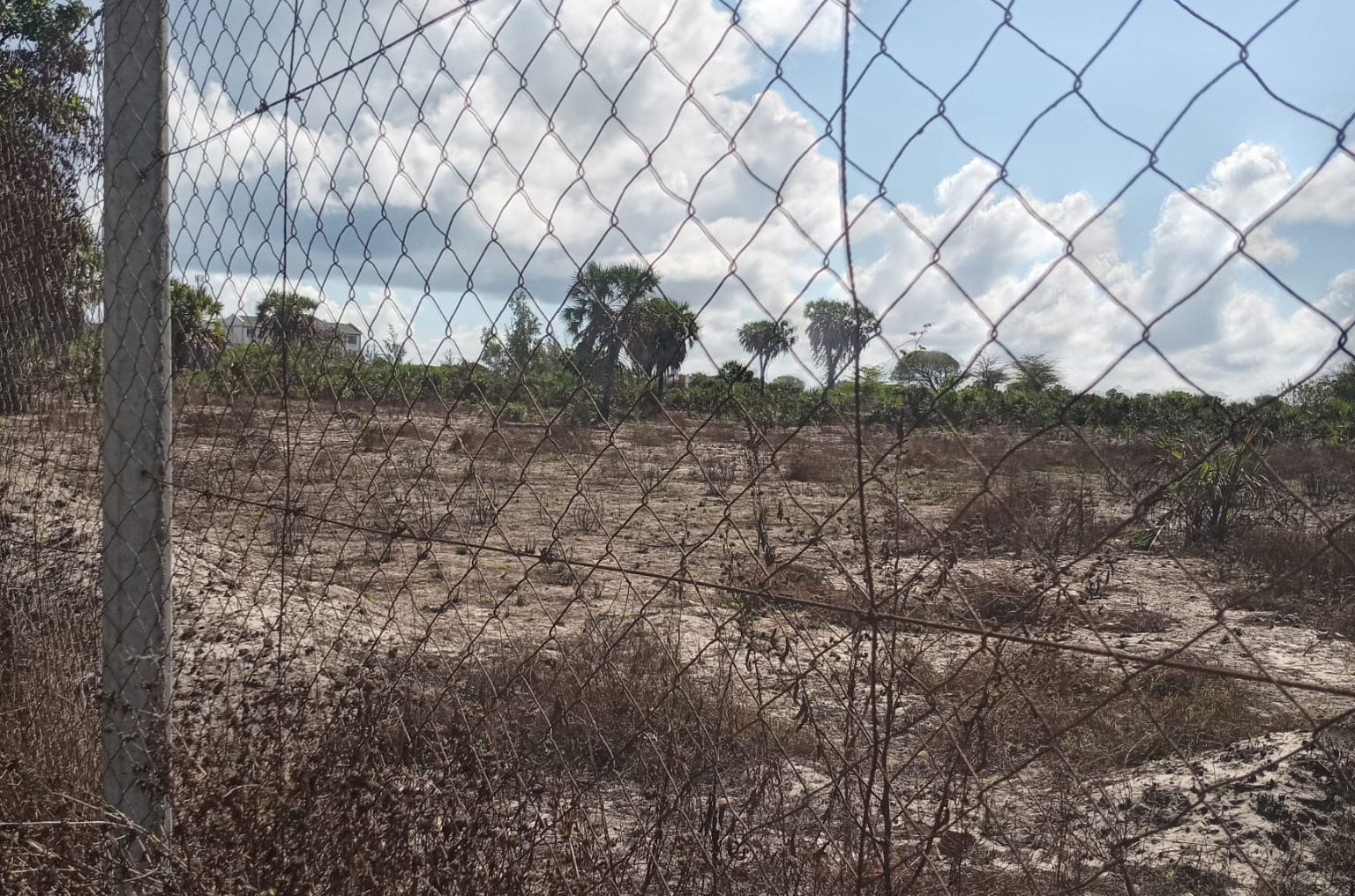
Given constant vigilance by government security agents in the wake of terrorist attacks, many people in Lamu County may feel more secure. Yet discrepancies in who is afforded safety should be addressed to assure inclusive development.
By engaging with the residents of Lamu, Shela, Manda, Mokowe, and Hindi, this theme aims to explore everyday perceptions of security and how it impacts property relations, social inequality, and urban development in the context of state-sanctioned securitisation.
By engaging with the residents of Lamu, Shela, Manda, Mokowe, and Hindi, this theme aims to explore everyday perceptions of security and how it impacts property relations, social inequality, and urban development in the context of state-sanctioned securitisation.
We emphasise the difference between security and securitisation, and the experiences of residents of the five above-mentioned areas regarding security, both personal and state-sanctioned, differently based on ethnicity, gender and other socio-economic factors.
Projects
Security Urbanism #2303
Security, and Urban
Al-Shabaab,
Security, and Urban
Development
The LAPSSET project has triggered significant development in Lamu County. Stretching across northern Kenyan counties and connecting six Western African nations, it promises to integrate remote communities into the global economy and drive regional economic growth. The project encompasses a new highway, railway system, crude oil pipeline, fibre-optic cable, and a partially operational 32-berth port in Lamu.
With this concentrated development in the region, the government has heightened its focus on security. Located on Kenya's coast, the region shares a porous border with Somalia, where the terrorist organisation al-Shabaab remains active.
With this concentrated development in the region, the government has heightened its focus on security. Located on Kenya's coast, the region shares a porous border with Somalia, where the terrorist organisation al-Shabaab remains active.
Terrorism remains contentious, leading to substantial government and research investments to prevent attacks. However, recruitment, manipulation, and weaponisation of Kenyan youth against their communities continue.
This research paper explores security concerns in Lamu County and residents' perceptions, especially in towns like Lamu, Shela, Manda, Mokowe, and Hindi, where LAPSSET development is significant. Our guiding question explores how securitisation influences daily life, property relations, and social inequality in a state-sanctioned securitisation context.
This research paper explores security concerns in Lamu County and residents' perceptions, especially in towns like Lamu, Shela, Manda, Mokowe, and Hindi, where LAPSSET development is significant. Our guiding question explores how securitisation influences daily life, property relations, and social inequality in a state-sanctioned securitisation context.
Securitisation and Community Concerns
To comprehend security issues in Lamu and LAPSSET's impact, we began by examining government priorities with Philip Oloo, Assistant County Commissioner of Lamu. His office coordinates security, conflict resolution, local security structures, and county-level national government functions. Philip highlighted tensions arising from religious and ethnic differences, competition for finite resources among farmers, herders, and pastoralists, and challenges tied to youth unemployment and lack of formal education, leading to social issues like substance abuse and petty crimes.
Philip mentioned a poignant example: "Pastoralists believe that anything green is for the animals to feed on." This simple statement encapsulates the conflicts that can arise from resource scarcity in the region.
Despite increased security measures, Philip pointed out existing vulnerabilities for illicit drug trafficking into Lamu: "We have closed but not managed land borders, open sea borders, and Bajuni communities straddling the Kenya-Somalia border, connected through marriage or involved in illegal drug trade."
While LAPSSET promises massive development, concerns linger due to the potential influx of people from diverse backgrounds, posing security challenges. Land issues within the context of the mega-project also raise apprehensions among locals.
Fate of the shephard
Dagane Diriyi, chairman of the pastoralist association in Hindi, echoes these concerns. New infrastructure construction constrains grazing areas for animals, and despite appeals, the county government has not allocated land to pastoralists. They face harassment near the port when using private grasslands.
However, Dagane is optimistic about the pastoralists' future and believes the port will bring positive change and economic opportunities to Lamu County. Yet many residents fear that job creation and investment earnings benefits may favour "up-country" Christian people in Nairobi over Lamu's indigenous Muslim communities.
Feeling secure
Many in Lamu, Shela, Manda, Hindi, and Mokowe feel safer due to the government's response to al-Shabaab and LAPSSET's presence. Increased security measures and development improvements are evident and generally welcomed.
Khalifah S. Alwi, Chief of Mokowe, expresses optimism about Mokowe's transformation into a bureaucratic hub.
Khalifah S. Alwi, Chief of Mokowe, expresses optimism about Mokowe's transformation into a bureaucratic hub.
When he first arrived in Mokowe as assistant chief in 2007, the town had "no power, no electricity and no tarmac road," but is now the centre of power in Lamu County. "A lot of good changes are happening… Mokowe will become a second Dubai".
His office in the centre of town is flanked on all sides by the offices of the Kenyan Navy, Coast Guard and the General Service Unit (GSU), the state paramilitary force. Nearby, the Kenya Border Patrol Unit (BPU) and the Rapid Deployment Unit (RDU) are present, and in recent years, security forces and government ministries have established offices in the town owing to its proximity to the port.
Hopes of a working mother
Salma Begum, a quarry worker and long-time resident of Manda Maweni, lives with her six children. Recalling her twenty years in the town, Salma notes that security improvements have occurred. In the past, al-Shabaab attacks in nearby regions forced her to flee into the bushes with her family for days on end. Salma tells us those threats are few and far between now. Still, the presence and availability of drugs and excessive alcohol consumption leave the youth in Manda vulnerable to delinquency and school dropouts, making them ideal targets for inducements and potential radicalisation.
With regard to the development of Manda, Salma, like many others, sees the potential benefit of LAPSSET for the community. Salma believes the increased demand for coral stones from the quarry will surge and hopes that that will guarantee a sustainable income for the coming years.
With regard to the development of Manda, Salma, like many others, sees the potential benefit of LAPSSET for the community. Salma believes the increased demand for coral stones from the quarry will surge and hopes that that will guarantee a sustainable income for the coming years.
Salma also recognises that constructing roads and infrastructure will help people move to and from the town, thereby making business easier to conduct.
However, the project has also brought troubles. Village chiefs are accused of coaxing people to move away from the area "as the land is under private ownership." She also claimed that the KDF's Rapid Deployment Unit's (RDU) camp in Manda Maweni forcibly evicted people in the past to relocate high-ranking government officials. This seemingly ceased with the new government's election when the new Governor ordered the removal of the RDU camp.
However, the project has also brought troubles. Village chiefs are accused of coaxing people to move away from the area "as the land is under private ownership." She also claimed that the KDF's Rapid Deployment Unit's (RDU) camp in Manda Maweni forcibly evicted people in the past to relocate high-ranking government officials. This seemingly ceased with the new government's election when the new Governor ordered the removal of the RDU camp.
Vox populi: apprehensions
Malkia Anyango in Hindi voices concerns over land allocation to wealthy mainlanders and the port's impact on fishing. She laments the loss of breeding grounds and mangroves and is worried about changes in the village such landrabbing by wealthy elites.
About the port, Malkia went on to say: “As a fish trader, it affects me because the area where the fish used to breed is where the port is now. Now, there is no place for fish to breed. Secondly, they are cutting down mangroves, and the remaining area is also not allowed to be cut because it is small, and as the port continues, remember those mangroves will be cut. So, as a fish seller, I will be left without fish, and those who depend on mangroves will also suffer... 200,000 shillings now; what kind of money is that? If you are given 200,000 shillings, you are no longer allowed to go into the sea. If you're caught, you'll be fined or imprisoned. Is that fair?”
We thank you for your service
An army sergeant stationed in Lamu County credits increased security measures and roadblocks with deterring terrorist activities. Militarisation along the highway is evident, with checkpoints approximately every 20 kilometres. While some individuals face scrutiny at checkpoints, others are ignored, and ethnic profiling occurs.
The sergeant emphasises land issues and the need for local education to combat radicalisation. He acknowledges the presence of the US military in Camp Simba but refrains from personal opinions while citing the camp's use for joint training exercises and crisis response.
The sergeant emphasises land issues and the need for local education to combat radicalisation. He acknowledges the presence of the US military in Camp Simba but refrains from personal opinions while citing the camp's use for joint training exercises and crisis response.
Given the geographical significance of Lamu, the prevalence of violence in the region, and Lamu's porous borders with Somalia, the presence of the US military in Lamu County is significant. The sergeant mentions Camp Simba, a Kenyan army base at Manda Bay utilised by the US army to train new recruits. As recently as 2020, the base was attacked when al-Shabaab militants led an assault on the Manda Bay airstrip, used by the US and Kenyan counterterrorism forces.
Al-Shabaab
Many in Lamu see the 2014 massacre by al-Shabaab in Mpeketoni, a fertile farming town in Lamu County, as being rooted in land injustice and social inequality. Nearly 50 people – all non-Muslim, non-Bajuni – were murdered at the hands of terrorists. While they claim it was due to the Kenyan incursion of southern Somalia and the killing of Muslim clerics under suspicious circumstances, it is widely believed that al-Shabaab took advantage of the alienation, disaffection and dissent of Kenya’s Muslim community.
This was not only to radicalise local populations and inflame domestic terrorism but also to displace those who have unfairly acquired their land, to reassert their identity as the minority whose rights have been taken away by the ‘outsiders’. Following bouts of electoral violence, local grievances with the influx of internally displaced persons (IDPs) have also made the population more susceptible to anti-government sentiments.
